

The Perfect 2 to 3 Days in Frankfurt Itinerary
Last Updated on February 8, 2024
by Paola Drexler
Disclaimer: This article contains affiliate links. That means if you click a link and make a purchase, we may make a small commission. As an Amazon Associate we earn from qualifying purchases. For more information, see our privacy policy.

As the fifth-largest German city, Frankfurt is the perfect place to get the right dose of history, culture, beauty and lots of delicious food. If you’re looking to plan a 2 to 3 days in Frankfurt itinerary, we’ve got an excellent resource for you.
So let’s eat some high-quality frankfurters while we explore the “Mainhattan” of Germany along the Main River and experience all that Frankfurt has to offer. Let’s dive into your next adventure in Germany.
Table of Contents
How Many Days in Frankfurt?
As one of the biggest financial and flight hubs, you may have had a layover or transfer in Frankfurt before. However, the city has so much to offer that it deserves its own trip to explore the city properly. But you might be wondering how many days to spend in Frankfurt to do the city justice.
There is so much to see and you probably don’t have a lot of time to spare, but luckily most attractions are within walking distance from each other.
2 days in Frankfurt is the perfect amount of time to see all the main highlights with some additional adventures that will leave you feeling like you got the full city experience.
However, with 3 days, you can explore some parts of the town that the locals enjoy as well, for example, a visit to the city forest or down the scenic Berger Straße. Alternatively, enjoy additional world-class museums and finish the day with a visit to the English Theatre.

Getting To & Around Frankfurt
No matter your preferred mode of transportation, Frankfurt is easily accessible whether you’re flying, driving or catching a ride some other way.
You can reach Frankfurt from many European cities like Copenhagen , Hamburg , Berlin or Munich by train. Frankfurt Train Station is located in the centre of the city and you can walk to many points of interest from there. You can view train schedules here .
For those flying in, Frankfurt Airport is the closest airport. Of course, other alternatives include airports in Hahn (which is usually the Frankfurt airport of choice for budget airlines), Cologne , Stuttgart and Dortmund, although the latter airports are over 2 hours away.
Once you arrive at the airport, you can decide on riding a train, bus, renting a car or a private transfer to get you to the city centre. It is a roughly 20-minute ride to get there.
If you are planning to use public transportation, it is straightforward and easy to navigate in Germany. You’ll have to get either a single-ride ticket or a Frankfurt Card at the train or bus station.
The Frankfurt Card has the added bonus in addition to the unlimited public transportation, that you’ll receive free entry or discounted prices at main attractions and restaurants in Frankfurt.

2 to 3-Day Frankfurt Itinerary
With the highest population in the state of Hesse, Frankfurt has seen countless visitors from every corner of the world. The city has endured so many centuries of historical events, war after war it has been rebuilt to bring together the old and new parts of the city to become what you’ll see today.
If you want to see some of the below sites with a guide, you can book a guided walking tour here.
Day 1 – Innenstadt, Old Town & New Old Town
In a city filled with old and new stories, you can find numerous things to do. For those interested in finance, Frankfurt can feel like a scavenger hunt as you look for significant landmarks, like the Euro sculpture or the famous Bull and Bear in front of the city’s stock exchange.
Your journey will begin at the Euro-Skulptur on Willy-Brandt-Platz and after having a look at the sculpture you’ll head up to the Alte Oper.
Starting in the Innenstadt, or inner city, you’ll begin the first day of your Frankfurt itinerary with the impressive concert hall known as the Alte Oper.
The Old Opera House was originally built in 1880 but after getting bombed and destroyed in 1944, it had to be rebuilt. The new larger hall opened its doors again in 1981.
Right in front of the opera house, you’ll find the Opernplatz (Opera Square), where you have a great view of the Alte Oper and tall buildings in the Bankenviertel (Banking District). The classical opera building contrasts sharply with the metal and glass of the downtown skyscrapers, making this a very unique square.
As you make your way deeper into the inner city towards the Hauptwache, you’ll walk passed numerous restaurants and luxury shopping stores.
If you take a little detour you’ll come across the Eschenheimer Turm, the late Gothic tower that used to serve as the city gate and is now a landmark. Our next stop is the Hauptwache.

You’ll know when you reach the Hauptwache not only because you’ll spot St. Catherine’s Church and the magnificent skyline but seeing one of the most famous plazas in all its glory can stop you in your tracks.
The Hauptwache building used to be a prison that was later turned into a police station and is now a restaurant that serves traditional German dishes.
In the plaza, you’ll see the big Galeria Kaufhof, the largest department store in the city, that houses many well-known brands, shops and more.
You can take a lift or stairs up to the roof terrace in the building to get a stunning view of Frankfurt. While worth a quick peak, don’t spend too much time here admiring the view – you’ll get an even better bird’s eye perspective later on in the day.
For now, enjoy walking down the famous and fabulous Zeil Street that’s lined with shops of all sorts. If you’re looking to do some shopping, for yourself or for souvenirs, here is your chance.

Kleinmarkthalle
When you’re done with your shopping, you’ll walk back towards the Hauptwache to the cute and historic Kleinmarkthalle.
Named for being a small market hall, the market is open every day except for Sundays. You’ll find all kinds of fresh food and flowers, as well as specialities from the area and even international delicacies. The market has been around since 1954 and has welcomed visitors and Frankfurters alike.
For the larger Erzeugermarkt Konstablerwache, located a few minutes away, you will have to double-check open times but you should be able to stroll through it on Thursdays and Saturdays.
As one of the most iconic German attractions, the Römerberg or Roman Mountain has seen its fair share of coronations, Christmas markets and tourists from all around the globe. Don’t worry though, the name is a bit misleading since the Römerberg is not really a mountain.
Located in the heart of Frankfurt’s Altstadt (the old town of the city), The Römer has been the city hall of Frankfurt since the 15th century and although receiving much damage during World World II, luckily the beautiful buildings were restored for people to enjoy today.
The half-timbered houses showcase beautiful German craftsmanship and are an iconic scene in Frankfurt.

DomRömer Quarter
Just a few steps away, you’ll come across a slight contrast to the historic old town in the “new old town” known as the DomRömer Quarter.
At first glance, the quarter looks very similar to the Römerberg, with a statue in front of the unique buildings. But then you see the contrast in colour and the modern build of the stunning buildings and realise you’re not in the same quarter anymore.
Since the war destroyed a large part of the old town, the reconstruction of the DomRömer Quarter, which was completed in 2018, was meant to modernise and liven Frankfurt up a bit.
St Paul’s Church
As you make your way from the Altstadt towards the Innenstadt, you’ll spot the round, architectural beauty of St Paul’s Church.
Having been the gathering place of the first freely elected German Parliament in 1848, the church is a unique spot with great historical significance for Germany.
Today you can tour the building, walk the circular lower floor, read about Germany’s history, and admire the beautiful art on the walls.
Goethe House and Museum
Just a short 5-minute walk from St Paul’s Church, you’ll see the marvellous Goethe House. This is the birthplace and former home of Johann Wolfgang von Goethe, one of Germany’s most famous writers who had a major impact on the German language – similar to what Shakespeare did for the English language.
The house became a museum in 1863 after being restored by the new owner to the way it was when Goethe was living there. Although it was destroyed during World War II, the house was reconstructed to its original form afterwards.
When you walk through the rooms where Goethe wrote some of his most famous pieces, you’ll walk along furniture from that period and can imagine what it was like living in the 18th century. In the museum, adjacent to the house, you’ll find a display of paintings that show Goethe’s life while in his family home.

To end your first day in Frankfurt, we’re going to end on a literal high note at the highest public viewing platform in the city – the Main Tower.
Even from ground level the 56-story blue glass skyscraper is extraordinary – it is the fourth tallest building in the city. For 9 euros per adult, visitors can take a lift up the 190 meters (623 feet) of the building to the observation deck but will have to walk up the last 10 meters of the way.
The last bit of walking is totally worth it when you reach the platform and have a breathtaking panoramic view of Frankfurt. If you time it out nicely, you can savour an amazing sunset.
Day 2 – Sachsenhausen & Plamengarten
On the second day, you’ll begin south of the Main river and across the Eiserner Steg (Iron Footbridge), on the other side of the city in old Sachsenhausen.
Straight out of a Brothers Grimm fairytale book with its medieval-looking houses, gas lamps and cobbled stone streets, this part of Frankfurt feels like an untouched, traditional German town. As you leisurely roam through the town, keep an eye out for brass-coloured apples within the cobblestones.
The state of Hesse prides itself on its Apfelwein production and history, so much so that apple wine – or cider – is considered the state beverage.
You’ll find some popular restaurants and taverns that serve it in Sachsenhausen, so if you’re feeling thirsty you can indulge in a glass or two of the local beverage of choice of over 250 years.
Museumsufer
If you’re a museum fanatic, look no further because you’ll find a nice lineup of museums right by the Main river in the area called Museumsufer or Museum Embankment.
The idea of building museums close to each other came from a cultural politician in 1977 named Hilmar Hoffmann.
On the South Bank of the river, you’ll find The Städel at the centre, which displays 700 years of European art and is one of the oldest museums in Germany. On the North Bank, museums include the Jewish Museum Frankfurt, the Historical Museum and other art museums.
Now we’ll cross the Alte Brücke once again, from the south bank to the north to walk along the Mainkai, the promenade alongside the river, and stop to take in the incredible view of the city’s skyline, river, Eiserner Steg and all of Frankfurt’s beauty.

Frankfurt Cathedral
As you make your way east on the Mainkai, then up Zum Pfarrturm, on the right pass the Dommuseum, you’ll reach the magnificent red gothic Imperial Cathedral of Saint Bartholomew, most commonly referred to as Frankfurt Cathedral or Dom.
Although it was never used as an actual cathedral, it was significant for holding former coronations and elections during the Roman Empire times.
Today, visitors can climb 328 steps to the viewing platform to get a different view from the city, closer to the river and old town. Inside, you can roam through the historical treasures and stories of its history.

Frankfurter Judengasse
After the cathedral, you’ll head up towards Domstraße and continue on Braubachstraße then Battonnstraße to reach the Museum Judengasse.
Frankfurt has two interesting and popular museums dedicated to Jewish history. The Jewish Museum is one of the oldest in Germany and is located down the Mainkai in the North Bank.
But today, you’ll take a closer look at the Judengasse, which was the location of the Jewish ghetto around 1462 to 1811. After enduring damage during the war, it was later demolished and rebuilt around 1987.
The museum opened in 1992 and you can still see a section of the original foundations. You’ll learn more about life during that time, Jewish history in the country and get to see historical art pieces while touring the museum.
Palmengarten
For an afternoon treat, you will either walk 35 minutes from the Judengasse or take a direct bus from Börneplatz to the enchanting Palmengarten.
The Palm Garden is a beloved attraction for everyone, not just tourists. Frankfurt loves its botanical gardens so much that it has three palm gardens in the city.
Close to the entrance of the garden, you will walk through a gorgeous rose garden, where you can stop and smell the luscious rosy fragrance in the air. Next, the garden houses a stunning palm house with tall palm trees, cacti, and other subtropical wonders.
With so much to look at, you can get lost for hours discovering new plants all over the grounds of the garden.

Day 3 – Stadtwald, Modern Art Museum, Berger Straße & the English Theatre
By now you’ve seen the main highlights in the city but there is so much more to do and see. Keep on reading for fun activities to do on your third day in Frankfurt.
If you prefer to head out of the city, you can take a day trip to Heidelberg instead.
As a day trip or if you’re headed back towards the airport, around the halfway point you can spend a few hours strolling around the Stadtwald (Frankfurt City Forest), which is around a 30-minute train ride outside of the city.
You’ll get to experience Frankfurt’s wildlife while walking by ponds and other bodies of water in the serene forest. To end your trip, you can go up the Goethe Tower in the northern part of the forest to have one last look at the breathtaking Frankfurt skyline from a distance.
Museum für Moderne Kunst
By now you’ve seen the main highlights in the city so you can sit back and relax – for example on a river cruise down the Main river – you can book one here .
While you’re near the river, you can go for a second round of museum exploration and visit one or two of the other museums on the Museumsufer that you’re interested in.
For example, the Museum of Modern Art displays unique pieces of art from the 1960s to the present date. You can find collections and individual artwork of artists from around the world, including Germany. If modern art is not for you, there are plenty of options to choose from.
Berger Straße
If you’re looking to explore the city more, you can walk down Berger Straße, your start point will begin at the cute clock tower, also known as the Uhr Turmchen.
Here you will find traditional German restaurants and special desserts like spaghettieis (don’t worry, it tastes better than it sounds and it contains zero tomato sauce or pasta).
On the Upper Berger Straße, you’ll also find more traditional apple wine gardens in dark wood buildings where you can get a glass of wine directly from the cellars where it’s made.
English Theatre
For an evening out you can enjoy whatever show is currently being held at the English Theatre in Frankfurt.
The theatre opened in 1979 and is well-known for ranking as the largest English-speaking theatre in Europe. When they aren’t performing musicals, they are performing anything from comedies and classics to thrillers.

Where to Stay in Frankfurt
Motel One Frankfurt-Römer – This hotel is an excellent option for mid-range travellers looking for a comfortable and hip place to stay in Frankfurt. Located in the Old Town of the city, there are several modern rooms on offer along with a bar and breakfast each morning.
Scandic Frankfurt Museumsufer – Those after a luxury option in Frankfurt are sure to love this plush hotel. Centrally located near all the city has to offer, there are plenty of large rooms, they’re pet-friendly, offer a fab breakfast each morning and some rooms provide kitchenettes.
Aparthotel Adagio Frankfurt City Messe – This aparthotel located in central Frankfurt is a great choice for those after their own fully-equipped apartment. They have a range of flats on offer and there’s even breakfast available in the mornings.
Not quite what you’re looking for? Click here to browse more Frankfurt hotels!
While it can be so easy to get lost in the city, spending 2 to 3 days in Frankfurt is the perfect amount of time to make you fall for the city. From its history to its beauty and charm, your adventures in Frankfurt will stay with you forever.
Are you planning to visit Frankfurt? Have any questions about this itinerary? Let us know in the comments!

Related Posts:

The Perfect 2 to 3 Days in Hamburg Itinerary

One Day in Heidelberg Itinerary: A Day Trip from Frankfurt

Munich or Berlin: Which German City to Visit?

About Paola Drexler
Paola is a writer for The World Was Here First. Originally from the state of Arizona in the USA, she lived in Germany before moving to the United Kingdom. Paola loves spending her free time travelling in Europe and sometimes ever further afield.
Great article for Frankfurt. We are going to the city in the end of April 2023.
Thank you for this Paola.
Leave a Comment Cancel reply
🙌 Awesome, you're subscribed!
Thanks for subscribing! Look out for your first newsletter in your inbox soon!
Get us in your inbox
Sign up to our newsletter for the latest and greatest from your city and beyond
By entering your email address you agree to our Terms of Use and Privacy Policy and consent to receive emails from Time Out about news, events, offers and partner promotions.
Awesome, you're subscribed!
The best things in life are free.
Sign up for our email to enjoy your city without spending a thing (as well as some options when you’re feeling flush).
Déjà vu! We already have this email. Try another?
Love the mag?
Our newsletter hand-delivers the best bits to your inbox. Sign up to unlock our digital magazines and also receive the latest news, events, offers and partner promotions.
- Things to do
- Attractions
- Restaurants
- Los Angeles

18 essential travel tips for every first-time Frankfurt visitor
Everything first-timers need to enjoy Frankfurt, from transport hacks to can’t-miss attractions to tipping faux pas

Germany’s most international city? Being an economic powerhouse’s economic powerhouse will lend itself to such a set-up, and Frankfurt doesn’t let the side down. Walkable, well planned, with brilliant public transport networks and the rest, Frankfurt is a city that is easy to get around and even easier to enjoy. Of course, visitors aren’t prioritising urban planning, and the restaurants , attractions and nightlife here are all worth celebrating. If you’ve landed here for the first time and feel a little lost, fear not, take these essential travel tips for first time visitors to Frankfurt to heart and settle in nice and easy.
RECOMMENDED: Full guide to the best things to do in Frankfurt Airbnbs in Frankfurt
Been there, done that? Think again, my friend.
Travel tips for first-time Frankfurt visitors
1. watch the calendar.

When planning your visit, keep an eye on Frankfurt’s events calendar. The city is home to an enormous exhibition centre, the Messe Frankfurt, which houses trade shows frequently throughout the year. Hotels can get booked up quickly around particular dates, and prices will shoot up, too.
2. Seat yourself

In most casual restaurants , you don’t need to wait to be seated. Simply find yourself a table and settle in; if there’s a sign saying the table is reserved later in the evening, just make sure you’re finished by the specified time.
3. Grab a MuseumsuferTicket

If you’re planning to fill your time with museum visits, it’s well worth buying a MuseumsuferTicket, which grants entry to 38 of Frankfurt’s museums for two days. Some of the city’s biggest museums are included, as well as some lesser-known gems. Family tickets are available.
4. …Or a Frankfurt Card

Another option is to pick up a Frankfurt Card (available for individuals or groups, for one or two days), which offers up to 50 percent off entry into to various museums, tours and attractions, and also includes travel on public transport, including to and from the airport.
5. Round up to tip

The Germans tip modestly, and it’s standard practice to just round up the bill for a meal by a couple of euros. Don’t leave change on the table, but include your tip when you pay: if your lunch comes to €15.50, you could hand over a €20 note and say, ‘17, please’.
6. Be red light aware

Frankfurt’s Bahnhofsviertel (the area around the main train station) has gentrified at high speed over recent years and is now home to some of the city’s trendiest bars and restaurants. However, it remains Frankfurt’s red-light district, home to dealers and addicts; if you want to avoid its grittiest bits, stick to Münchener Straße and Kaiserstraße.
7. Watch for bike lanes

Keep your eyes on street markings to stay out of the designated bike lanes that sometimes take up a portion of wider pavements. If you’d like to make use of them by cycling the city, try the Frankfurt Call A Bike service run by Deutsche Bahn.
8. Free museum days for kids

Good news for those travelling with little ones: there’s free admission to many of Frankfurt’s museums for under-18s on the last Saturday of every month (barring August and December). Known as ‘SaTOURday’, this family-friendly deal also includes free workshops and guided tours.
9. No-shop Sundays

Aside from the odd pre-planned ‘shopping Sunday’, most shops are closed on Sundays in Germany. As a visitor wanting to make the most out of a visit, this can be pretty frustrating, so remember to bear ‘no-shop Sundays’ in mind when planning your souvenir hunting.
10. Take a late-night taxi

In Frankfurt, public transport doesn’t run all night, and if you don’t want to download a ride-sharing app, you’ll need a taxi to get home in the small hours. These are an easily-spotted beige colour, and you can either phone for one, flag one down or queue at a rank.
11. Peruse the fleas

Fans of bargain-hunting will love the flea markets that take place on alternate Saturday mornings on the riverbank at Sachsenhausen between Eisernem Steg and Holbeinsteg, and at the Osthafen along Lindleystraße. Root through trash and treasure including clothes and furniture, books and records, paintings and crockery.
12. Avoid the Apfelwein hangover

Keen to try the local cider but wary of the infamous Apfelwein hangover? Try this Frankfurt speciality mixed with lemonade ( suß ) or soda water ( sauer ) for a fizzy version that won’t go to your head quite so fast (or hurt quite so much the next morning).
13. Don’t discount the craft beer

In Frankfurt’s traditional taverns, most locals will be happily imbibing Apfelwein (apple wine), but Frankfurt’s craft beer scene is growing slowly but surely.
14. Server swaps

At casual restaurants, pubs and cafés, it’s not uncommon for waiters to finish their shifts while you’re still in the middle of your drinks or meal. If you’re asked to settle the bill early, don’t be offended; you’re not being (un)subtly asked to leave, and a new server will take over.
15. Smiles aren’t standard

If you’re used to very friendly service in busy restaurants, you might find things a little brusque in Germany. But ‘impolite’ servers aren’t being rude to you because you’re a tourist, they’re (mostly) just being efficient and professional, even if it means service doesn’t always come with a smile.
16. Avoid Old Sachsenhausen

Alt-Sachsenhausen is home to a couple of great Apfelwein taverns, but for the most part, the area has a bad rep as a horribly touristy party zone. Locals prefer to avoid it, instead making a beeline to Sachsenhausen, where the atmosphere is considerably less drunken and chaotic.
17. Be wine-wary

When sampling Glühwein (mulled wine) at the Christmas markets, avoid the cheap-tasting sugary stuff by heading to the winery ( Winzer ) stands – there’s a cluster in front of the Schirn Kunsthalle. These offer Glühwein made with their own high-quality wines and whole spices, and they taste all the better for it.
18. Fall back on English

You won’t have any trouble getting by in English in Frankfurt. A guten Tag (good day/hello), bitte (please) or dankeschön (thanks a lot) will be appreciated, but Germans will most likely slip into English when they realise you’re not a local (which can be frustrating if you’re keen to practise your German!).
And if it’s tip-top mixology you’re after?
The 10 best frankfurt bars.

Breaking news: Frankfurt has shed its boring reputation. A steady influx of big business has transformed this city’s population and reinvigorated its art and nightlife scenes (hats off to Brexit). For tip-top drinks all night long, these are 10 best Frankfurter bars.
[image] [title]
Discover Time Out original video
- Press office
- Investor relations
- Work for Time Out
- Editorial guidelines
- Privacy notice
- Do not sell my information
- Cookie policy
- Accessibility statement
- Terms of use
- Modern slavery statement
- Manage cookies
- Advertising
- Time Out Market
Time Out products
- Android app
- Time Out Worldwide

1 Day in Frankfurt Guide (Frankfurt am Main)
This post may contain affiliate links. Read my disclaimer policy.
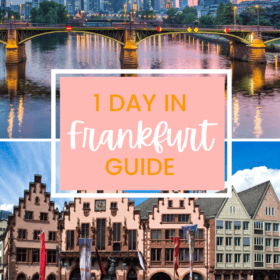
Only got 1 day in Frankfurt? Here’s how to plan the ultimate 1 day itinerary.
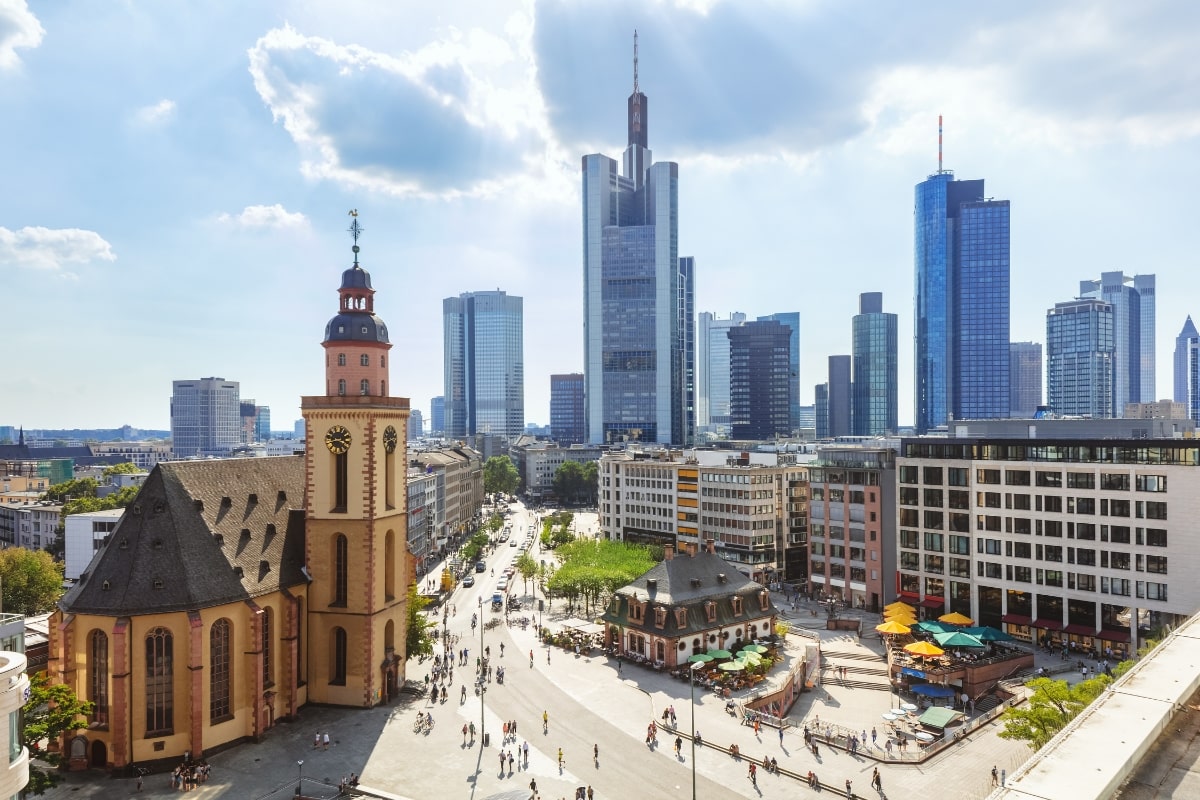
Although Frankfurt is mostly known for being the country’s main airport hub and a financial center for business trips, rather than a tourist destination, the lively city of Frankfurt is the gateway to Germany and an ideal place for easy travel connections and convenient day trips.
Frankfurt is the very first city I visited when I moved to Germany (well, I saw the airport and the train station!) but I didn’t return to actually explore the city for several years. I’d always thought of it as kinda blah but I wish I’d visited sooner because it’s a wonderful city!
Whether or not Frankfurt am Main is at the top of your list of German cities to explore, it’s worth considering a visit to one of Germany’s major cities.
Join our FREE Germany Trip Planning Facebook Group!
So if you ever find yourself in Frankfurt on a long layover or if you have an extra day or two before or after a flight, get ready to explore, because the city might just take you by surprise.
Keep reading to learn about the best places to visit in Frankfurt, Germany and how to plan the ultimate 1 day itinerary.
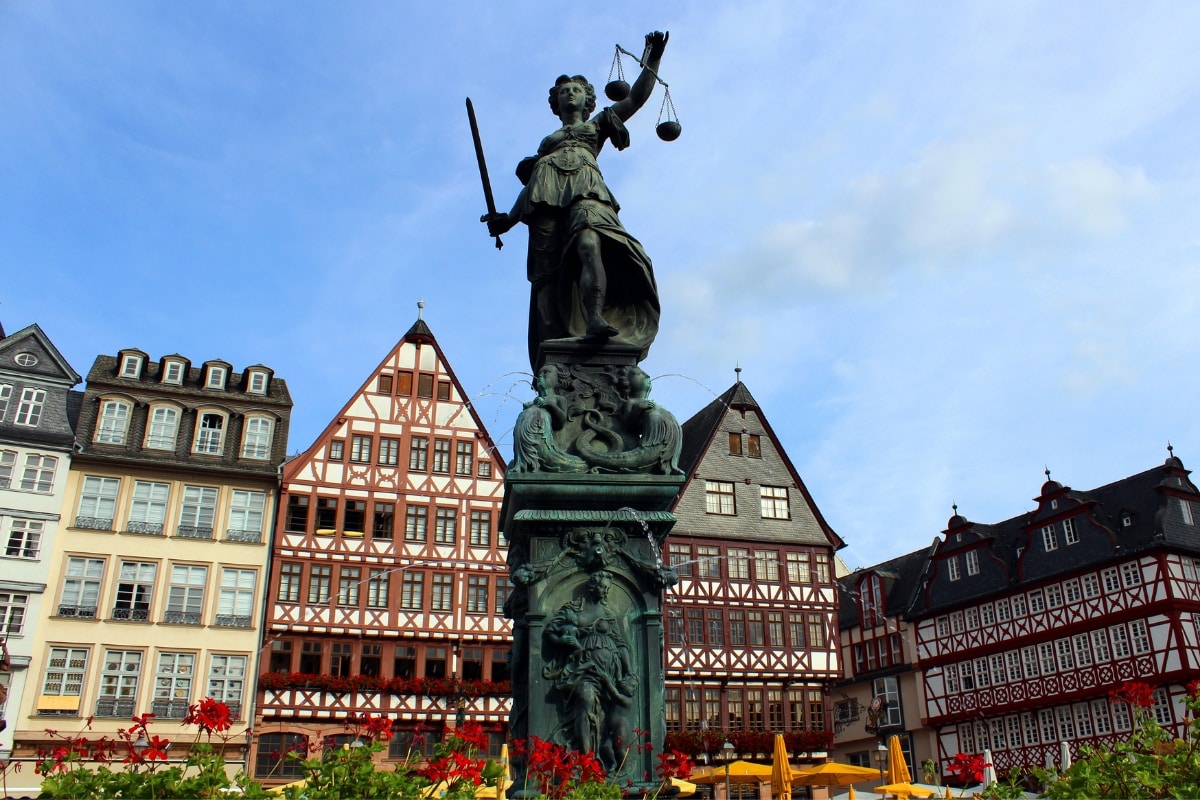
- 1 When to Visit Frankfurt
- 2 Frankfurt or Frankfurt Am Main?
- 3 How to Get to Frankfurt
- 4 Visiting Frankfurt Upon Arriving in Germany
- 5 The Best Way to Get Around Frankfurt
- 6 Frankfurt Card – Yes or No?
- 7 Frankfurt Guided Tours
- 8 What to Do In Frankfurt in 1 Day
- 9 If You Have 2 Days in Frankfurt
When to Visit Frankfurt
Summer is the most popular time to visit Germany in general and Frankfurt is no exception. Warm temperatures and long sunny days are perfect for vacation but they do attract tons of tourists, which translates to higher prices for airfare and accommodations. Air conditioning isn’t common anywhere in Germany but you’ll probably be spending most of your time outdoors by the river or in beer gardens in the summer months.
The changing of the leaves during the fall months bring cooler temperatures and golden views of the city. Prices begin to drop and crowds also begin to thin out. The weather in the fall is still pleasant enough for you to enjoy walking around the city.
The winter season is a great option if you want to celebrate the holidays by exploring the Christmas markets. But be prepared to brave freezing temperatures and rainy or even snowy days. An upside is that prices are usually at their lowest, especially after the holidays. And even though many people visit the Christmas markets, it doesn’t feel as “touristy” as it can in the summer.
The bad weather slowly starts to disappear once springtime arrives. Locals are happy to step out with just a light jacket and spend time outdoors as the gardens start blooming. One of the best times to visit would be in early spring, just before the summer peak.
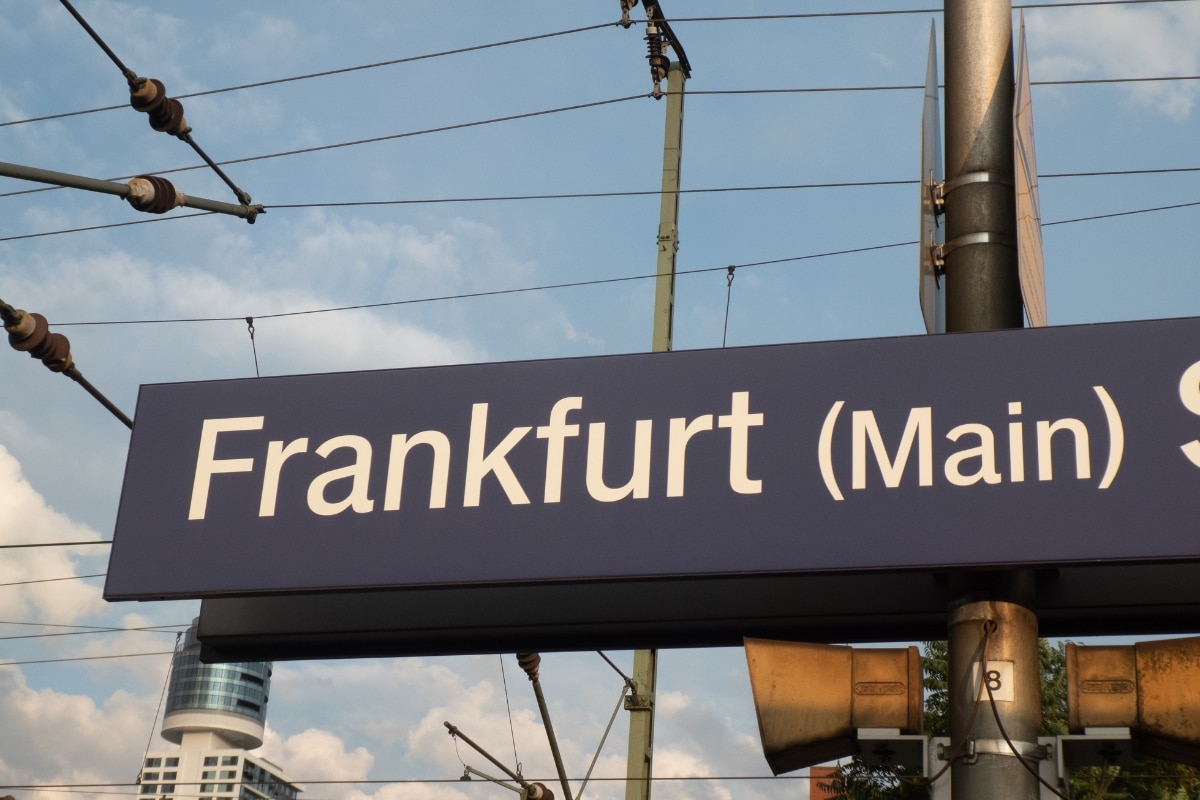
Frankfurt or Frankfurt Am Main?
You’ve probably seen the city referred to both ways. While most people simply call it Frankfurt, the city’s official name is Frankfurt am Main, meaning Frankfurt on Main. “Main” is the name of the river that flows through Frankfurt, so Frankfurt am Main means Frankfurt on the Main river.
The reason “am Main” is added to Frankfurt is because there’s another Frankfurt in Germany – Frankfurt an der Oder. Yep, that means Frankfurt on the Oder river. That Frankfurt is in eastern Germany, a couple hours away from Berlin on the Polish border.
Frankfurt am Main is much larger than Frankfurt an der Oder, so if you simply say Frankfurt, most everyone will know which one you mean.
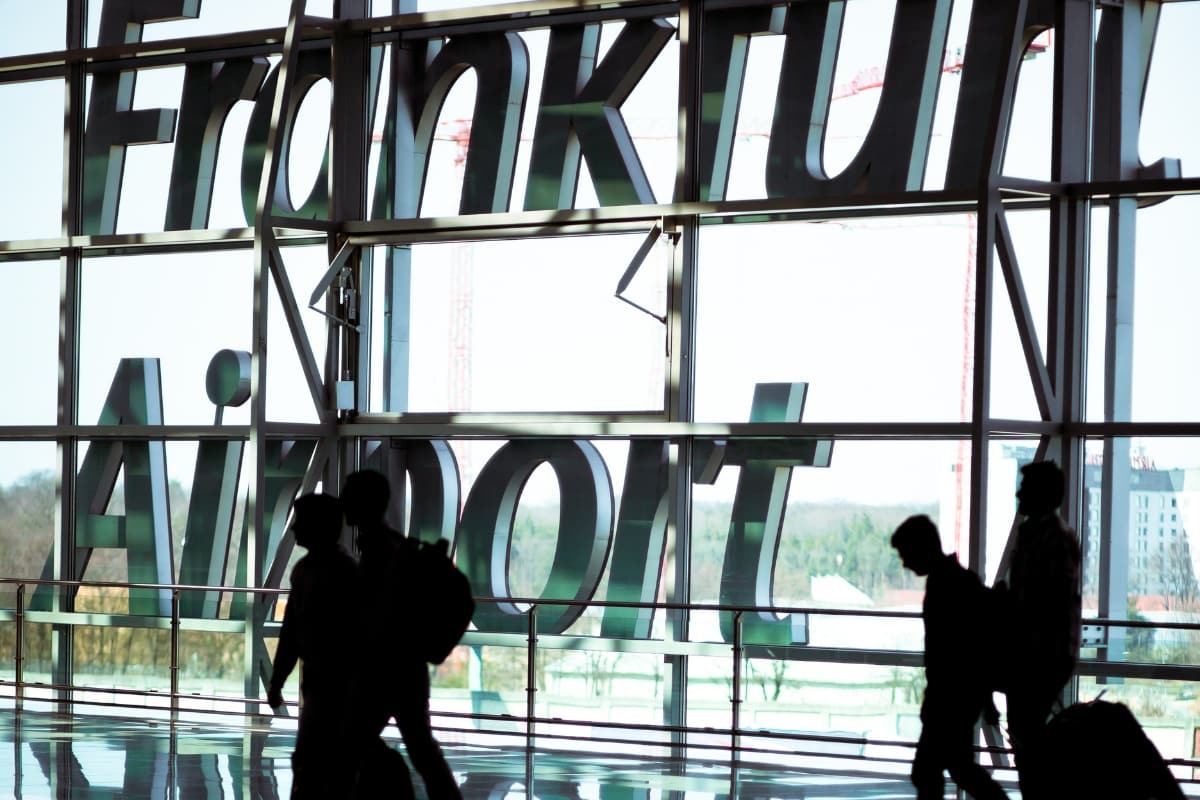
How to Get to Frankfurt
Home to Germany’s main airport and one of the busiest central train stations in Germany, Frankfurt is va well-connected and easy destination to reach.
Wherever you may be traveling from, it’s easy to find a good connecting flight to Frankfurt International Airport.
Getting from Frankfurt Airport to the main train station is a quick 15-minute ride via S-bahn. Getting to the city center is also just as easy and quick via public transportation. You can get off at the Hauptbahnhof (main train station) and walk or ride to a specific stop downtown.
Another great way to travel to Frankfurt is by train, especially if you’re coming from within Germany or other European cities in neighboring countries.
Grab our FREE Germany Trip Planning Checklist Now!
Visiting Frankfurt Upon Arriving in Germany
If you’re flying into Frankfurt overnight from the US and want to catch a train to your final destination, but are worried about missing your train – and losing the money you paid for your ticket – due to a potential flight delay, plan a 1 day visit to Frankfurt!
Take public transportation from the airport to Frankfurt’s main train station (Hauptbahnhof), store your luggage, and then explore the city until shortly before your train departs.
Walking around the city will stave off jet lag, you won’t lose money by missing your train and forfeiting your ticket, and you’ll explore a lovely new city.
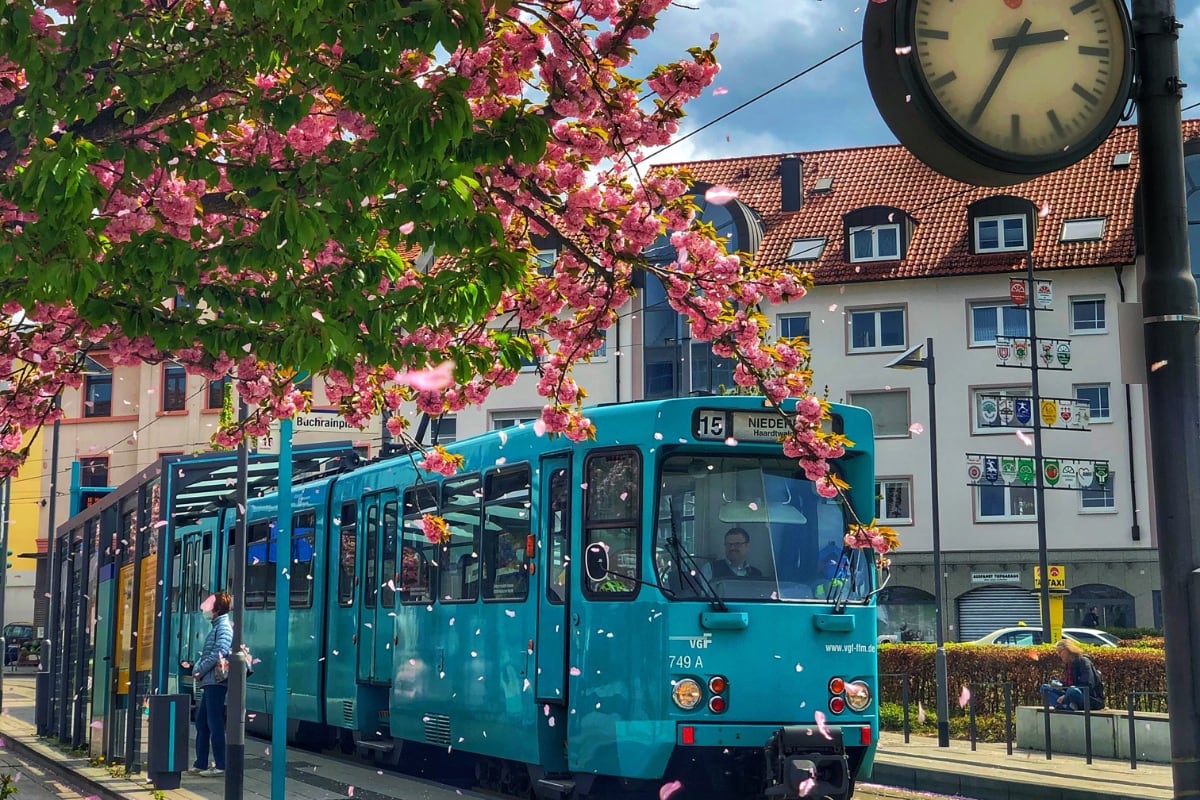
The Best Way to Get Around Frankfurt
Although Frankfurt spreads out in all directions, the inner city is pretty compact. On your visit, you’ll likely spend the majority of your time in the downtown or old town (Altstadt) area. You can easily reach historic Frankfurt and get to all sights in this area by walking from the train station.
For places that are a bit farther away, you can make use of the city’s public transportation which includes the U-bahn, S-bahn, trams, and buses.
If you’re only in the city for a day, going through the trouble of learning the transportation network might not be worth your time. In this case we suggest taking the Hop On Hop Off Bus tour since the bus routes bring you to all the best tourist attractions. For more information, head to the section on our recommended guided tours.
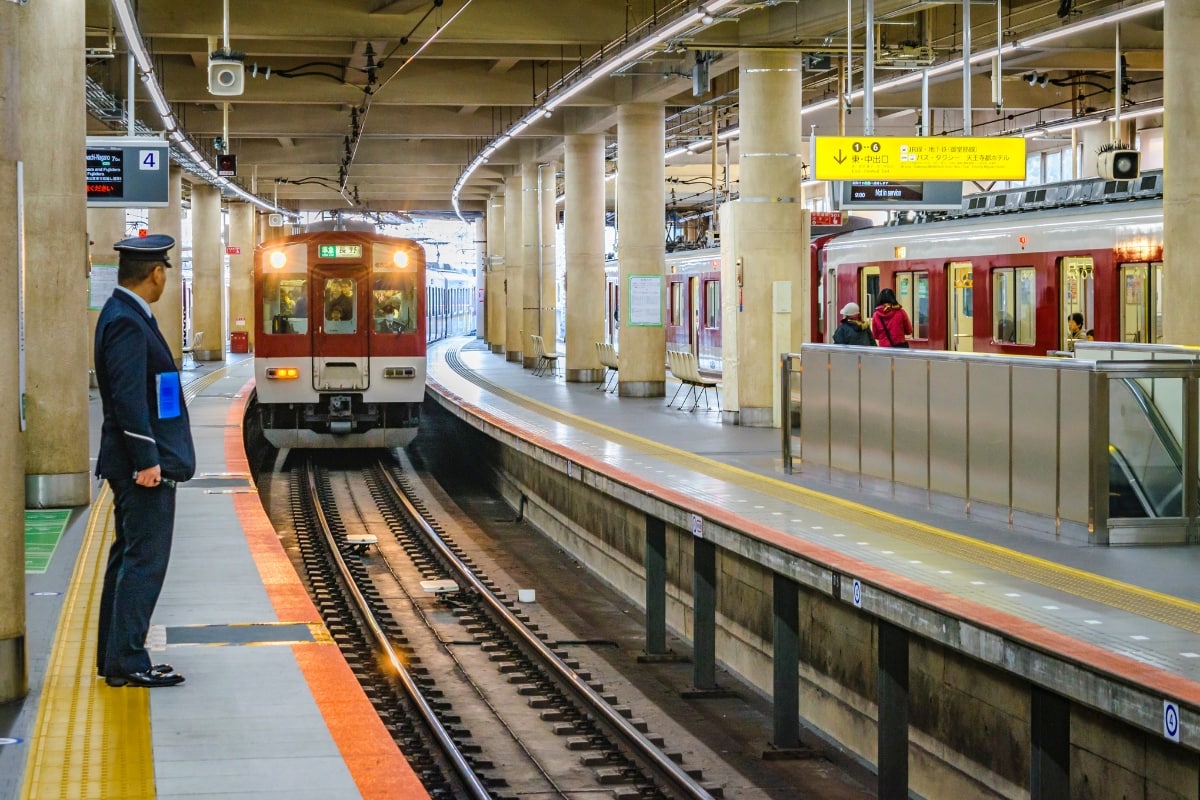
Frankfurt Card – Yes or No?
The Frankfurt Card offers you free unlimited travel on all public transport within the city of Frankfurt and Frankfurt International Airport (Zone 50 and Zone 5090). Not only that, it comes with up to 50% discount on select city tours, museums, restaurants, and other attractions.
The card is available for either one day (€ 11.50) or two days (€ 17.00). You can also choose between individual tickets or group tickets (3 to 5 persons). It’s a great deal but the question is – is it worth it for a 1-day trip?
If you’re mostly sightseeing in the downtown area, you might not get a lot of use out of it since you’ll be doing a lot of walking. But since it also includes transportation to and from the airport plus discounts on tourist spots, it’s worth looking into and deciding based on your itinerary.
All in all, we recommend buying your Frankfurt Card if you’re in the city for at least a day and a half to really make the most out of it. It’s especially worth it if you’re traveling as a group, since you can split the amount and avoid the extra cost of having to buy single tickets for every ride.
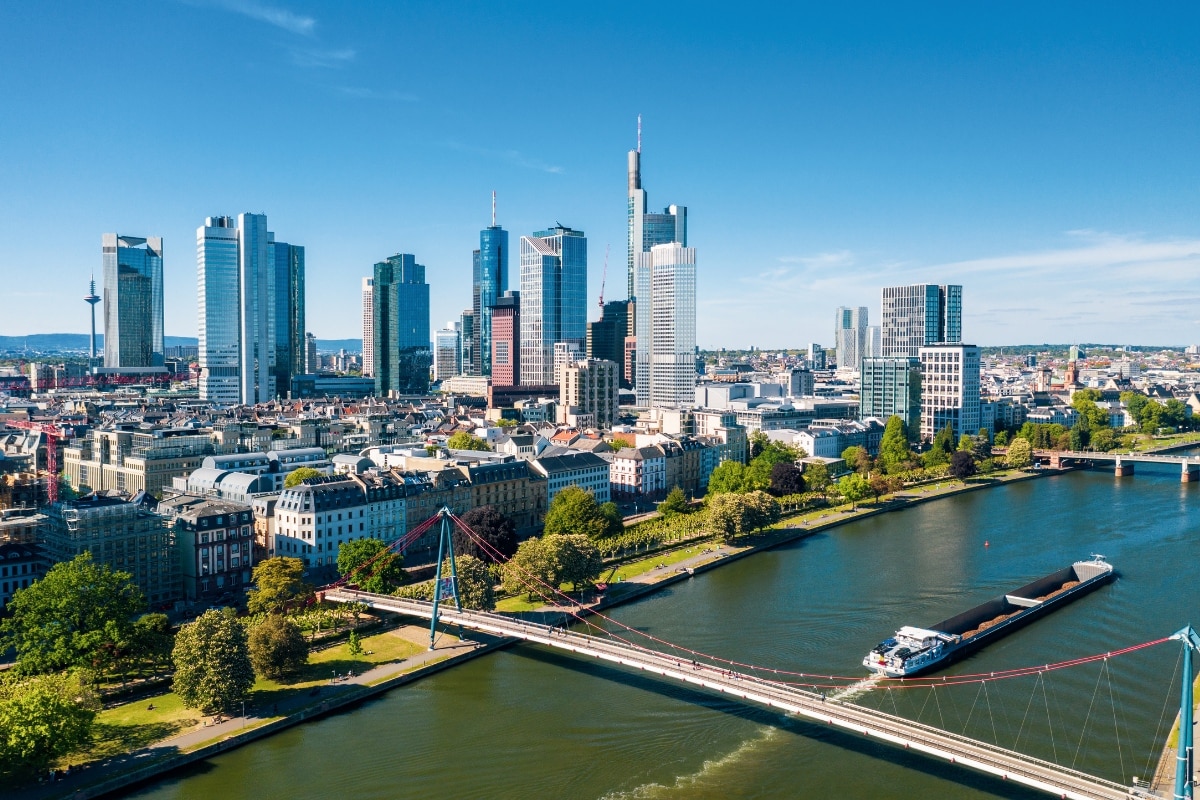
Frankfurt Guided Tours
Something that is definitely worth it for 1 day trips are guided tours. If you don’t have much time in a city the last thing you want to do is waste time arranging all the logistics and trying to find your way around.
The Hop On Hop Off Bus tour saves you the trouble of finding the best routes to get from one destination to another. Choose as many of the stops along the route to explore, all for the price of one ticket. Book your HOHO bus ticket here to discover Frankfurt at your own pace!
If you want to see the city from a different perspective, then book this tour that takes you on a cruise through the River Main . You’ll get great views of Frankfurt’s skyline while also passing through historical landmarks and neighborhoods. You can also choose between a 1-hour or 2-hour tour depending on how much time you have.
Want a more unique and personalized experience? Take this private tour with a local here! Upon booking, your guide get in touch and ask questions so they can customize the tour to your preferences. Get insider tips on the best places to eat, discover hidden gems, and experience the city like a true local.
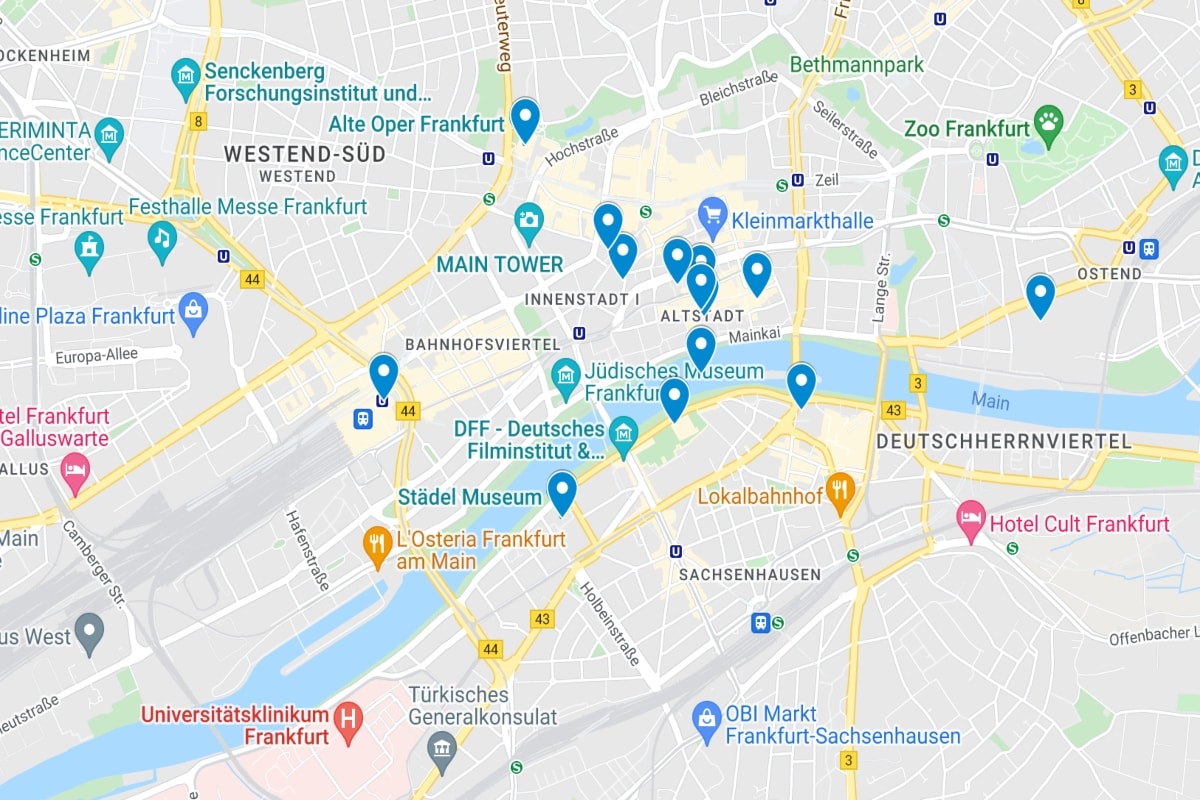
What to Do In Frankfurt in 1 Day
Here are several things you can do and see in Frankfurt. You probably can’t fit all of them into just 1 day but you can definitely see several.
Old Town (Altstadt )
There’s no better place to start your Frankfurt itinerary than Old Town. It’s home to some of the city’s most important landmarks like Römerberg, the central main square. In the middle of the square amidst all the restored medieval houses, you’ll also find the Fountain of Justice around which the Christmas Market is set up each year.
Frankfurt’s City Hall ( Rathaus )
One of the most important medieval buildings in the historic old town is Römer, the city’s town hall since the 15 th century. The three-story building complex with its three-gabled roof and consisting of nine houses makes up for one of Frankfurt’s most iconic façades.
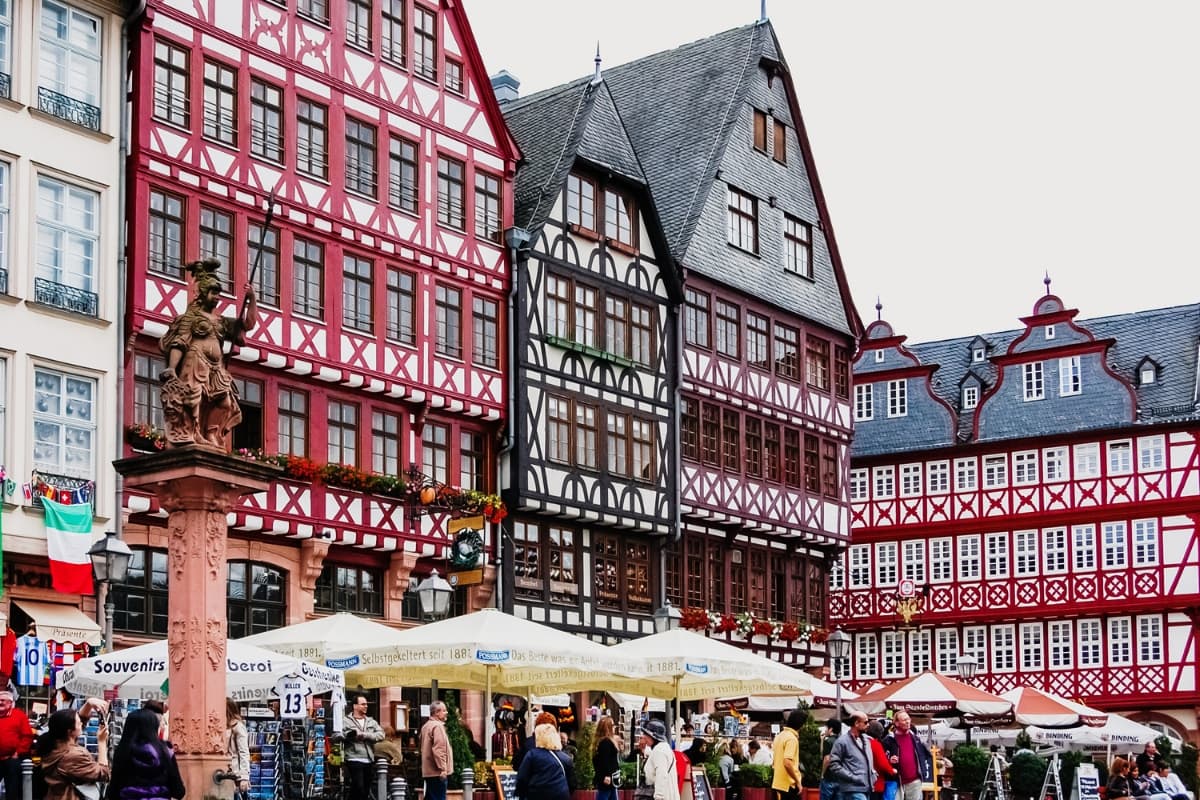
Frankfurt Cathedral (Frankfurter Dom )
A short walk away from the town hall, you’ll find the Frankfurt Cathedral, an impressive religious building with historical significance. This is also where coronation of emperors was hosted during the Holy Roman Empire. Visitors can also climb up the Gothic-style church’s tower and enjoy great views of Old Town.
Goethe House (Goethes Wohnhaus )
Take 5-minute walk from St. Paul’s Church to arrive at the birthplace of famous German author and poet Johann Wolfgang Goethe. Goethe lived here until the age of 16 and the preserved interior gives you glimpse into his youth. Next to the house, you’ll also find the Goethe Museum dedicated to his literary work.
St. Paul’s Church (Paulskirche )
Located opposite the town hall, St. Paul’s Church is an important symbol of German democracy. It was the seat of first German assembly in 1848 and in turn provided the basis for the German constitution. Now it’s a venue used for cultural events and award presentations.
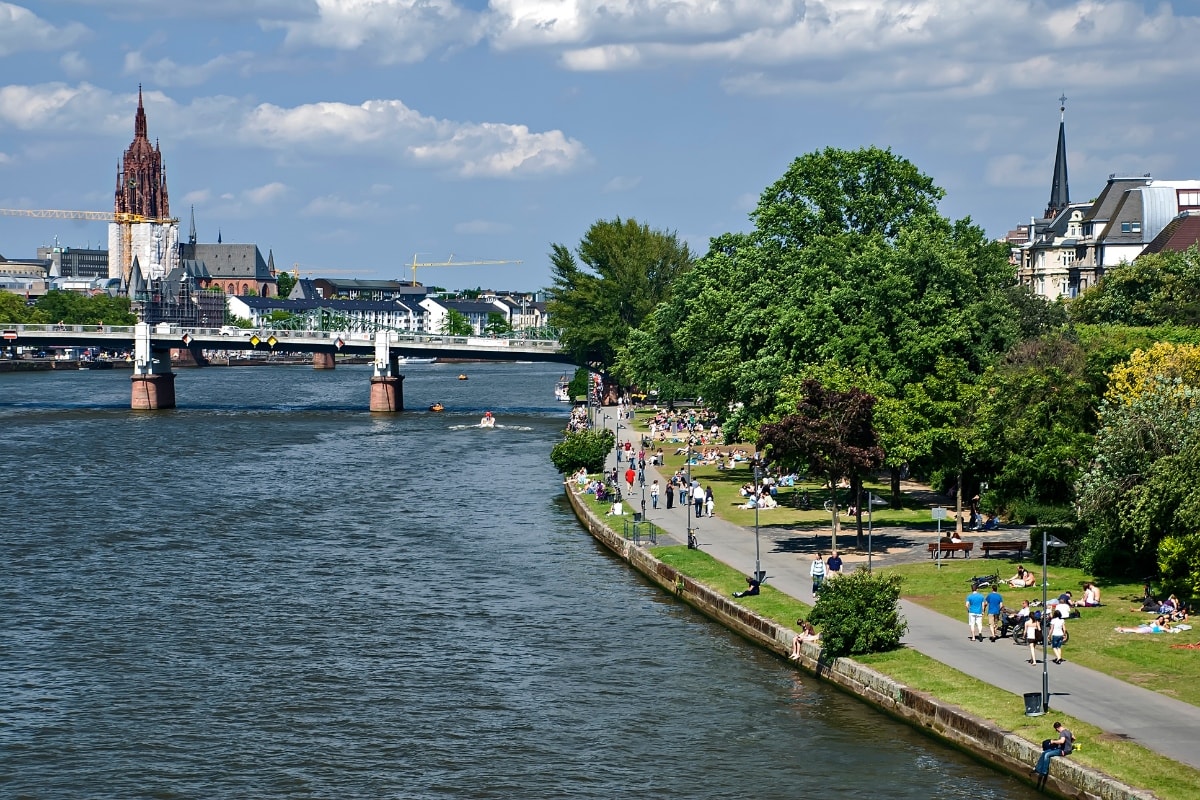
River Cruise on the River Main
Next, make your way down south to the Main river running through the heart of Frankfurt. If you want to take a break from sightseeing through busy streets, one of the best things you can do is stroll along the river banks and take in the city’s skyline.
To get an even better view of the skyline, you can take a river cruise departing from Eiserner Steg. You can book your ticket in advance here !
Iron Bridge (Eiserner Steg)
Eiserner Steg is one of the city’s most iconic landmarks and popular places to take photos against Frankfurt’s skyline. Aside from the views, you’ll also spot tons of love locks left on the bridge. Crossing the iron bridge from the city center brings you to Sachsenhausen, a fun district known for its vibrant nightlife and trendy restaurants.
Museum Embankment (Museumsufer )
The Museum Embankment is a group of museums lining both sides of the River Main. Some of the world-class museums located here include the Museum of World Cultures, Städel Museum, the German Film Museum, the Museum of Applied Art, and the Icon Museum.
If going to museums are a big priority for your travels, then they’re all worth visiting. But if you don’t have enough time for all, choose only one or two favorites to visit!
Städel Museum
The Städel Museum is known as Germany’s oldest museum foundation. This historical museum houses an impressive collection of over 700 years of European art from the 14 th century to Renaissance, Baroque, to early modern art. Highlights include masterpieces by Rembrandt, Monet, Picasso, and Vermeer.
Museum of Applied Art (Museum Angewandte Kunst )
On the other hand, the Frankfurt Museum of Applied Art is dedicated to contemporary art focusing on design, fashion, and performance. The alternating exhibitions aim to push the boundaries of aesthetics and the meaning of applied art. The museum’s architecture itself is a unique and experimental space that can be enjoyed with all the senses.
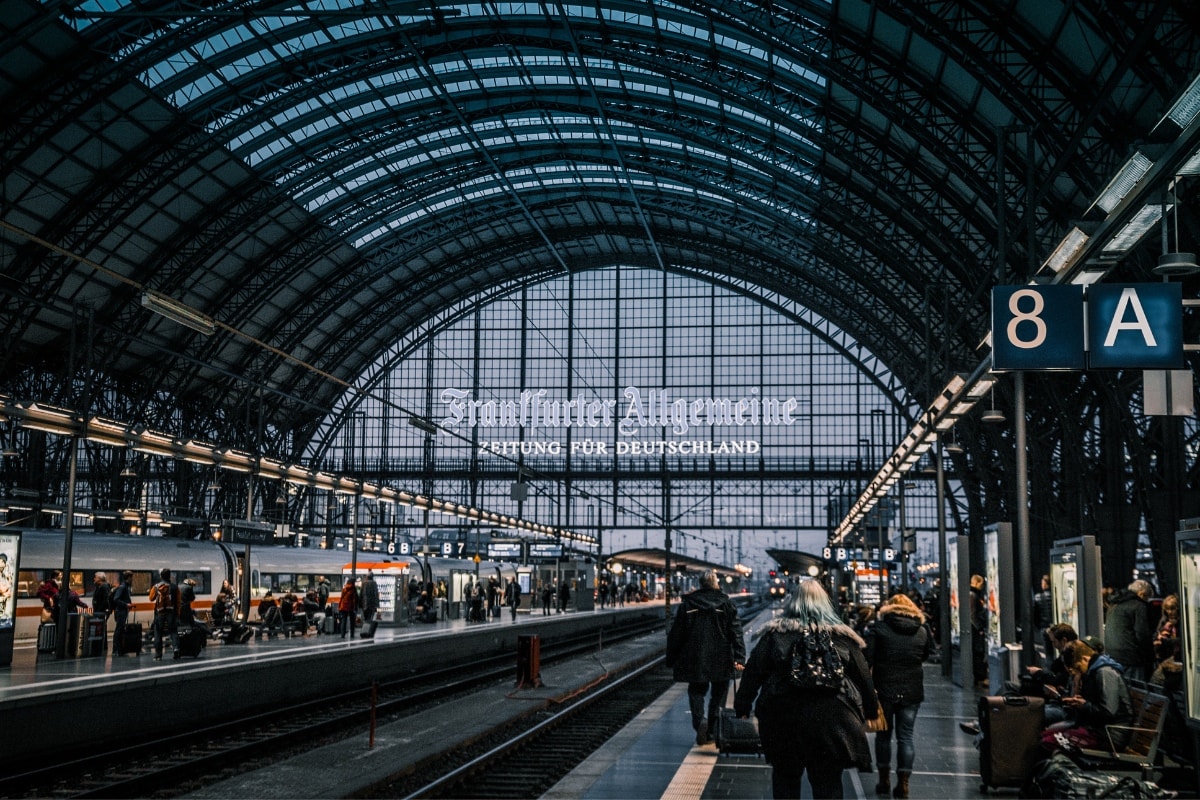
Main Train Station (Frankfurter Hauptbahnhof )
Frankfurt’s central train station is a major transportation hub for both short and long distance traveling, welcoming over 350,000 passengers per day. The station offers direct connections to major cities like Brussels, Paris, and Amsterdam. If you’re planning any other trips from the city, Frankfurt Hauptbahnhof will certainly offer you the best travel connections.
European Central Bank
The European Central Bank is the central bank of the 19 EU countries that use the Euro. As one of the most significant financial institutions in the world, they are tasked with maintaining price stability. Though a fairly new building, the European Central Bank is sure to become an important urban landmark and feature of the city’s modern skyline.
Old Opera House (Alte Oper )
For other tourist spots further out from Old Town, check out Alte Oper. The historic opera house was damaged in World War II but was rebuilt in the 1970s. Now, it’s a concert hall where visitors can watch world-class musical productions and concerts of various genres such as classical music, jazz, and blues.
If you don’t have a lot of time left to catch a show, you can visit their website to find out when they offer guided tours in English.
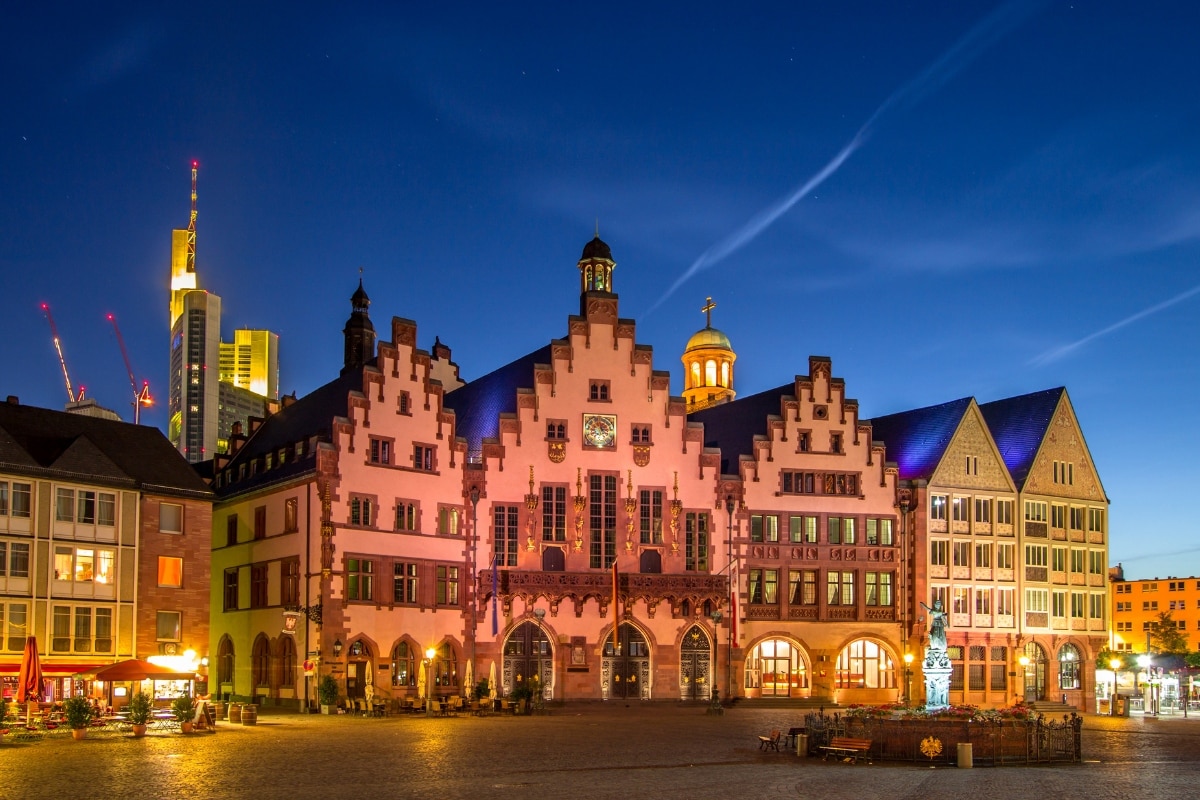
Frankfurt Christmas Market (Frankfurter Weihnachtsmarkt )
If you’re traveling to Frankfurt during the holidays then you’re in for a treat! The main market, Frankfurt Christmas Market is widely known as one of the oldest in Germany. Römerberg, at the heart of Old Town, transforms into a festive wonderland, complete with a vintage carousel, sparkling lights, and a giant tree.
The great thing about this market is that it stretches from in both directions. You can head south towards the river if you want a break from all the crowds. Heading north towards Paulsplatz you’ll find rows of stalls selling traditional handicrafts and souvenirs.
Go farther up to Hauptwach and discover even more food stalls. So grab your glass of Apfelwein (apple wine) , try Bethmännchen (Frankfurt traditional Christmas cookies) and enjoy the holidays!
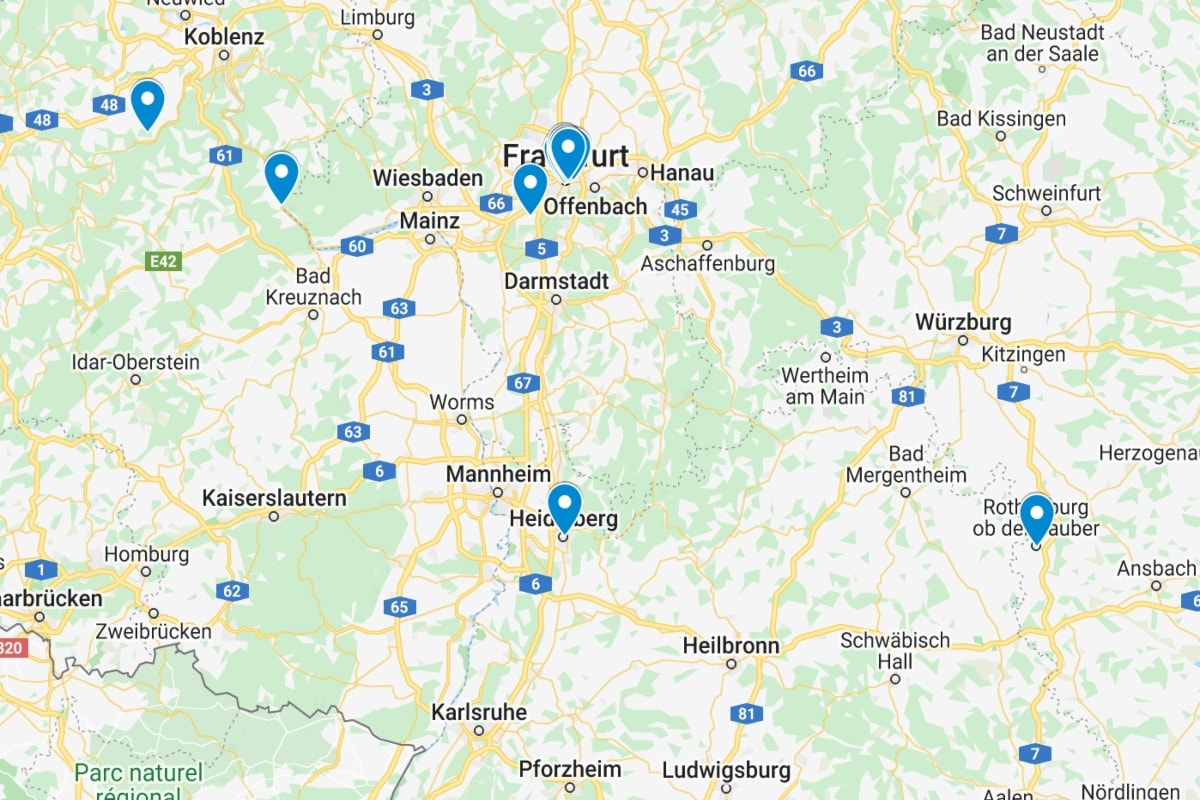
If You Have 2 Days in Frankfurt
Frankfurt’s central location and travel connections make it a great base for taking day trips , especially if you’re staying for more than a day. You can easily reach these places by train or let a guided tour take care of all the logistics.
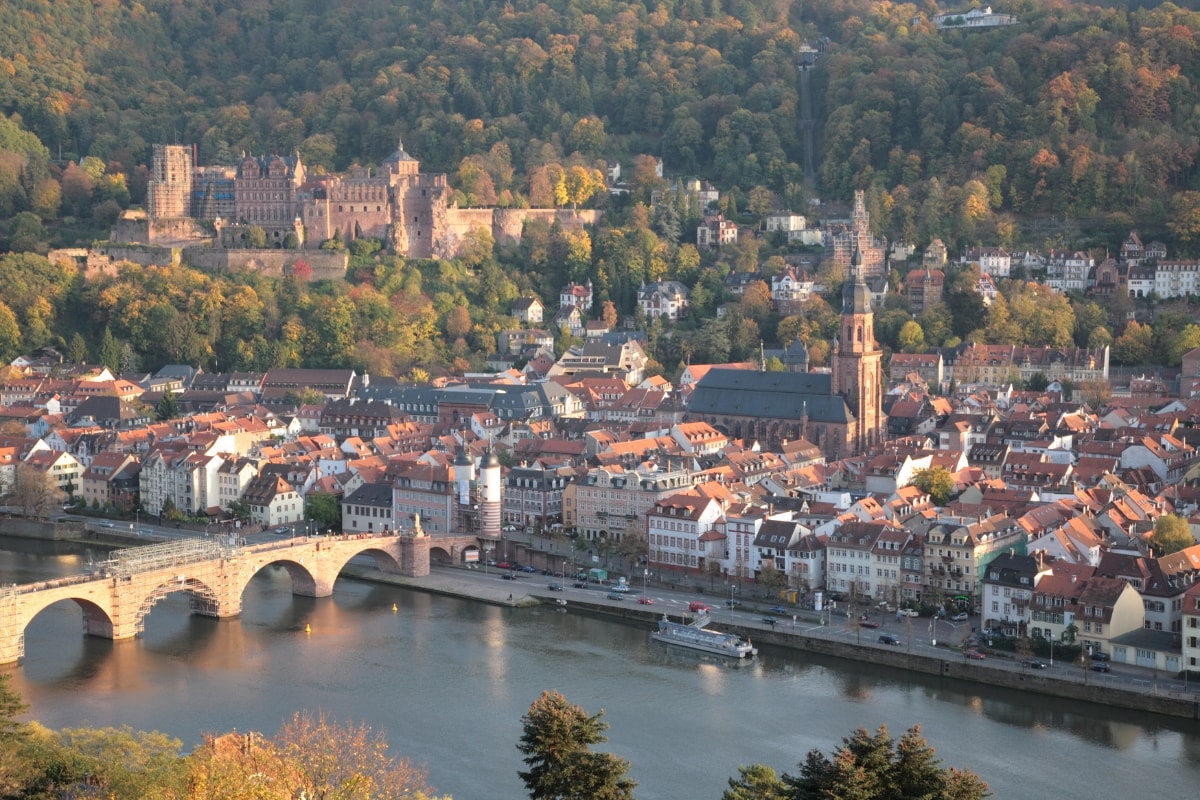
A new city you can explore from Frankfurt is the romantic city of Heidelberg. Situated along River Neckar, this beautiful city is home to the impressive Heidelberg Castle ruins and Heidelberg University, Germany’s oldest university. Fall in love with Heidelberg and book your tour here !
While in Heidelberg you can also drive through the Romantic Road in Bavaria to make your way to Rothenberg ob der Tauber, the best-preserved medieval town in Germany. This historic town feels like a step back in time, especially as you wander through the Castle Gardens and Old Town. To maximize your time, consider booking this tour that goes to Heidelberg and then directly to Rothenberg.
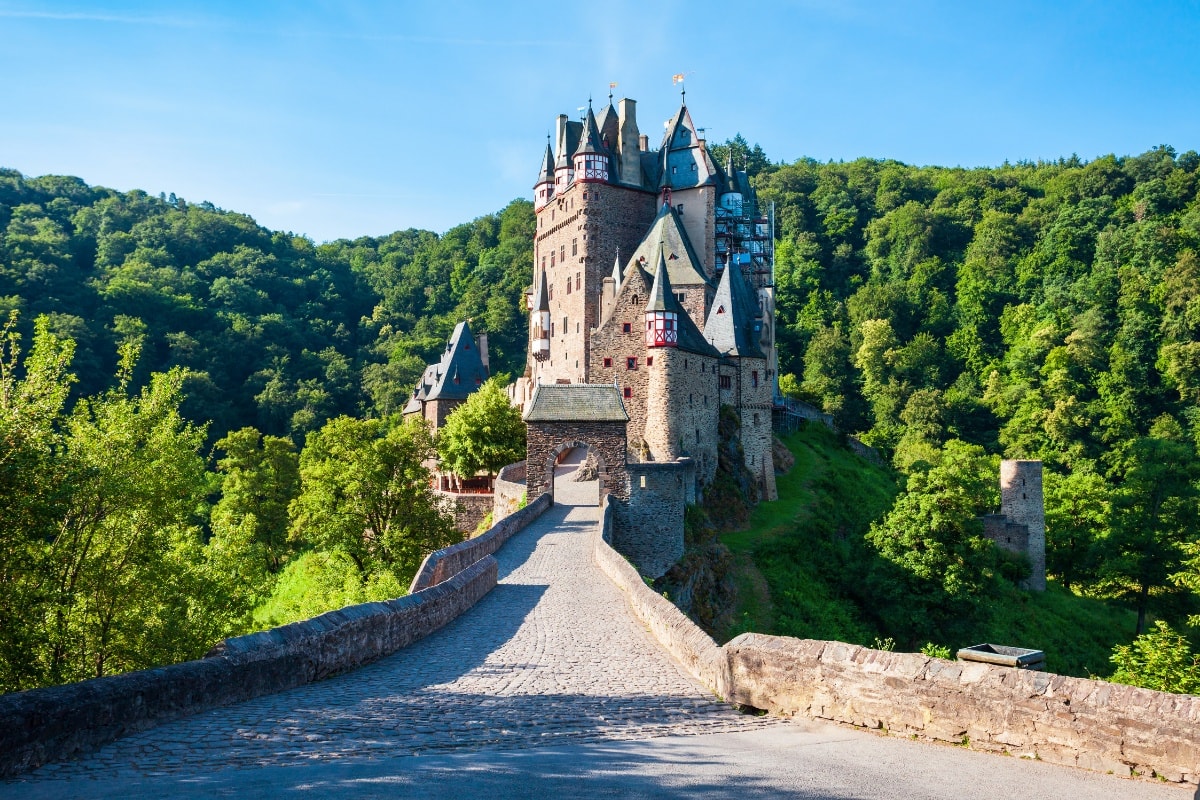
If you want more medieval Germany, take a day trip to Burg Eltz . This perfectly preserved castle overlooking the Moselle river has stayed under the same family since the 12 th century. Inside you admire knight halls and weaponry that take you back to the medieval ages.
The Rhine Valley is a great place to visit if you want a day trip packed with activities. Start by walking along the picturesque villages or wine tasting in vineyards in the hillsides. You can’t leave without taking a boat along the Rhine River to admire the landscape.
Then to end your trip, enjoy a cozy dinner by the riverbanks. Because of how vast the Rhine Valley is, we recommend booking a guided day trip here to see as much of it as possible.
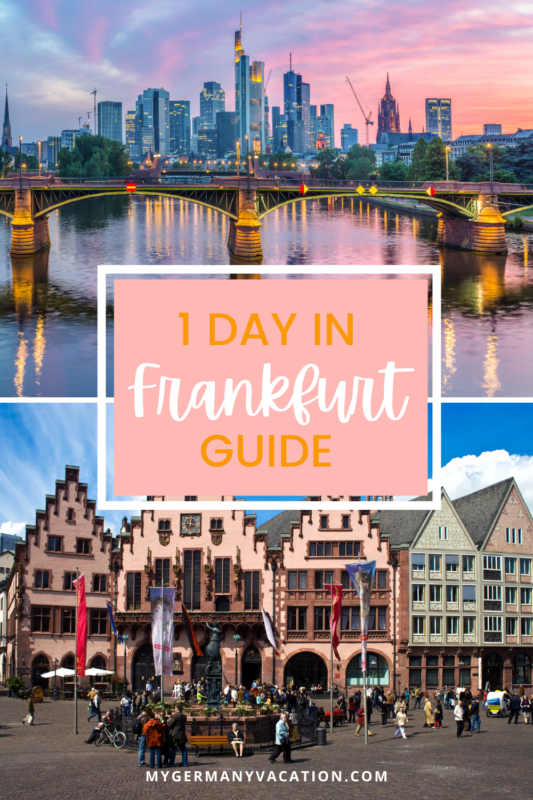
Cate has been traveling to Germany for 30+ years. She has lived in Germany, taught college German, and has a PhD in German Applied Linguistics. She loves helping travelers plan their dream trips to Germany!
Similar Posts
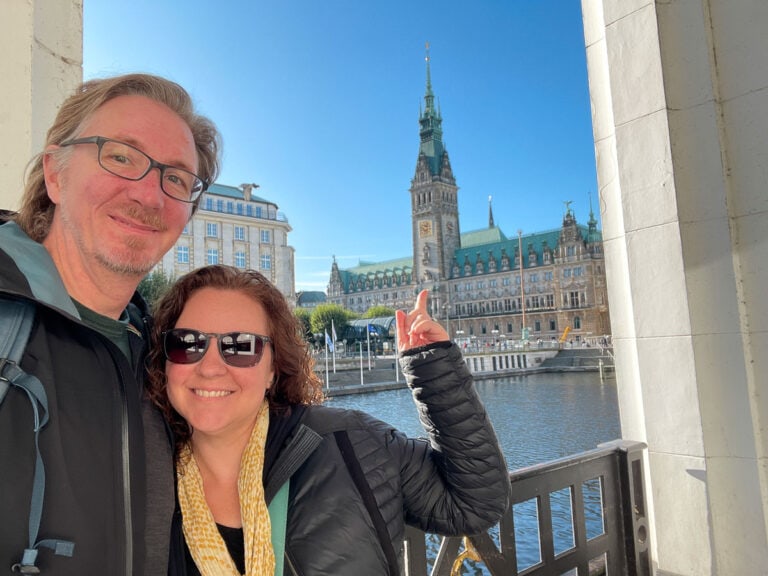
Hamburg, Germany Sightseeing Tips: Best Things To Do In 2024
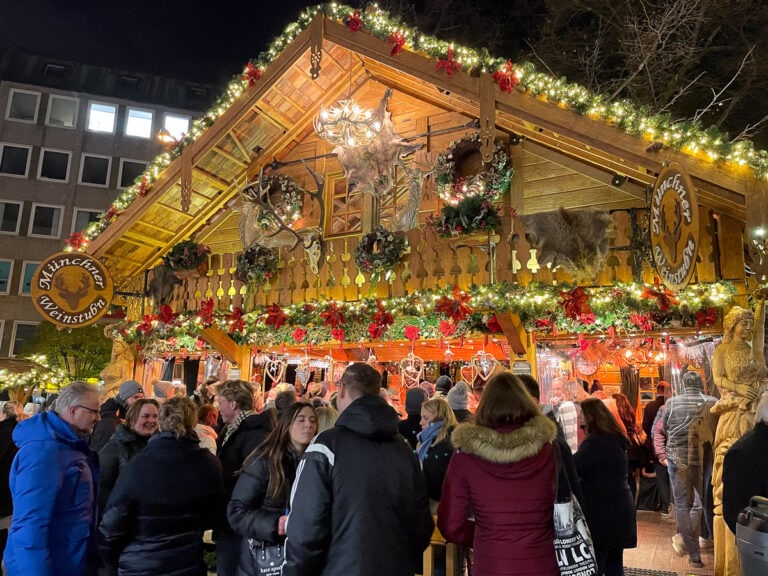
Munich in Winter: 15 Best Things To Do (Plus Travel Tips)
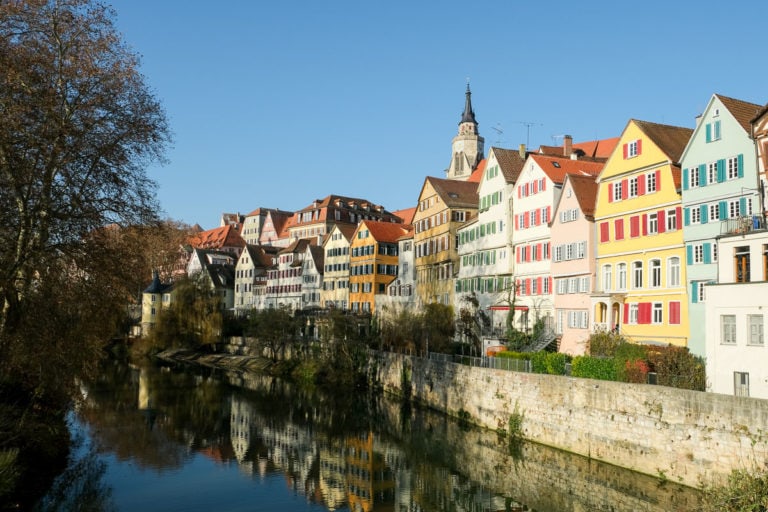
Best Things to Do and See in Tübingen, Germany
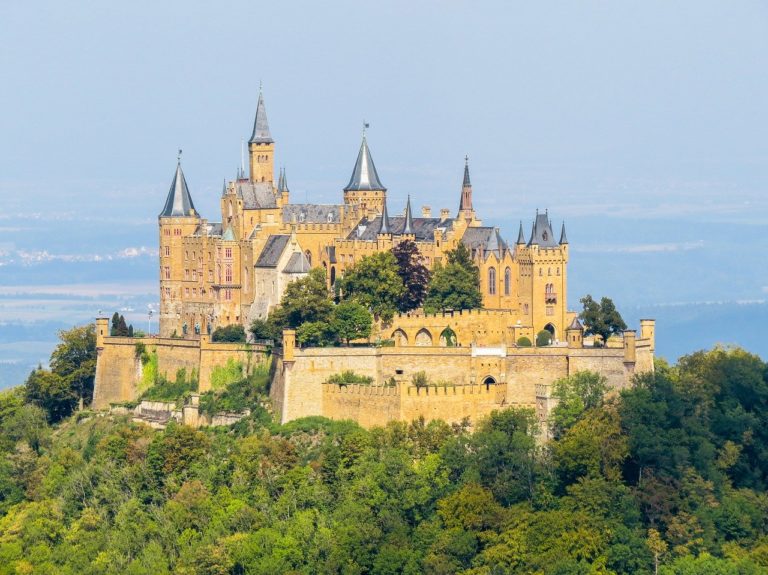
Best Day Trips & Weekend Trips from Stuttgart, Germany in 2024
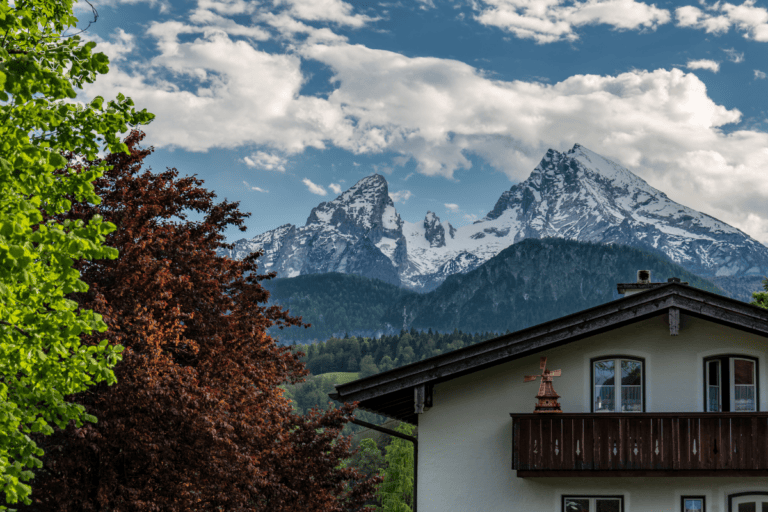
What to Do In Berchtesgaden, Germany (Including Eagle’s Nest And Surrounding Area)
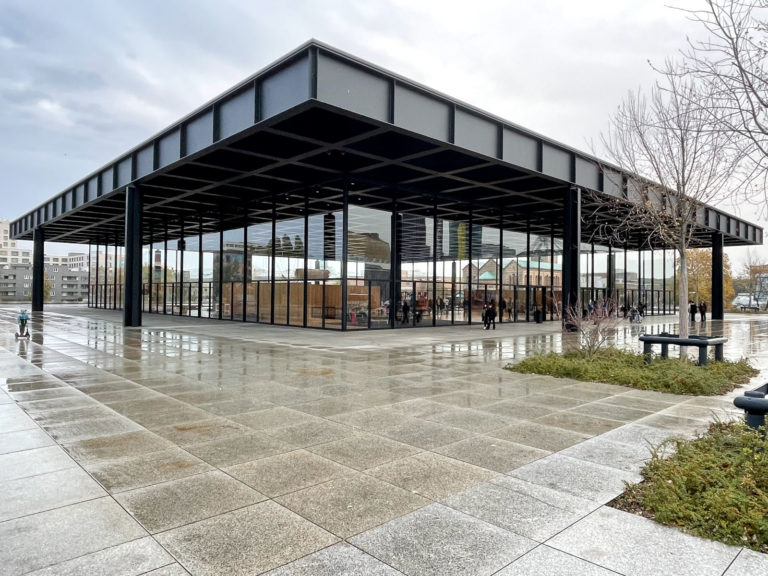
Best Museums to Visit in Berlin, Germany in 2024
Here’s how we can help you plan your perfect trip in 2024.
GERMANY TRAVEL PLANNER: Just getting started? Have questions about Germany’s confusing train tickets or how to find the best guided tours? Not sure which parts of Germany should be in your itinerary (and what to leave out)? Our Germany Travel Planner answers those questions and more via how-to videos, our interactive Germany Planning Map, City Cheatsheets, and MUCH more. Click here to unlock the best of Germany the easy way!
GERMANY TRAVEL CONSULT: Feeling overwhelmed? Itinerary just not coming together? Wonder if a few tweaks would take your trip to the next level? Book a Mini or Full consult with Cate! She’ll help you create or tweak your itinerary, recommend train tickets/passes, hotels, things to do, guided tours, show you how to buy train tickets, orient you to specific cities, help you plan out day trips, and answer your Germany travel questions.
ACCOMMODATIONS: We recommend using Booking.com since they have widest range of accommodations available from hostels, boutique hotels, luxury chains, aparthotels, at the best prices. Check out our accommodation guides for specific recommended hotels.
WHAT TO PACK: If you’re bringing your phone, be sure to bring this plug adapter , this power bank , and this wrist strap . They’ve been lifesavers for us! You can see our other packing essentials here and here .
TICKETS & TOURS: For guided tours, day trips, private tours, and skip-the-line tickets, Get Your Guide is our go-to!
TRAINS & BUSES: To research train schedules and buy tickets or a Germany Rail Pass, we recommend the official Deutsche Bahn (German Rail System) website (and download their DB Navigator app). For buses, look at FlixBus , which offers tickets for routes within Germany and to other European countries. FlixBus is often cheaper than trains but can take longer.
Leave a Reply Cancel reply
Your email address will not be published. Required fields are marked *
Save my name, email, and website in this browser for the next time I comment.

Frankfurt Travel Guide
Last Updated: August 31, 2023
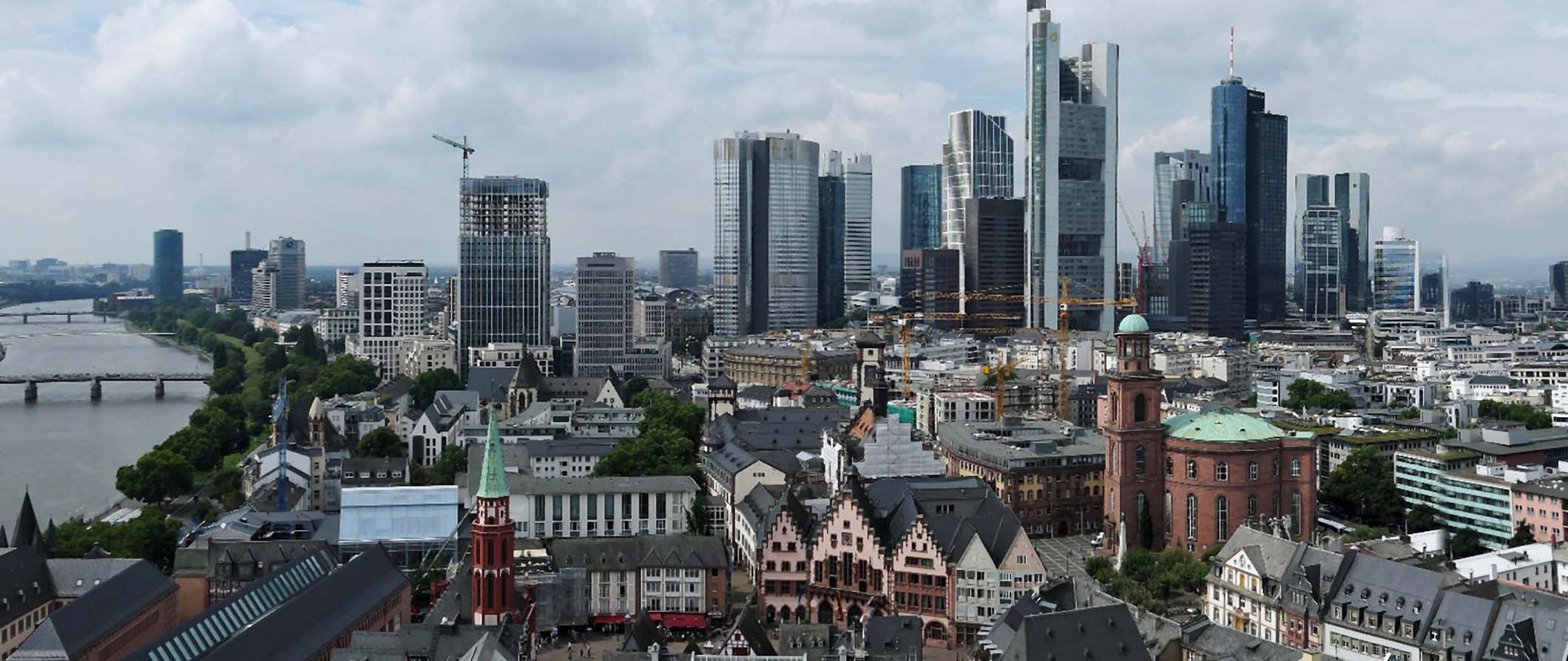
Frankfurt is a city ripe with culture, restaurants, and history. It’s also the center of banking and business in Europe . While Frankfurt lacks the charm of Munich or Berlin , it’s more than just a stopover destination (Frankfurt’s airport is one of the world’s busiest international airports so a lot of people have short stopovers here).
For more than five centuries, Frankfurt was known as the Free City of Frankfurt, an important city-state in the Roman Empire. Today, the city is incredibly diverse; half of the population has a foreign background, and a quarter of the population are foreign nationals.
While most people who stop here never leave the airport, Frankfurt is actually worth exploring for a few days. Eat dinner at one of the city’s famous cider houses, relax at a beer garden, spend the afternoon at one of the free parks, or soak up the city’s history in a museum.
This travel guide to Frankfurt can help you plan your trip, save money, and make the most of your visit to this overlooked gem!
Table of Contents
- Things to See and Do
- Typical Costs
- Suggested Budget
- Money-Saving Tips
- Where to Stay
- How to Get Around
- How to Stay Safe
- Best Places to Book Your Trip
- Related Blogs on Frankfurt
Top 5 Things to See and Do in Frankfurt
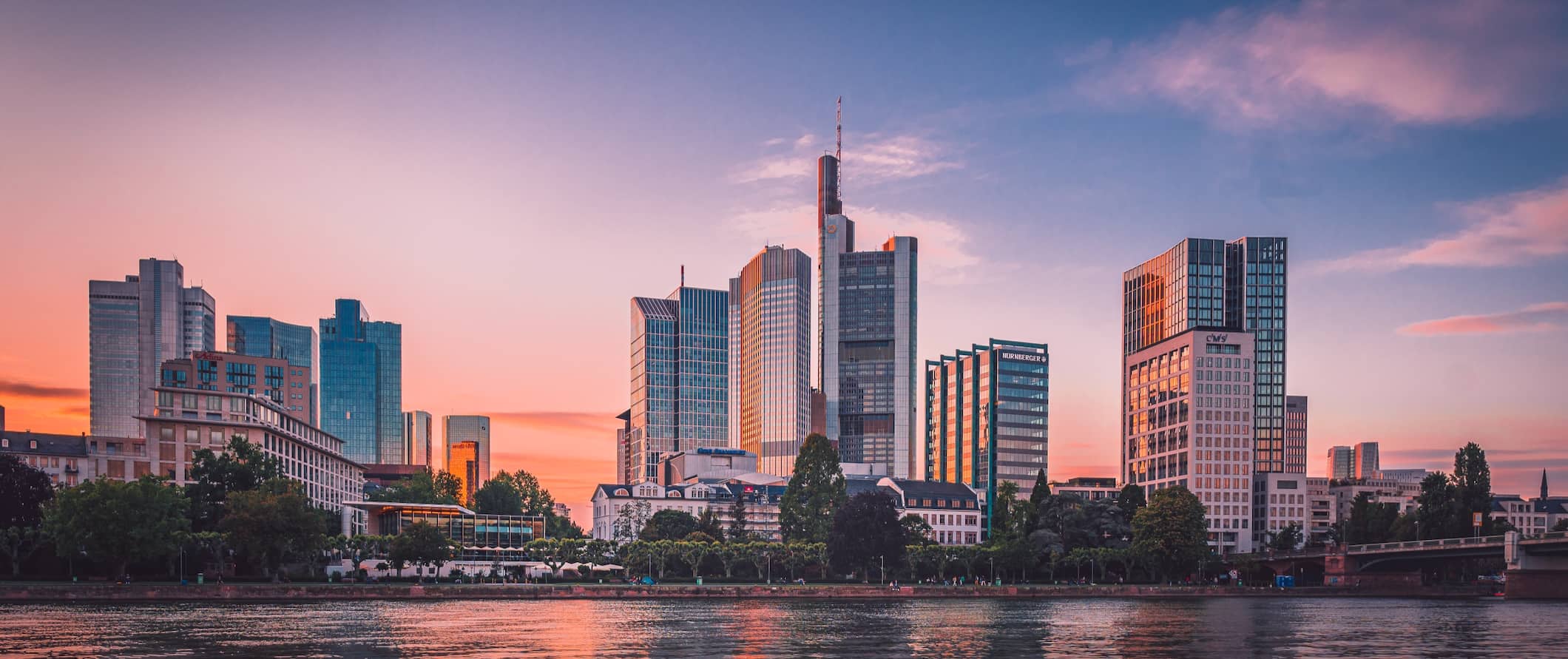
1. See the Dom
Frankfurt’s main attraction, this reddish sandstone cathedral dates back to the 14th century when it was used to crown the emperors of the Holy Roman Empire. It boasts a 95-meter-tall (311 feet) Gothic tower, which you can climb via 328 steps. Admission is free, but the tower is 3 EUR.
2. Visit the Städel-Museum
The Städel Museum has an impressive collection of art, with a heavy focus on German and Renaissance art. There are over 3,000 paintings, 4,000 photographs, 600 sculptures, and 10,000 drawings from the likes of Monet, Picasso, Bacon, Ernst Ludwig Kirchner, and others. Admission is 16 EUR.
3. Explore Römerberg
The historical center of Frankfurt is home to colorful half-timbered buildings and several medieval buildings that date back to the 14th and 15th centuries. Most buildings were destroyed during World War II, but many have been restored to reflect what they used to look like. It’s a picturesque spot to stroll and take in the local pace of life.
4. Relax in Frankfurt City Forest
The city forest is the largest forest contained within any city limits in Germany. The six playgrounds and nine ponds make the forest a popular place for people looking to relax in nature. There is also a 450-kilometer-long (279 miles) network of trails for hikers, walkers, cyclists, and runners!
5. Visit Offenbach
Offenbach is a small neighboring city with tons of little shops, a flea market, a farmer’s market, an old baroque castle, and the stunning Neo-baroque Büsing Palace. Offenbach is the perfect place to escape the hectic city for a day and enjoy a slower pace of life.
Other Things to See and Do in Frankfurt
1. cross the eiserner steg.
Otherwise known as the Iron Bridge, this Neo-Gothic pedestrian bridge connects the downtown core to the Sachsenhausen district. Built in 1869, the bridge provides unique views of the city from over the Main River from which the city takes its full name, Frankfurt am Main (Frankfurt on the Main). Over 10,000 pedestrians cross the bridge daily!
2. Eat and drink in Sachsenhausen
South of the Main River, Sachsenhausen has many of the best cider taverns and pubs in the city. After visiting some pubs, take a stroll along the Main River and enjoy the view. Sachsenhausen is also known for Museumsufer, a row of 38 museums along the river with themes exploring the arts, architecture, and Jewish history. With the two-day Museumsufer Pass, you can visit all the museums for just 21 EUR.
3. Spend the day at the Palmengarten
Spanning 54 acres, Frankfurt’s botanical garden is the largest of its kind in Germany. Opened to the public in 1871, the garden was actually visited by the famous cowboy Buffalo Bill in 1890. Don’t miss the Palm Garden and its enormous collection of native, tropical, and subtropical plant life. Moreover, the gardens also offer lots of activities year-round, including concerts and guided tours. It’s 7 EUR to visit.
4. Walk around the Bornheim
The Bornheim neighborhood has some wonderful medieval-style houses that survived World War II. Since so much of the city was destroyed in the war, this is your only chance to see what the city looked like before everything was destroyed. The city’s longest street, Berger Strasse, is Bornheim’s commercial hub, and it’s chock full of restaurants, wine bars, boutique shops, and bars.
5. Stroll through the Frankfurt Book Fair
Held in the middle of October for nearly 500 years, this fair is considered the largest event in the publishing industry. Publishers, writers, and creative professionals from all over the world come to hold discussions, network, and celebrate the written word. It’s a week-long affair, but it’s only open to the public during the last two days. A day pass is 25 EUR.
6. Climb the Main Tower
The most rewarding views over Frankfurt are from the top of the 56-story Main Tower, the only high-rise that’s open to the public. Named for the Main River, from here you can take the elevator up to a viewing platform overlooking Frankfurt’s skyline. Tickets to the observation deck are 9 EUR.
7. Visit Goethe House
Born in Frankfurt in 1749, Johann Wolfgang von Goethe is considered Germany’s most important writer. Born in 1749, he was a poet, playwright, novelist, and theater director. Destroyed during World War II, the Goethe House was restored with its original furniture, paintings, and books that belonged to the family. You can also see his writing desk, where he wrote his most famous work, The Sorrows of Young Werther in 1774. Admission is 10 EUR and combination tickets that include special exhibitions are 13 EUR.
8. Visit Senckenberg Museum
The Senckenberg Museum is a treasure trove of natural history artifacts, with everything from fossils to Egyptian mummies to dinosaur skeletons. It’s the second-largest natural museum in the country, home to some 17,000 skeletons. One of the most amazing pieces here is a fossil with a bit of preserved scaly skin attached to it. Admission is 12 EUR.
9. Check out the DialogMuseum
The DialogMuseum is easily one of the most unique museums in Germany. Rather than visiting a museum to view exhibits, this museum invites you to navigate the world as a blind or visually impaired person. On a one-hour tour through four completely pitch-black rooms, visitors experience what it’s like to live without any visual cues, relying on other senses to get them through. Admission is 16 EUR.
10. Explore the Deutsches Filmmuseum
This is another unique museum in Frankfurt, focused on film in Germany. There are exhibits on the history of film, behind-the-scenes insights into filmmaking, interactive displays, film artifacts like sketches, and more. A combined ticket to both the permanent and temporary exhibits is 12 EUR. You can also see a film at the museum’s theater for 8 EUR.
11. Check out the Kleinmarkthalle
If you’re looking for a unique culinary experience, head over to the Kleinmarkthalle for a huge assortment of high-quality fresh produce, delicatessen items and wine, handmade German regional products, and also international favorites. There are various small eateries with seafood, Italian specialties, and much more. It’s a great place to wander around, especially on a rainy day.
For more information on other cities in Germany, check out these guides:
- Berlin Travel Guide
- Cologne Travel Guide
- Munich Travel Guide
Frankfurt Travel Costs
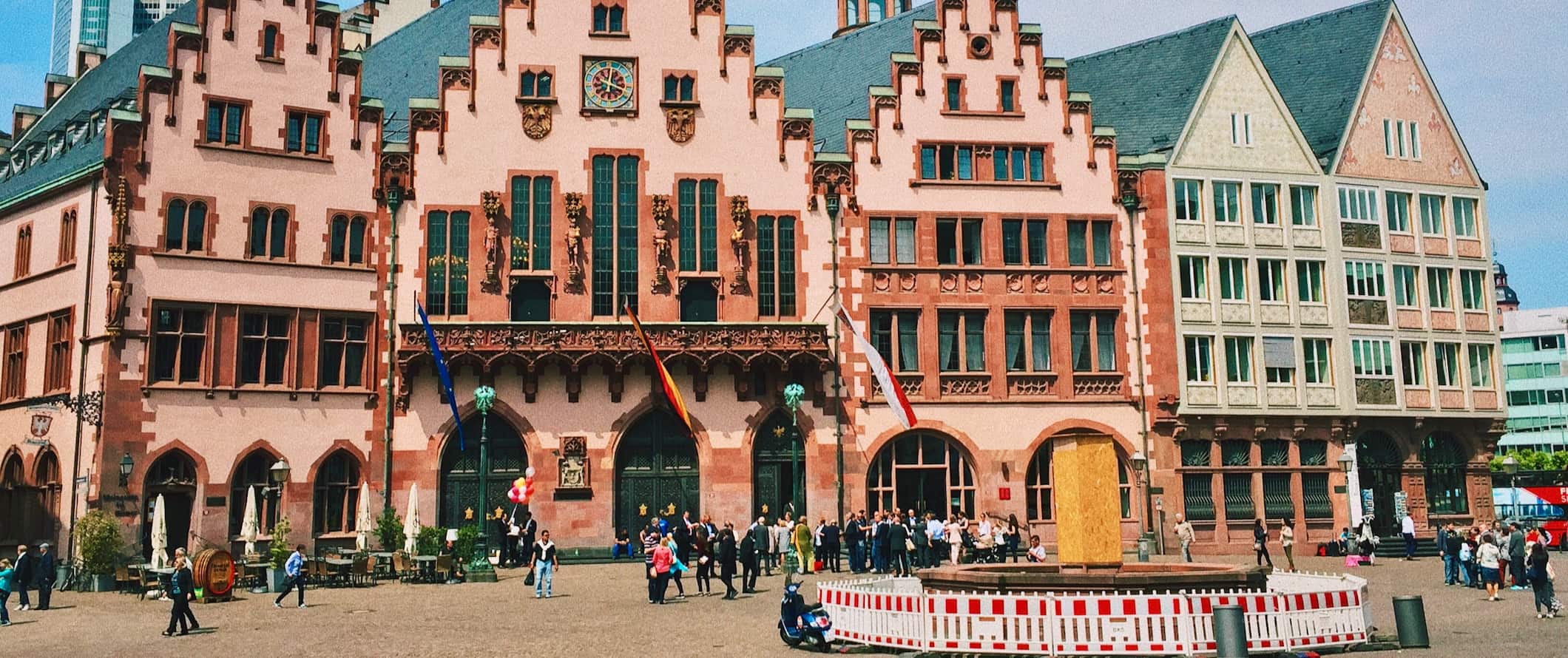
Hostel prices – A bed in a 4-6-bed dorm costs 31-38 EUR per night while a dorm with 8 beds or more costs 22-25 EUR per night. A basic double private room costs about 160 EUR per night. Free Wi-Fi is standard and some charge a supplemental one-time fee of 3-4 EUR for linens. None of the hostels in Frankfurt offer free breakfast, though a couple offer robust breakfast buffets for 6-8 EUR. Most hostels also have a bar/café on site.
For those traveling with a tent, camping is available outside the city. A basic plot for one person without electricity costs 15 EUR per night.
Budget hotel prices – Budget hotels start at 50-65 EUR per night. Free Wi-Fi, TVs, and private bathrooms are all standard. Free breakfast is rare, though most hotels offer a breakfast buffet for an additional 8-10 EUR.
Airbnb is available everywhere in Frankfurt. Private rooms start around 35-55 EUR per night while a full apartment starts at 80-125 EUR per night. Expect prices to double if you don’t book early.
Food – Food in Germany is very cheap (and hearty). Meat is a staple of most meals, especially sausages; there are over 1,500 different kinds of sausages in Germany (sausages here are known as “wurst”). Stews are also a popular traditional choice, as are potato dumplings and sauerkraut. Breakfast is usually composed of bread, cold cuts, cheese, and boiled eggs.
Frankfurt has tons of cheap food options. Currywurst and frankfurters are everywhere for less than 4 EUR, while a hearty plate of fries is less than 6 EUR. A traditional meal of chicken at a cider house costs 9-11 EUR, while a glass of cider to go with it is about 2 EUR.
A beer costs about 4 EUR while a glass of wine is 4.50-6 EUR.
A combo meal at McDonald’s costs about 8.50 EUR while a pizza is around 9-11 EUR. At a mid-range restaurant, a sandwich or German savory pancakes cost between 7.50-10. A big bowl of salad is 8.50-11.50.
If you want to splash out, a set six-course menu at a gourmet restaurant starts at 100 EUR, including traditional German food like schnitzel. A single entree may cost as much as 35 EUR for a duck breast.
If you cook for yourself, you can spend as little as 50 EUR on groceries per week. This gets you basic staples like rice, pasta, bread, produce, and some meat. You can save money by shopping at supermarkets like Aldi, Lidl, Penny, and Netto, which are pretty cheap and even have organic products for a fair price.
Backpacking Frankfurt Suggested Budgets
If you’re backpacking Frankfurt, my suggested budget is 60 EUR per day. This budget covers staying in a hostel dorm, using public transportation to get around, cooking all of your meals, limiting your drinking, and sticking to mostly free activities like walking tours.
A mid-range budget of 135 EUR covers staying in a private Airbnb room, eating out for some of your meals, renting a bike or taking the occasional taxi, enjoying a few drinks, and doing some paid activities like visiting museums.
On a “luxury” budget of 235 EUR or more per day, you can stay in a budget hotel, eat out for all your meals, drink more, take more taxis, and do whatever tours and activities you want. This is just the ground floor for luxury though. The sky is the limit!
You can use the chart below to get some idea of how much you need to budget daily, depending on your travel style. Keep in mind these are daily averages — some days you’ll spend more, some days you’ll spend less (you might spend less every day). We just want to give you a general idea of how to make your budget. Prices are in EUR.
Frankfurt Travel Guide: Money-Saving Tips
Frankfurt is one of the more expensive cities in Germany. However, you can turn Frankfurt into a more affordable destination with just a few simple tricks. Here is how to save money in Frankfurt:
- Purchase a Museumsufer ticket – For those of you that love visiting museums, this two-day pass saves you tons of money. Costing 21 EUR, this card provides access to 34 museums in and around Frankfurt.
- Get the Frankfurt Card – An alternative to the Museumsufer Card is the Frankfurt Card, which provides free travel on all public transport (including to the airport) as well as up to 50% discounts on tours, museums, and other attractions. You can get a one-day card for 11.50 EUR, or a two-day card for 17 EUR.
- Take a free walking tour – Frankfurt Free Tour provides an overview of the historic center and all its highlights. It’s a great way to get the lay of the land on a budget. Just remember to tip your guide at the end!
- Stay with a local – If you want to save money on accommodation while getting some insight from the locals, try Couchsurfing. It’s a great way to meet people in the city and discover some off-the-beaten-path destinations while also getting free accommodation.
- Take advantage of SaTOURday – Many of the main museums in Frankfurt offer free entry on the last Saturday of every month.
- Get a transportation day pass – If you don’t want to get the Frankfurt Card (which includes unlimited public transport), you can get a regular transportation day pass. It costs 5.50 EUR, which is much cheaper than paying per ride.
- Bring a water bottle – The tap water here is safe to drink so bring a reusable water bottle to save money and reduce your plastic use. LifeStraw is my go-to brand as their bottles have built-in filters to ensure your water is always clean and safe.
Where to Stay in Frankfurt
Frankfurt only has a few hostels in the city. Here are my suggested places to stay in Frankfurt:
- Five Elements Hostel Frankfurt
- Meininger Frankfurt/Main Airport
How to Get Around Frankfurt
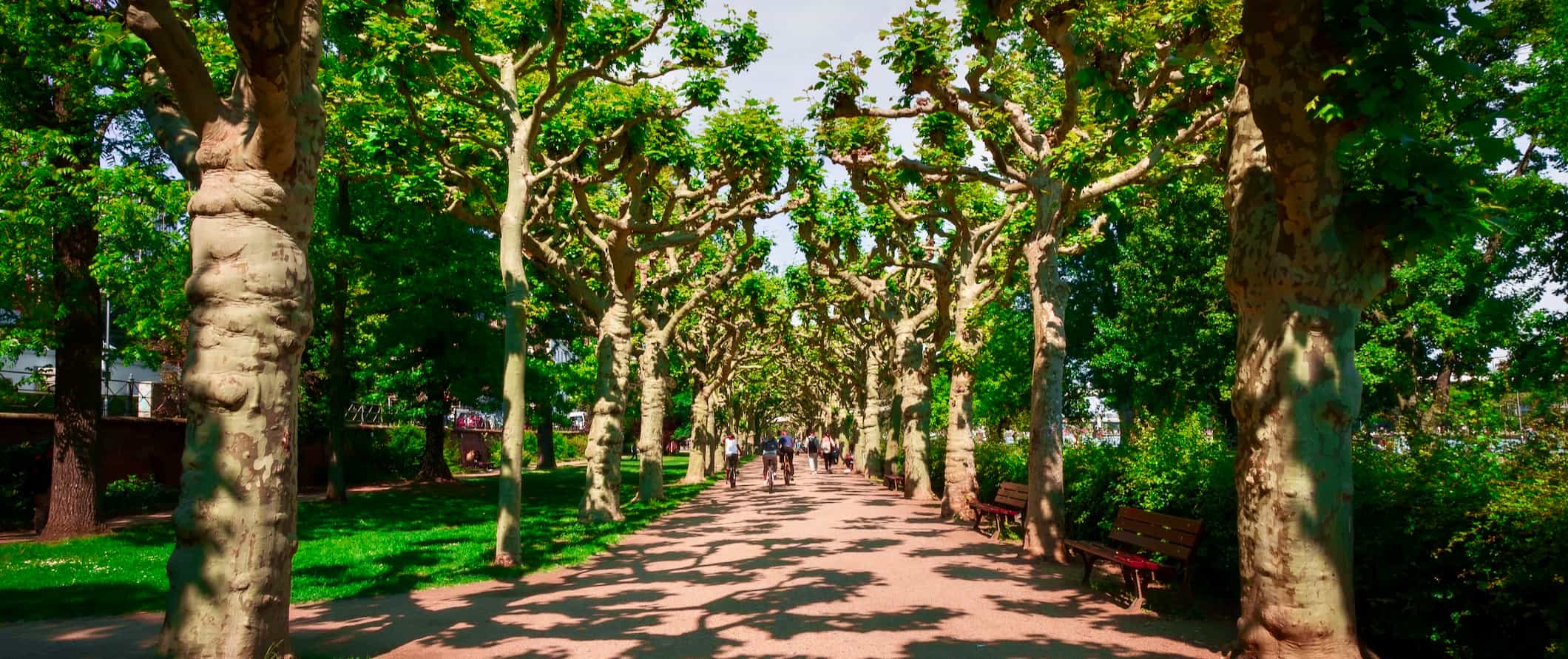
Public transportation – Like other German cities, Frankfurt is well connected by its subway (the U-Bahn) and its above-ground rail system (the S-Bahn). A single ticket is 2.75 EUR and is good for up to 60 minutes, or you can get a short-distance ticket (for journeys less than 2 kilometers) for 1.50 EUR. You can purchase tickets at the station or with the RMV-App. Always keep your ticket on you as random checks on the train are very common.
A day ticket with unlimited travel costs 5.50 EUR. If you’re in a group, take advantage of the all-day group ticket for up to five people for 11.50 EUR (or 16.95 EUR if including the airport). A weekly pass costs 26.80 EUR, including the airport.
You can use your tickets across the train, tram, and bus network.
Ticket prices for trams are the same for the train and bus system. You can buy them onboard the tram, at kiosks next to specific tram stops, or in the app.
Buses take you anywhere you need to go, especially where the trains and trams don’t go. Ticket prices are the same as the trains and trams and can be used interchangeably. You can buy tickets at kiosks next to the bus stop, from bus drivers, or in the app.
Bicycle – Bicycle rentals are plentiful in Frankfurt, with daily rates starting at about 9-15 EUR per day. Try a company like Call a Bike or nextbike, which both have docking stations all over the city. Prices are cheaper if you rent the bike for a week versus half or full days.
Taxi – A base fare for a taxi in Frankfurt is 3.50 EUR, with each additional kilometer costing 2 EUR per kilometer for the first 15 kilometers. After that, it’s 1.75 EUR for every subsequent kilometer. In short, taxis add up fast so skip them if you can.
Ridesharing – Uber is available in Frankfurt, though since the public transportation here is comprehensive you likely won’t need it.
Car rental – Car rentals can be found for as little as 35 EUR per day for a multi-day rental, however, you won’t need one to get around the city. Drivers need to be at least 21 years of age.
When to Go to Frankfurt
Summer is the peak tourist season, specifically July and August. The average daily temperatures are in the upper 20s°C (high 70s°F) and days are sunny and bright. You’ll be rubbing shoulders with lots of other tourists, but there are always fun festivals and events happening during this time.
Spring (April-May) and autumn (October-November) are both shoulder seasons that bring cooler temperatures, sunny days, and fewer crowds. If you want to take advantage of lower room rates and a more laid-back vibe, this is the best time to visit Frankfurt!
Like the rest of Germany, Frankfurt’s winters can be harsh, with temperatures dropping below 1°C (34°F). The city experiences some snowfall, but the Christmas markets throughout November and December are magical. It makes for a good weekend getaway destination in the winter if you plan to hit the holiday markets.
How to Stay Safe in Frankfurt
Frankfurt is a safe city to visit. Violent crime is rare. However, like all big cities, you should stay alert for pickpocketing and petty theft. Keep your valuables secure and out of reach at all times just to be safe.
At night, it’s best to avoid the areas around the Hauptbahnhof, Konstablerwache, and Hauptwache just to be safe.
Solo female travelers should generally feel safe here, however, the standard precautions apply (never leave your drink unattended at the bar, never walk home alone intoxicated, etc.)
Scams here are rare, but if you’re worried about getting ripped off you can read about common travel scams to avoid here.
If you experience an emergency, dial 112 for assistance.
And be sure to purchase good travel insurance. Travel insurance will protect you against illness, injury, theft, and cancellations. It’s comprehensive protection in case anything goes wrong. I never go on a trip without it as I’ve had to use it many times in the past.
Frankfurt Travel Guide: The Best Booking Resources
These are my favorite companies to use when I travel. They consistently have the best deals, offer world-class customer service and great value, and overall, are better than their competitors. They are the companies I use the most and are always the starting point in my search for travel deals.
- Skyscanner – Skyscanner is my favorite flight search engine. They search small websites and budget airlines that larger search sites tend to miss. They are hands down the number one place to start.
- Hostelworld – This is the best hostel accommodation site out there with the largest inventory, best search interface, and widest availability.
- Booking.com – The best all around booking site that constantly provides the cheapest and lowest rates. They have the widest selection of budget accommodation. In all my tests, they’ve always had the cheapest rates out of all the booking websites.
- HostelPass – This new card gives you up to 20% off hostels throughout Europe. It’s a great way to save money. They’re constantly adding new hostels too. I’ve always wanted something like this and glad it finallt exists.
- Get Your Guide – Get Your Guide is a huge online marketplace for tours and excursions. They have tons of tour options available in cities all around the world, including everything from cooking classes, walking tours, street art lessons, and more!
- The Man in Seat 61 – This website is the ultimate guide to train travel anywhere in the world. They have the most comprehensive information on routes, times, prices, and train conditions. If you are planning a long train journey or some epic train trip, consult this site.
- Rome2Rio – This website allows you to see how to get from point A to point B the best and cheapest way possible. It will give you all the bus, train, plane, or boat routes that can get you there as well as how much they cost.
- FlixBus – Flixbus has routes between 20 European countries with prices starting as low 5 EUR! Their buses include WiFi, electrical outlets, a free checked bag.
- SafetyWing – Safety Wing offers convenient and affordable plans tailored to digital nomads and long-term travelers. They have cheap monthly plans, great customer service, and an easy-to-use claims process that makes it perfect for those on the road.
- LifeStraw – My go-to company for reusable water bottles with built-in filters so you can ensure your drinking water is always clean and safe.
- Unbound Merino – They make lightweight, durable, easy-to-clean travel clothing.
- Top Travel Credit Cards – Points are the best way to cut down travel expenses. Here’s my favorite point earning credit cards so you can get free travel!
- BlaBlaCar – BlaBlaCar is a ridesharing website that lets you share rides with vetted local drivers by pitching in for gas. You simply request a seat, they approve, and off you go! It’s a cheaper and more interesting way to travel than by bus or train!
Frankfurt Travel Guide: Related Articles
Want more info? Check out all the articles I’ve written on backpacking/traveling Germany and continue planning your trip:
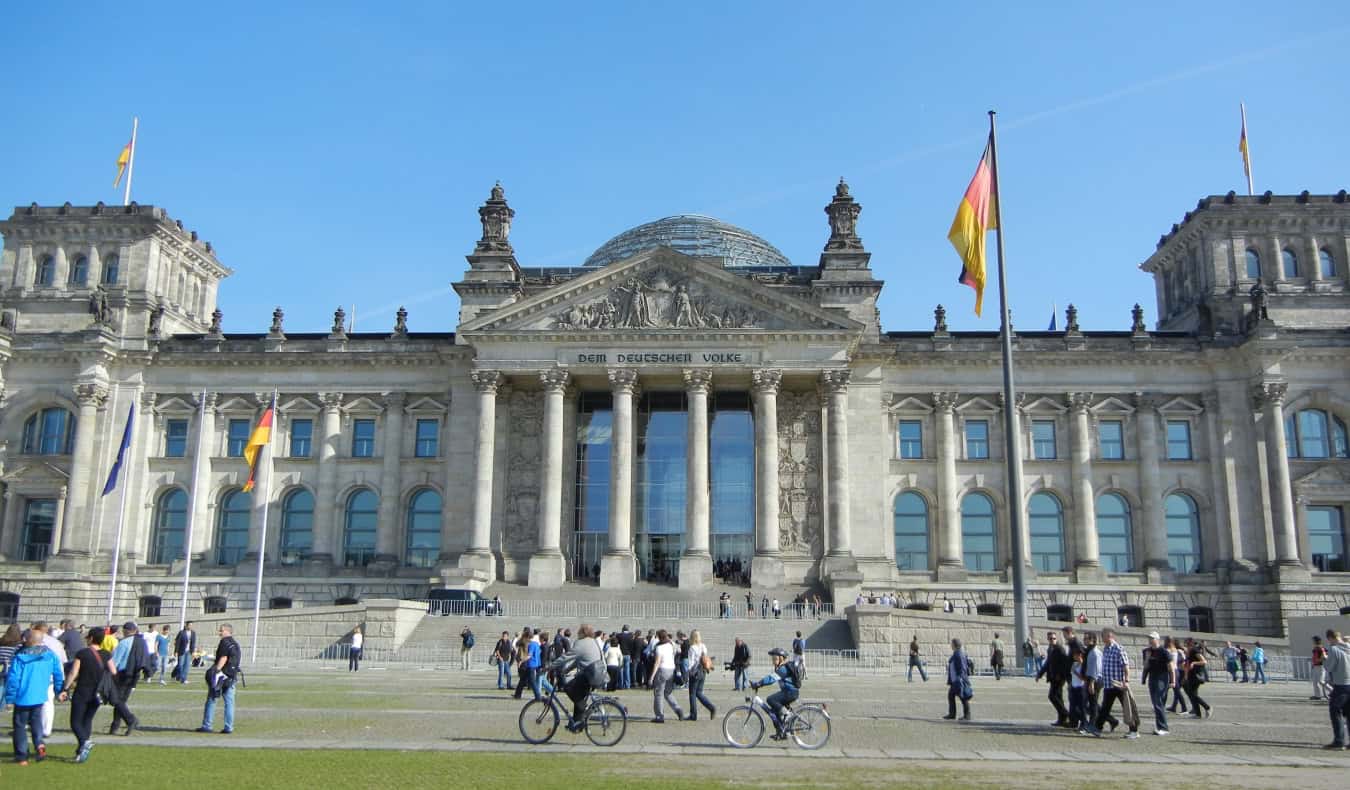
The 7 Best Hotels in Berlin
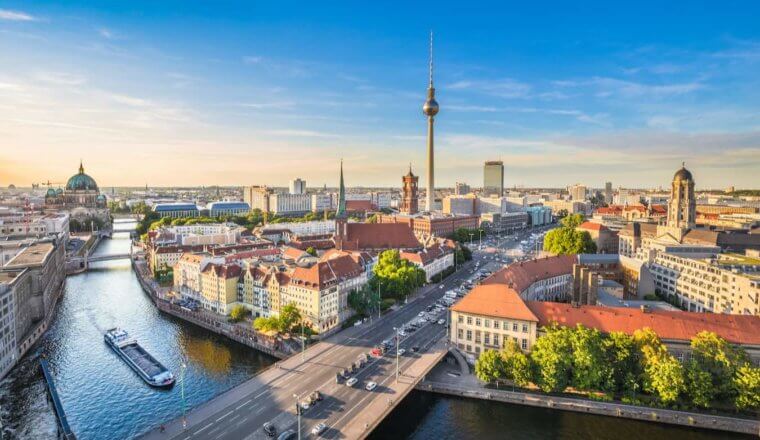
Where to Stay in Berlin: The Best Neighborhoods for Your Visit
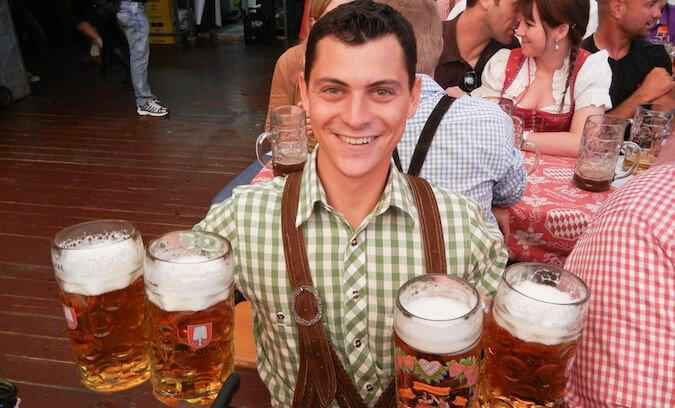
How to Survive Oktoberfest
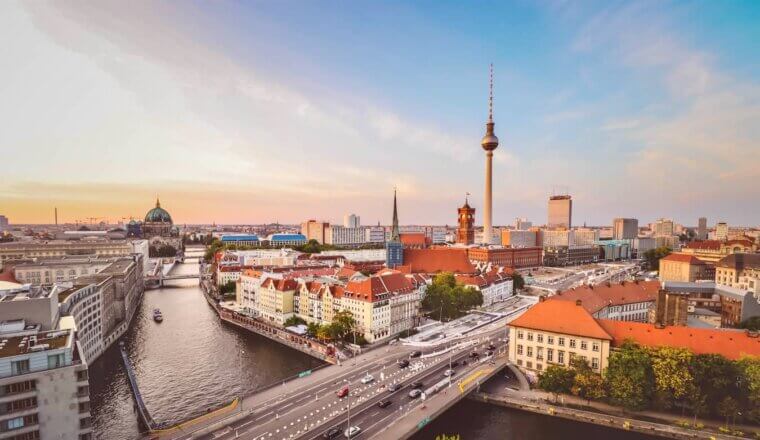
The 18 Best Things To Do in Berlin
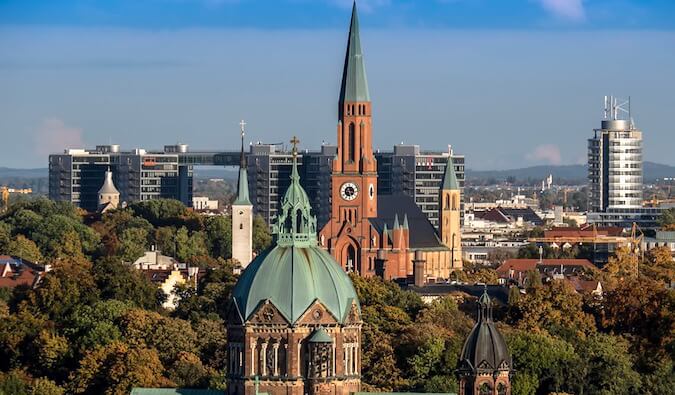
Munich is Better than Berlin
Get your free travel starter kit.
Enter your email and get planning cheatsheets including a step by step checklist, packing list, tips cheat sheet, and more so you can plan like a pro!

- Where To Stay
- Transportation
- Booking Resources
- Related Blogs
24 hours in Frankfurt: How to Spend one day in Frankfurt
You have 24 hours in frankfurt and ask yourself: what do you do in one day.
We’ve got you covered!
The airport in Frankfurt is one of the biggest airports in Germany. Therefore, many visitors arrive in Frankfurt and have a layover of 24 hours.
So, what can you do in Frankfurt in one day? Where should you go, and what can you see in Frankfurt?
Anna , who worked in Frankfurt for a couple of months, had the opportunity to delve into both the touristy and local experiences, uncovering the unique charm of the city.
Frankfurt isn’t on our list of top destinations in Germany . For instance, the central train station in Frankfurt isn’t a pleasant spot to spend your time.
However, there are a few spots in Frankfurt that are definitely worth a visit. In this article, we’ll provide you with all the essential details to ensure you make the most of your 24 hours in Frankfurt.
This blog post may contain affiliate links. If you make a purchase using one of these links, we may receive compensation at no extra cost to you.
24 Hours in Frankfurt – what do to?
We’ve put together a walking tour itinerary for you.
This map includes all of our favorite cafés and restaurants, which you won’t want to miss! Zoom in to see the walking tour!
1. Explore the Old Town in Frankfurt
- Subway Station: Römer (U4)
Start your day by visiting the Römerberg , a historic square in the heart of Frankfurt’s Old Town.
The Römerberg is home to the Frankfurt City Hall, a beautiful building with a rich history. Admire the architecture and stroll around the square, where you’ll find many cafes and shops.

2. Go to the Iron Bridge (Eisener Steg)
The Iron Bridge ( Eisener Steg ) in Frankfurt is one of the city’s landmarks.
This charming pedestrian bridge, built in 1868, has been a part of Frankfurt for over 140 years. It is widely regarded as a symbol of peace and unity between the city and its citizens, connecting them.
From the Iron Bridge, you can enjoy breathtaking views of the Main River and the iconic Frankfurt skyline, making it a perfect spot for sightseeing.
If you are traveling with your loved one, consider bringing a lock and „lock“ you love here as many other lovers from around the world.

🚢 If strolling around isn’t your preference, why not opt for a relaxing 1-hour boat tour on the Main River? *
3. Visit the Alte Nikolaikirche
After strolling over the Eiserner Steg, explore the Alte Nikolaikirche, an ancient church with exquisite stained glass windows and a serene ambiance. Constructed in the 13th century, this church has withstood numerous wars and natural calamities.
4. Stroll around the Neue Altstadt ( = New Old Town )
After that, take time to discover the Neue Altstadt , a reconstructed section of the Old Town in Frankfurt showcasing delightful buildings and shops. This area was devastated during World War II but has been restored .
Enjoy a leisurely walk along the cobblestone streets, marvel at the architecture, or pause at one of the numerous diverse shops and cafes for a good coffee.

5. Take the stairs to the top of the Kaiserdom
- 3 Euro entrance fee to hike up to the view point
- Tight staircase
Finally, hike up the stairs to the top of the Kaiserdom , Frankfurt’s famous cathedral, for a stunning city view.
The Kaiserdom is one of the most important churches in Germany and has been the site of many coronations and significant events throughout history.
The climb to the top can be steep , but the view is well worth it. Enjoy the panoramic view of the city and take some time to appreciate the beauty of Frankfurt’s Old Town.
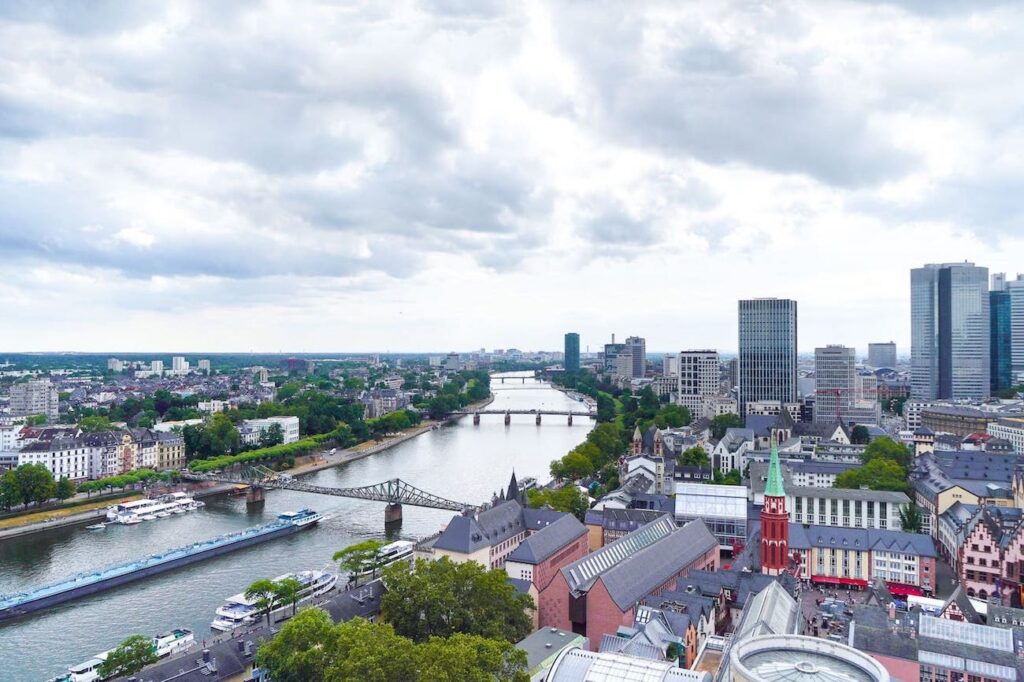
6. Try Local Food at the Kaisermarkthalle
Isn’t it time to enjoy some good food now? Head to the Kaisermarkthalle , located in the heart of Frankfurt, to blend in with the locals and enjoy some fresh food.
7. Visit the Kaisermarkthalle
The Kaisermarkthalle is a bustling indoor market popular for locals and tourists. It offers a variety of local and international food options, vegetarian dishes, fresh seafood, homemade pasta, and much more.
Take some time to wander around and explore the different stalls before deciding on what to eat. Whatever you choose, you will find something delicious at this bustling market.
Don’t miss the chance to savor local delights such as Frankfurt’s renowned green sauce or traditional German sausages . The green sauce, a blend of seven herbs, is typically served with boiled potatoes and hard-boiled eggs, offering a refreshing and flavorful mid-day meal.
And if you’re a fan of sausages, be sure to try the traditional German bratwurst or currywurst, both popular options in Frankfurt.
A typical alcoholic beverage in Frankfurt is Applewoi. If you are visiting for the first time, try it. It is not our taste, so consider asking for a tasting glass or just ordering one if you are unsure.
If you’re looking for a refreshing beverage to complement your meal, consider a German lemon beer as a delightful alternative.
For dessert, it’s best to hold off here! We’ll guide you to another fantastic spot for coffee and dessert with a stunning view.
8. Enjoy the panoramic view at the Galeria Skylounge
It is a self-serve restaurant (a very nice one!). First, you order your food and drinks and pay the bill in cash or with your credit card when you leave.

9. Walk to the the Financial District in Frankfurt
After lunch, it’s time to delve into the unique aspects of Frankfurt’s modern financial district, which is home to impressive skyscrapers and banks. It’s a part of the city that’s sure to intrigue and excite you.
This district sharply contrasts the historic Old Town and offers a glimpse into Frankfurt’s diverse facets.
A standout feature of the financial district is the Main Tower, an observation deck providing breathtaking views of Frankfurt’s skyline.

Once you’ve soaked in the views from the Main Tower, venture to Zeil, a hub of upscale fashion and designer boutiques.
10. Go Shopping
Zeil is Frankfurt’s primary shopping avenue, with renowned brands alongside charming local boutiques. Dedicate to perusing the stores and collecting souvenirs or thoughtful gifts for loved ones.
If you’re looking for a break from shopping, head to one of the nearby cafes or restaurants for a coffee or a bite to eat. The financial district has many dining and drinking options, from trendy bars to upscale restaurants.
Have fun and immerse yourself in the vibrant, modern atmosphere of this bustling part of Frankfurt.

11. Enjoy Dinner and Drinks at the Opernplatz
End the walking tour at the Opernplatz with a delicious dinner at one of the city’s many restaurants.
Opernplatz is a beautiful square in the heart of the city. Here, various restaurants serve everything from local specialties to international cuisine.
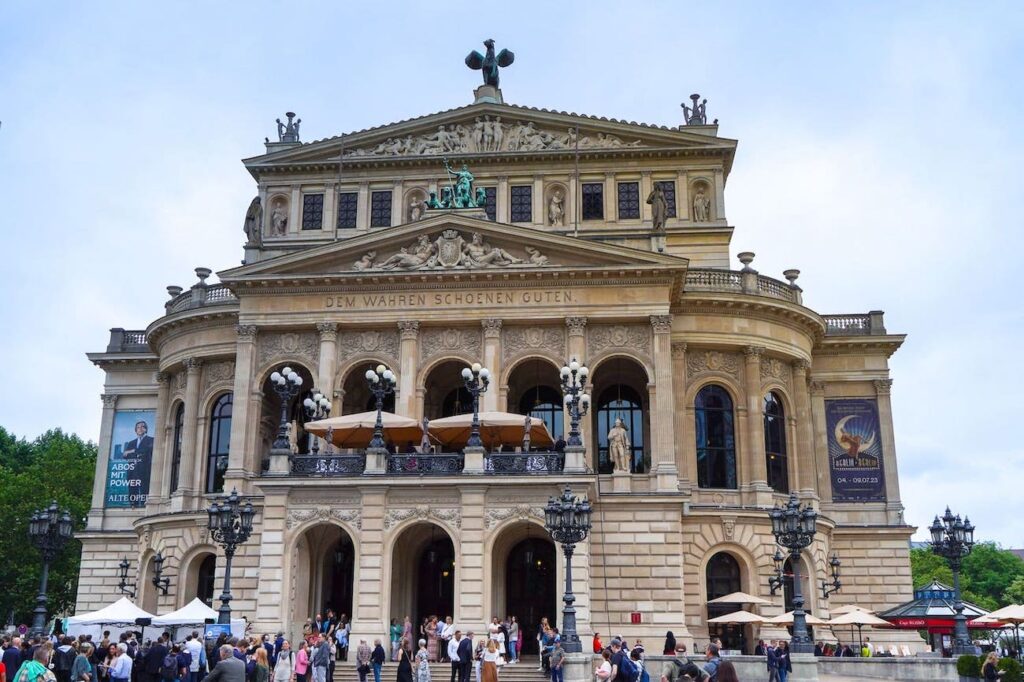
After dinner, why not savor a drink at one of Frankfurt’s diverse bars or pubs? For a vibrant and bustling scene, Sachsenhausen is the place to be. This neighborhood is renowned for its eclectic mix of bars and diverse nightlife options, making it a must-visit for those seeking an energetic evening.
If you want a more upscale experience, head to a rooftop lounge for a stunning city view at night. Many of Frankfurt’s high-end hotels have rooftop bars and nightclubs that offer panoramic views of the city skyline.
Best Time to Visit Frankfurt
The best time to visit Frankfurt is undoubtedly during the summer months between May and September .
The city offers a variety of sightseeing opportunities, as well as festivals and cultural events during the summer months.
The Frankfurt Book Fair and Oktoberfest are two major events that bring people from all over the world to Frankfurt.
With temperatures ranging from pleasant to perfect, the months of May to August are ideal for outdoor activities. Whether it’s a leisurely walk along the Main River or exploring the historic Römerberg, Frankfurt’s natural beauty is best experienced during these months.
Where to Stay in Frankfurt?
1. NH Collection Frankfurt Spin Tower * : If you are looking for a hotel in Frankfurt that combines comfort and convenience, then NH Collection Frankfurt City is the right choice for you. The hotel stands out with its bright and clean rooms, equipped with modern design and comfort. Guests value the The stunning view of the city. The friendly staff ensures that you feel completely comfortable during your stay. Another advantage is the uncomplicated luggage storage, which makes your stay even more pleasant. This hotel is very close to the Frankfurt Trade Fair, which makes it the perfect choice for business travelers.
2. The Westin Grand Frankfurt* : Located in the heart of downtown Frankfurt, The Westin Grand Frankfurt is an excellent choice for first-time visitors. This luxurious hotel offers a modern and elegant atmosphere with comfortable amenities and easy access to restaurants and public transportation. The best part: You can relax in the sauna and the pool once you are done with exploring Frankfurt.
3. Sofitel Frankfurt Opera* : Situated in the heart of Frankfurt, the Sofitel Frankfurt Opera exemplifies luxury and sophistication. This 5-star hotel, with its spacious rooms and elegant interiors, serves as a perfect retreat from the city life. Each room comes equipped with a complimentary minibar. The hotel boasts an indoor pool inviting you to go for a couple of lap. The staff is committed to going the extra mile for every guest.
Getting Around Frankfurt
Frankfurt benefits from an efficient public transportation system , making navigating the city’s top attractions incredibly convenient. Exploring all the key sites is as simple as hopping onto a bus or train.
You can purchase tickets at one of the many ticket machines in the city or online.
Bicycles are also a good option for getting around, as Frankfurt has bike lanes.
FAQs: 24 hours in Frankfurt
How many days in frankfurt.
If you’re tight on time, one day is enough to enjoy Frankfurt’s highlights. This timeframe lets you explore modern and historic areas and savor local delights for a comprehensive experience.
How much money do I need for 1 day in Frankfurt?
The average amount of money you need for 1 day in Frankfurt varies based on preferences. Budget travelers can manage with around €50-€100, mid-range travelers might spend €100-€200, and luxury travelers could require €200 or more for a comprehensive experience including meals, transportation, and attractions.
What means of transportation are available to get around in Frankfurt?
In Frankfurt, you have various transportation options for getting around. The city boasts an efficient public transportation network, including trams, buses, and trains. Additionally, taxis, bike rentals, and walking are convenient ways to explore the city and reach its attractions.
Are there free activities to do in Frankfurt?
There are many free activities to do while visiting Frankfurt, such as taking a tour of some of the city’s churches and cathedrals, exploring parks like Günthersburgpark, taking a stroll along the Main riverbank, or simply people-watching in one of the bustling squares.
Final Thoughts: one day in Frankfurt
One day is enough to explore the Old Town, the financial district, and some old churches in Frankfurt. If you are tired from walking, jump on a boat and enjoy the Main River.
As the sun sets, you can savor a delightful dinner and drinks against the city’s stunning skyline. But remember that Frankfurt is just one city in Germany worth visiting.
Frankfurt is not just a destination, but a gateway to a myriad of experiences. Consider day trips to the historic charm of Heidelberg, the fairy-tale streets of Rothenburg ob der Tauber, the rich history of Nuremberg, or the cultural allure of Würzburg.
- Best hotels near US embassy in Frankfurt
- Can you visit Neuschwanstein without a ticket?
- 10 day itinerary for visiting Germany by train
- 27 best things to do in Göttingen
Anna and Anne are the founders of Germany Things To Do. They grew up in Germany and have traveled all 16 regions in Germany from North to South and East to West.
They share their local tips with you to explore the authentic and beautiful parts in Germany.
Ähnliche Beiträge

Can you visit Neuschwanstein without ticket?
Neuschwanstein without a ticket? Is it possible to explore one of Germany’s most iconic castles without…

Neuschwanstein Castle tours from Nuremberg
Are you planning a tour to Neuschwanstein Castle from Nuremberg? We’ve got some important tips for…
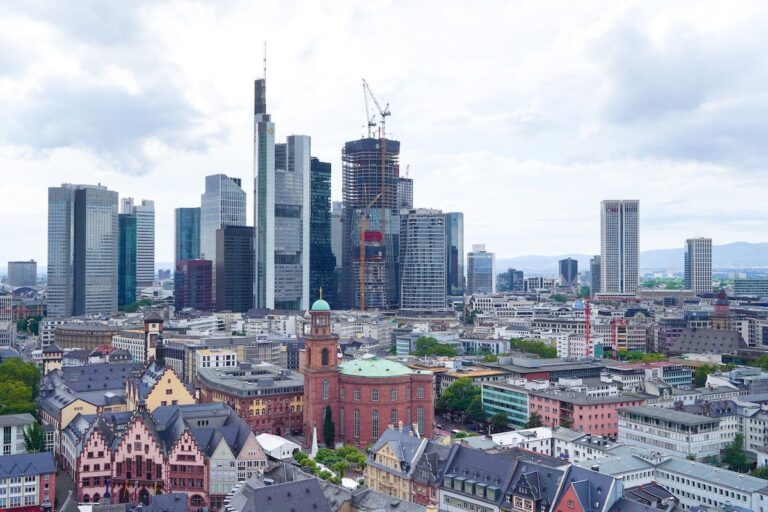
Best Hotels near US Embassy in Frankfurt (2024)
So you’re heading to Frankfurt and are looking for a hotel near the US Embassy? Smart…
The Ultimate Frankfurt Travel Guide for 2024

Although I grew up only 2.5 hours away from Frankfurt I never really explored the city as much as I should have. My first time visiting Frankfurt was only in 2006 during the FIFA World Cup football in Germany.
We slept outside on the grass on the river side in a sleeping bag. It was the adventurous end of an epic night out after Netherlands played against Argentina. That experience has always resonated with me and ever since I am a fan of visiting Frankfurt.
Here are all my travel tips and recommendations to also make your trip to Frankfurt one to remember.

Although Frankfurt is one of the biggest cities in the country it is not really one of the most popular tourist spots in Germany. Cities like Berlin, Munich and Cologne draw more tourists on average than Frankfurt. The city is a business hotspot and most people that travel to Frankfurt are there for business. This is not surprising regarding the fact that Frankfurt is the European banking capital. That said the city definitely has a cosmopolitan vibe and many expats from all over the world live in the big apple of Germany.
In this Frankfurt travel guide you will find multiple Frankfurt travel tips, some facts about the city, 16 unique things to do, a walking tour, an itinerary and some nice hotel recommendations. basically all you need to make the most of your city trip to Frankfurt.

Are you traveling to Frankfurt by plane and looking for the best way to stay connected? You can buy a prepaid sim card on arrival at the airport, but it is not recommended. Check out my guide for buying a sim card at Frankfurt Airport in 2024 .
you may also like...

Theere are much better sim card deals and e-sim card plans for Germany and I am sure you will like my article about buying a sim card for Germany in 2024 .
Best time to visit Frankfurt
No need to mention that the best months for a trip to Frankfurt are the summer months in Europe. That said, July and August can get hot and since it is the holiday season many people travel to Frankfurt. Good thing about the peak season is that there are events on a daily basis, so it just depends what you are looking for. If you are a fan of Christmas markets then plan your Frankfurt city trip in the weeks before Christmas. Usually they start around the last week of November.
How to get to Frankfurt
Traveling to Frankfurt by train? Pretty sure you found out that can be expensive! The bus is surely a cheaper option. Traveling by bus to Frankfurt is cheap and convenient. Check out the prices below in the public transport search engine.
Powered by 12Go system
The 12Go transportation search engine will give you all the options for you to compare: bus, train, flight and you can directly book online and reserve your seat.
Also check out my article about the best way from Aachen to Cologne for more tips on how to get around in Germany.
Some cool facts about Frankfurt
- Frankfurt has a massive forest in the heart of the city and is within walking distance from the old town.
- There is only 1 skyscraper in the top 15 highest buildings in Germany that is NOT located in Frankfurt. This is why this is called the Big Apple of Germany.
- The headquarters of the European Central Bank is located in Frankfurt.
- Frankfurt was heavily bombed in WW2.
- This is the city of Goethe. The famous German Poet was born here and lived all his life in Frankfurt.
- More than 25% of the people living in Frankfurt are expats.
- Frankfurt Airport is the biggest airport in Germany and is the 4th biggest airport in Europe.
16 Things to do in Frankfurt
1. enjoy a drink in a rooftop bar.
As I mentioned before already you have to go up one of the skyscrapers when you visit Frankfurt. There are 3 bars that really stand out.
1.1 City Beach

There is a €4 entrance fee for this rooftop bar on top of a parking lot. Finding the entrance is a little challenging but once you up on the roof the views are good.

There are two small pools, loads of beach chairs, sand and uncomplicated vibes.
1.2 Long Island Summer Lounge
This is the posh version of City Beach with a proper dress code. Officially no flip-flops and shorts allowed. Entrance fee is €6 but the views at Long Beach Summer Lounge are better. The rooftop is higher as City Beach as well.
1.3 Oosten am Main
According to locals the most laid-back skybar is Oosten am Main. Since it is a little walk out of the center it has the best skyline view as well. Uncomplicated local vibe is guaranteed here. Sipping a cocktail for sunset is definitely one of the best things to do in Frankfurt.
2. Hop-on-hop-off bus

A standard things to do in Frankfurt, but quick and easy to see all the tourist spots in Frankfurt when you don’t have that much time. There are several lines to choose from. Buying a ticket online is cheaper than on the bus itself or at the street vendors.
3. Viewing terrace Frankfurt Airport
Often listed as one of the most exciting things to do in Frankfurt with kids is the viewing platform at Frankfurt Airport. This covered area is a great place for spotting airplanes taking off and landing. There is a Food Court and a Mc Donalds if you get hungry.
4. Walk through Old Town

The old part of the city is actually called Romerberg and was rebuilt the traditional way after the second World War. The medieval colorful buildings are a favorite instagram spot in Frankfurt. In summer there are many terraces lined up for having a drink, in winter this place is heaven for Christmas market lovers.
5. Tricycle ride around Frankfurt

For those that are willing to see the best places to visit in Frankfurt from the back of a bike they can take one of the tricycles around the city. Be aware that these guys are expensive! For 30 minutes you already pay more than €22 or 2 kilometer is €8. It is a cool but rather expensive way to explore Frankfurt.
6. Marvel at the Euro sign

This huge sculpture of the Euro stands in front of the European Central Bank on the Willy-Brandt square and is pretty big. Probably about 30 meters high. There is some info about the Euro on the base of the sign, but there also is a Euro information center and book shop next to it. Although it is more like a gift shop.
7. Lock your Love at Eisener Steg bridge

The bridge that also got destroyed during World War 2 was reconstructed straight after and is now famous for people locking their love with a padlock. From this walking bridge you will have a good view over the skyline and the boulevards on both sides. It connects the old town of Frankfurt with Sachsenhausen, the place to go out at night. But more about what to do in Frankfurt at night later!
8. Ignatz-Bubis bridge instagram spot

If you are not going up on one of the rooftop bars then head to the Ignatz-Bubis bridge for the best skyline photos. Also a great Instagram spot in Frankfurt and cool for sunset. Another free thing to do in Frankfurt.
9. Try Apfelwein
Apparently this kind of apple cider is home to Frankfurt and a a popular drink around the city. Frankfurt is home to many idyllic cafes and traditional bars where they happily serve you their signature drink called Apfelwein.
Not sure if this is one of the best Frankfurt travel tips because I did not like it. I much rather had the a normal beer with a Frankfurter wurst on the side! :)
10. Visit the Goethe House
Located just a few minutes walk from Central Station is the Goethe Haus. Here the famous German Poet was born in 1749. There are 4 different floors to explore and learn about his life. Entrance fee is €7 and it is open from 10am to 6pm. A weekend in Frankfurt is not complete without visiting the Goethe House.
11. Viewing platform cathedral tower

On of the best things to do in Frankfurt is to climb up to the viewing platform 66 meter above the city. The cathedral tower is open to the public for the best city views. Costs are €5 and you will have to walk a lot of steps, but the view is worth it.
12. Free walking tour
If you feel like you have crossed off all the things to do in Frankfurt then join one of the free walking tours and get to know the city through the eyes of a local. Free walking tours are tip based tours and depart every day around 10am and 2pm. There are a couple different ones so check your meeting point online.
13. Viewing platform Main Tower
If amazing city views are your thing then head up to the viewing platform of the main tower when you visit Frankfurt. Entrance fee is €7,50 but you will get unobstructed city views!
14. Have breakfast/lunch at the river side

Simply one of the most gorgeous places to visit in Frankfurt is the river side. Big lawns with some trees and a boulevard where active people bike, run and skate. The park on the Main river is a perfect spot to picknick. It is relaxed and one of the best ways to enjoy this city. Definitely add a picknick on the river side to your trip to Frankfurt.
15. Go out at night in Sachsenhausen

The place to go out in Frankfurt at night is Sachsenhausen just across the river. Here many quaint pubs are lined up next to each other and is the bustling heart of the city at night. If you spend a weekend in Frankfurt I am sure you are willing to end up here in one of the many traditional German bars.
16. Enjoy a coffee at a floating restaurant

There are a couple boats where you can grab a drink or have lunch/dinner but not so many. A great one is below the Eisener Steg bridge with great views, also close by is the Döner Boat.
Things to do around Frankfurt
If you are visiting Frankfurt for more than just a weekend then you might be interested in some things to do around Frankfurt. Have a look at these great day trips from Frankfurt.
1. Burg Eltz

This Harry Potter like castle became a popular tourist spot in Germany after it went viral on Instagram. Visiting Burg Eltz is free and can be reached by car from Frankfurt center within 2 hours.
2. Rudesheim

This picturesque town on the banks of the Rhine River actually is a UNESCO world heritage site and less then an hour away from Frankfurt. Walk through the cobblestone streets of the old town and marvel at the castles and vineyards on the hills around you. There also is a cable car for a scenic ride.
3. Michelstadt

Looking for more fairy tale towns then drive towards Michelstadt. This medieval and idyllic town dates back to more than 1,000 years ago. In summer a great spot to have a drink on one of the many terraces. In winter famous for its Christmas markets.
Some more Frankfurt travel tips

- Bring cash! Germany is a third world country when it comes to wireless payments. Creditcards nor bankcards are often not accepted.
- Don’t take a boat tour on the Main River! Why? Boring!
- There is a zoo, but I don’t support this thing to do in Frankfurt.
Events in Frankfurt
Major events in the city are:
- Christmas Markets: start end of November
- Main Festival: first week of August (pop-up amusement park across the city)
- Appel Wine Festival: mid August
- Wäldchestag: beginning of June (like summer Christmas markets in the forest)
- Wine Festival: begining of September (culinary event)

When I visited Frankfurt the Main Festival was taking place.
How to get around Frankfurt

Going around Frankfurt is made easy by the U-Bahn which goes underground as well as overground. Day tickets cost around €7 and single trip tickets cost €3. Be aware that if you are with two people or more it is cheaper to buy a group ticket for the U-Bahn. Group tickets for up to 5 people valid all around the city cost only €11.
Depending on the kind of Frankfurt city trip you are planning there is no real need to take the public transport. Most of the things to do and places to see in Frankfurt are within walking distance.
How to get from Frankfurt airport to the city center

There is a train called S-Bahn which connects Frankfurt Airport with the city center and takes only 10 minutes. There are loads of lines from the airport to the city for example 1, 8 and 9. Tickets cost €5 for a single trip.
Don’t get fooled by the airport Frankfurt/Hahn if you are planning to travel to Frankfurt. It actually is a 2 hour drive from the city and when you ask me the name of the airport it is a tourist trap. A bus ticket into the city cost €15.
Where to stay in Frankfurt
1. 5 star hotels in frankfurt.

- Jumeirah Frankfurt: luxury hotel - click here for the rates on booking or check Agoda .
- Sofitel Frankfurt Opera: very central: click here for the rates on booking or check Agoda .
Another iconic place to stay in Frankfurt is the Steigenberger Frankfurter Hof right in the middle of the city. Click here for the Booking rates or the Agoda rates .
2. Boutique hotels
- Moxy Frankfurt East: hip and stylish - click here for the booking rates or here for Agoda .
- Scandic Frankfurt Museumsufer - click here for their rates on Agoda .
3. Under €50 hotels
- EasyHotel Frankfurt City Center - click here for the Booking or Agoda rates.
- FreddApp One: click here for the Booking or Agoda rates.
My Frankfurt travel tips
Together with Ave I found a cheap but surprisingly good hotel pretty much in the city center. There were actually a couple nice hotels to choose from with good ratings and great locations. On top of my hotel I also found a couple other Frankfurt budget hotels for less than €50 a night and a rating around 8 out of 10. I will list them all later when talking about where to stay in Frankfurt.
We actually ended up staying in Hotel Primus in Sachsenhausen just across the river from the city center. It was less than €50 a night. In fact Sachsenhausen turned out to be a nightlife hotspot but more about that later in the things to do in Frankfurt section. As I traveled to Frankfurt by car I was happy the hotel offered a parking spot for just €10 per day.
As soon as we arrived we dropped our bags at our room and headed out to not miss the sunset. It was perfectly timed when we crossed the bridge towards the old city as the sun was setting through the skyline of Frankfurt. For this reason Frankfurt is also called the Big Apple of Germany as it has one of the most impressive skylines in Europe. Nothing compared to any American city but hey this is all we have in Europe! LOL

We were lucky that on the days we visited Frankfurt there was actually the MainFest on the river side. In the main street along the river there were loads of eateries, beer gardens and attractions lined up and for food lover Ave it was heaven to see all the different types of Bratwurst and snacks. Of course we had to taste a couple and drink beers.
When traveling to Germany an obvious thing to do is to eat sausages and drink pints!

Slowly waking up the next morning we decided to grab breakfast at the super market and brought a blanket to the river side. There is a lovely lawn with some trees for shadow along the boulevard of the Main river. It was hot this August in Frankfurt and we moved slowly into the shade where we found a great spot to picknick with some of the best views of the skyline.
If you are looking for one of the best places to visit in Frankfurt then surely add this spot to your list.
We continued our Frankfurt city tour across the Eisener Steg bridge famous for its many love locks. No Ave and I are besties, not a couple! We met on a press trip on my birthday last year. It was at the World Travel Writers’ Conference in Maldives . So no love lock for us! LOL

On the other side of the river there is actually a cool floating restaurant called the Döner Boat. Of course Kebab is not a typical German dish, but did you know the Döner Kebab was originally invented in Berlin by a Turkish immigrant? Cool fact right? Anyway if you are looking for a fun place to eat good Döner Kebab in Frankfurt then the Döner Boat is a great place. There is also another proper floating restaurant next to the bridge with the love locks. Great place for a drink with views over the city skyline.

We continued our walking tour of Frankfurt by crossing the bridge back into the center again and we walked up to the massive Euro sign on a big square. Cool place for taking a photo of what is probably the biggest euro sign in the world. Put here because the Central European Bank is located in Frankfurt. It was already time to sit down and have a beer after. It was boiling hot, but we found a good place to have a Weissen Beer on the rooftop terrace of the Galeria Kaufhof.

We enjoyed the great city views before we kept on strolling through the city center. Eating ice cream, snacks and drinking beer on the terraces along the way. We marveled at the colorful houses on the old town square and the narrow streets around the cathedral, one of the coolest places to visit in Frankfurt.

To spend the rest of our afternoon we looked online for what to do in Frankfurt and found two popular rooftop bars. Online we saw that one of these places actually had a city beach. Something I actually expected at the river side like they have in most cities around Europe, but in Frankfurt they have a rooftop beach with amazing views over the city.

If you want to see more about our trip to Frankfurt you can check out Ave’s 100K+ YouTube Channel , I tell you she is funny!
I hope you liked all my Frankfurt travel tips! May there be things that I forgot to mention or that you think I should add to the list then please leave me a comment.
If this Frankfurt travel guide was helpful planning your city trip please pin this on Pinterest or share the link on Facebook. It is a small thing for you to do, but can make a big difference for me. Thank you very much in advance.
I hope you have an awesome trip to Frankfurt!
- frankfurt airport
- Search Please fill out this field.
- Manage Your Subscription
- Give a Gift Subscription
- Newsletters
- Sweepstakes
- Destinations
Germany’s Most Underrated City Is the Place to Go in 2018
They're calling it "Mainhattan."
:max_bytes(150000):strip_icc():format(webp)/Dobrina-Zhekova-2885480a814f40a2801fda922af4d135.jpeg)
For its central location, Frankfurt is known as the “Gateway to Europe" — and travelers often only pass through, using it as a transit point to other major destination cities. More recently, however, Frankfurt has been going by a different moniker, which refers to the city’s emerging position as an exciting new destination on the Old Continent.
Frankfurt has become “Mainhattan.”
Spread along both banks of the Main River (hence its formal name, Frankfurt am Main), the city has always held a special place in German history. Not only did it give the country its most famous writer, Johann Wolfgang von Goethe, whose house is tucked away on a small downtown street, but it was also the site of important elections, and the coronations of kings and emperors of the Roman Empire. And the history is still a major tourism draw, even though many sites had to be rebuilt after the World War II.
But exploring Frankfurt through a historical lens only paints one part of the picture. To get a full view of what Frankfurt is now — and will become in the next few years — you need only toward its skyline. Locals liken it to Manhattan (thus, the “Mainhattan” portmanteau).
There's a fascinating mix of architecture, with modern glass high-rises looming over traditional red-brick churches. You’ll also notice an abundance of tower cranes stretching their necks ever higher, signifying the city’s continued metamorphosis.
Some say this growth was triggered by Brexit.
When Brits voted to break from the European Union, Frankfurt — home to the European Central Bank headquarters since 1998 — was immediately flagged as a potential relocation choice for many large financial institutions and companies that intend to leave London.
Despite having only 700,000 residents (compared to London's 8.6 million), it’s still becoming an international city in its own right. Already, more than half of its inhabitants have non-German backgrounds and more than 100 different languages are spoken on a daily basis. So for all the varied ways a rapid influx of wealth can transform a city , it’s also contributing to the development of a diverse art, music, and food scene that’s only getting more alluring for travelers.
Castles of Germany
Frankfurt’s neighborhoods each have distinct character and charm. Sachsenhausen, with its cobblestone streets and museums, is for those who like to experience a city’s historic and cultural heritage. Ostend and Nordend, with their many cafes and boutiques, are perfect for a daytime walk, while Westend — the old bourgeois district — is where the beautiful botanical garden, Palmergarten, is located.
On your next trip to Europe, don't just pass through Frankfurt's airport. Instead, take time to discover Germany’s fifth largest city.
What to Do in Frankfurt
Frankfurt has a number of exciting seasonal events worth noting on your calendar, such as Oktoberfest (in September), the annual Christmas market (in December), and the Frankfurt Book Fair (in October), among others . There is something interesting happening in Frankfurt at any given time of the year.
Of course, there are permanent attractions to keep you entertained, too. Art aficionados should head to Sachsenhausen, the neighborhood south of the river, where the city’s so-called Museum Mile is located. It’s home to the German Film Museum, the Communication Museum, and Staedel Museum, among many others. If you’re planning on visiting more than one, purchase the MuseumSufer ticket , which includes access to 34 museums for two consecutive days.
Staedel Museum
This 200-year-old institution houses one of the world’s most impressive and important collections, documenting 700 years of art history alongside visiting exhibitions . Visitors may recognize popular works of art such as Edgar Degas’ “Orchestra Musicians,” Claude Monet’s “The Luncheon,” and Rembrandt’s “The Blinding of Samson.” Other artists you’ll find in the museum ’s permanent collection include Vincent Van Gogh, Edvard Munch, and Picasso.
DialogMuseum
This museum redefines the common perception of a museum which, by definition, is a place where you go to see artifacts: see being the key word. The concept behind DialogMuseum , on the other hand, is unusual but impactful. Guests join a one-hour guided tour that moves through four rooms where, in absolute darkness, you will get to experience daily life without any visual components, the way blind or visually impaired people do. (All guides, as a matter of fact, will be visually impaired.) You will be surprised at the range of emotions you can feel in just 60 minutes — utter hopelessness being a major one — but it’s an incredible experience. Make sure to reserve your tour spot in advance.
Fotografie Forum Frankfurt
This independent center not only offers exhibitions of world-class photographers, artists, and photojournalists, but it also organizes regular workshops, classes, and lectures promoting the visual medium. The space is located in downtown Frankfurt on Braubachstrasse, in the city’s art gallery district, where you could easily spend an entire afternoon browsing.
Frankfurt suffered such extensive damage during World War II that much of its Altstadt (old town) had to be rebuilt. The restoration project, which started in the 1950s, was just completed in 2017. Fifteen historic houses were reconstructed and 20 new ones were built in the traditional style. Visitors can now enjoy the timber-framed buildings so popular in Germany, as well as the lively square in the heart of Römerberg. Some of the most notable buildings there are the Old St. Nicholas Church and the Haus Römer, which together with the Goldener Schwan (Golden Swan) building belonged to the Römer merchant family in the 15th century.
Where to Eat in Frankfurt
Whether it’s typical German food you’re craving or something more international, Frankfurt’s dining scene has it all. Just remember to always make a reservation, as the hottest tables tend to get booked up well in advance. Most restaurants, even small ones, have at least a few menus in English. But if they don’t, the friendly staff will surely translate for you.
German cuisine may be best known for its sausages, but that doesn’t mean vegans and vegetarians are doomed. This casual two-story restaurant , located in the city center, offers delicious meat-free options that even carnivores will love. The quinoa and wild rice plate with grilled vegetables and creamy spirulina dressing, for example, is perfect for refueling at lunch. Just be mindful that the place is cash-only, so make sure to have some Euros on you.
Freitagsküche
Founded by Frankfurt-native and contemporary artist Michael Riedel, and his friend Thomas Friemel, this cozy restaurant is a city staple. If you come here during the week, you might rub elbows with bankers from nearby financial institutions who fill up the small dining room for lunch, but on Friday nights, this restaurant transforms into a hangout for the art crowd. Order the guest chef’s menu, which is always prepared with fresh farmers’ market finds from that day.
Gang & Gäbe
The menu at Gang & Gäbe is inspired by the city’s international composition, so expect to find a combination of regional classics (Frankfurt’s famous green sauce, beef and potatoes, and kaese spaetzle, the German version of mac and cheese) and modern mash-ups, like baked duck breast with plum sauce and sautéed Swiss chard. There’s also an extensive cocktail menu with six different types of mojito. But if you’d rather drink as the locals do, opt for the Hugo, a St. Germain and prosecco-based cocktail that originated in Tyrol.
Matilda’s Kitchen
Located in the upscale Westend neighborhood, this small café is a favorite neighborhood brunch spot for locals. It has two cozy dining spaces with four to five tables each and — unlike most restaurants in the city where brunch is an all-you-can-eat buffet — you can order à la carte. It’s also just a few blocks away from the Palmengarten botanical garden.
Where to Shop in Frankfurt
While the pedestrian-only Zeil Strasse is where you will find a variety of big department stores like Peek&Cloppenburg, Galeria Kaufhof, and Karstadt, and brands like Zara, Mango, and C&A (which is similar to H&M price-wise but with a more conservative design aesthetic), travelers searching for more upscale options should head to the nearby Goethestrasse. Here are the Chanel, Gucci, and Salvatore Ferragamo boutiques. The entire area between Kurt-Schumacher Strasse and Taunusanlange Park and the Opera is also a shopper’s paradise with smaller, independent boutiques featuring European labels.
Right across the street from the Frankfurt Stock Exchange, there is a slew of salons, restaurants, and stores, one being Hayashi . The owner, Kerstin Görling, has an eye for elegant, timeless pieces as well as some pretty bold statement items. The brands you’ll find there include Isabel Marant, Marni, MSGM, and Joseph.
This high fashion s tore has been around for 13 years, and though the womenswear and menswear spaces are separate, they have one thing in common: an edgy, avant-garde aesthetic. Expect a lot of leather, candles, and fragrances from lesser-known Japanese and German designers.
Where to Stay in Frankfurt
It might not be a surprise that Europe’s economic hub has no shortage of luxury accommodation options, especially downtown where the international banks are located. But there are a number of more affordable boutique hotels in the surrounding neighborhoods, too, like Ostend, which lies on the bank of the Main river and offers great views of the city.

Moxy Frankfurt East
Moxy is Marriott’s new design-driven chain of affordable, hip hotels aimed at younger travelers (read: millennials). The latest property is located in Ostend, just a few blocks away from the new headquarters of the European Central Bank and about a half-hour walk from the city center. Guest rooms have a modern, industrial vibe and the bar doubles as the hotel’s check-in point. It's also a great place to hang out, have breakfast, and (of course) enjoy cocktails. The walls are lined with funky art that references Frankfurt’s local culture, like a mural featuring Goethe lounging on a bench.
Roomers Frankfurt
One of the most impressive features of this luxury boutique hotel is the design. From a gleaming glass façade to the dimly lit bar and dramatic chandeliers, everything in Roomers is visually delightful. If you stay here, make sure to save some time to soak in the glass bead-filled relaxation tubs at the spa, and to enjoy the beautiful view of the city from the Sky Lounge.
Related Articles

Germany Travel Guide
Frankfurt Germany: 3-day Itinerary and Map
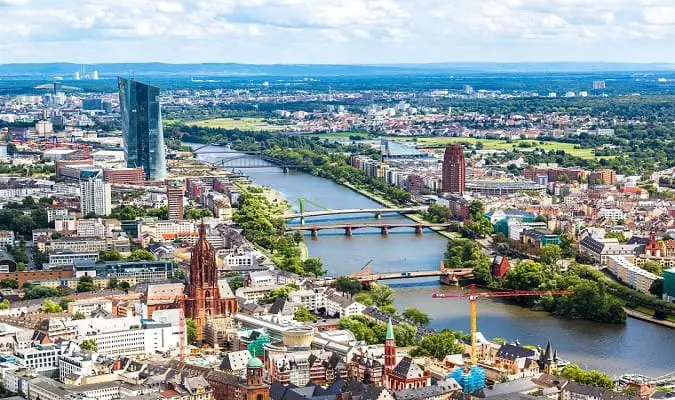
Frankfurt is an important commercial and economic center of Europe due to its central location in the state of Hessen , Germany .
This ancient imperial city is dominated by buildings and carries nicknames like “ Mainhattan ” and “ Chicago on the Main “.
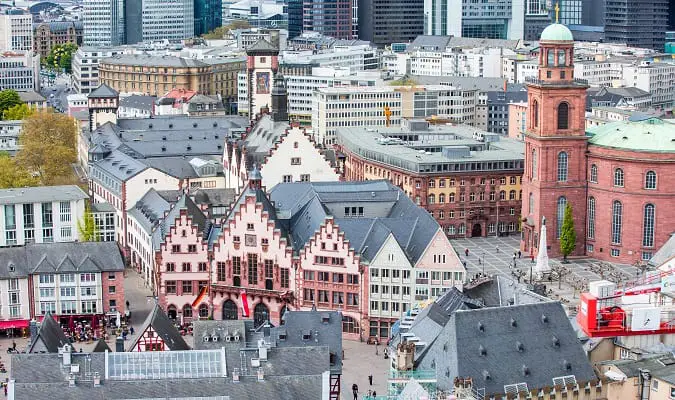
How to spend 3 days in Frankfurt Germany
In this 3-day itinerary in Frankfurt , discover the main attractions of the city.
Day 1 in Frankfurt
On your first day in Frankfurt explore the old town. Start by visiting the beautiful Römerberg , one of the symbols of the city. Several buildings and attractions are located on the square or in the surroundings such as St. Nicholas , Paulskirche , MMK , Frankfurt Cathedral .
Head to Iron Footbridge ( Eiserner Steg ) and enjoy the view of the Main river . Take a stroll along Goethestrasse , the city’s most elegant street with many luxury shops, and head to Goethe House . Hauptwache , another famous square, is located close to the Goethe House .
End the day by visiting the Main Tower for panoramic views of Frankfurt.
Things to see
- Paulskirche
- MMK Museum of Modern Art
- Frankfurt Cathedral
- Iron Footbridge
- Goethe House
Day 1 Itinerary Map
Day 2 – Day Trip from Frankfurt
On the second day, make a day trip to one of the nearby cities such as Würzburg or Heidelberg .
Day 2 Itinerary Map
Day 3 in Frankfurt
On the third day in Frankfurt start by visiting the Frankfurt Zoo , after a visit to the zoo pass by the Eschenheimer Turm , a tower from the 1400s that now houses a café and meeting rooms.
Another important building in the city is the Alte Oper, located on Opernplatz .
Head to the Senckenberg Natural History Museum , one of the most modern natural history museums in Europe .
- Frankfurt Zoo
- Eschenheimer Turm
- Senckenberg Natural History Museum
Day 3 Itinerary Map
Sights in Frankfurt
1. römerberg.
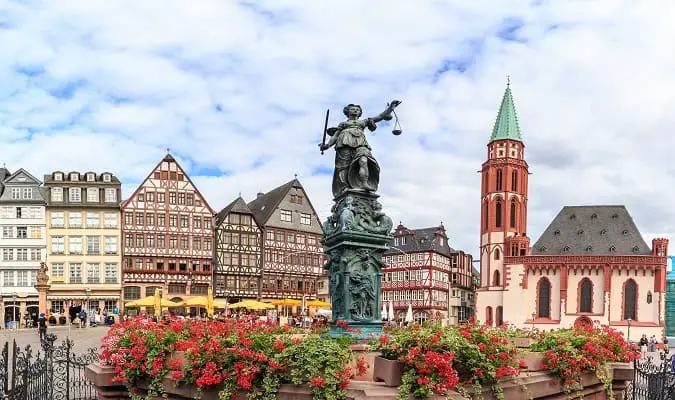
The Römerberg is located in the heart of the old town. The square has an irregular shape and in its center is located the Fountain of Justice ( Gerechtigkeitsbrunnen ).
Römerberg, 67354
2. Frankfurt Cathedral
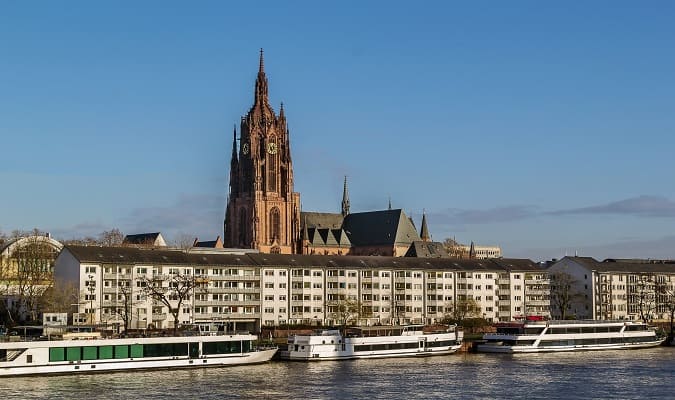
The Frankfurt Cathedral is located in the center of Frankfurt . It is dedicated to Saint Bartholomew . It was built in the 13th and 15th centuries in Gothic style.
Domplatz 1, 60311
3. Paulskirche
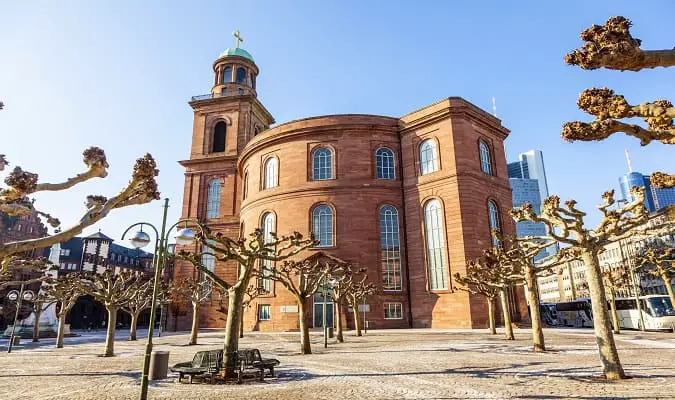
The Paulskirche is located on the Paulsplatz . It was built between 1790 – 1833 and restored in 1948.
The Church is important political symbolism in Germany and became in 1849 the seat of the Parliament of Frankfurt , the first publicly and freely elected German legislative body.
Paulsplatz 11, 60311
4. Alte Nikolaikirche

The Alte Nikolaikirche is one of the symbols of the city. It is located in the old town. The church has 51 bells, 4 are used to resonate and 47 are used for chimes.
Römerberg 11, 60311
5. Goethe House

The Goethe House where the greatest German writer Johann Wolfgang von Goethe was born and where he lived from his birth in 1749 until 1765, shows how his family and employees lived.
There are many rooms to be explored from the sumptuous decor of the dining room on the main floor to the top floor office where he wrote many first of his works.
Großer Hirschgraben 23-25, 60311
6. Naturmuseum Senckenberg
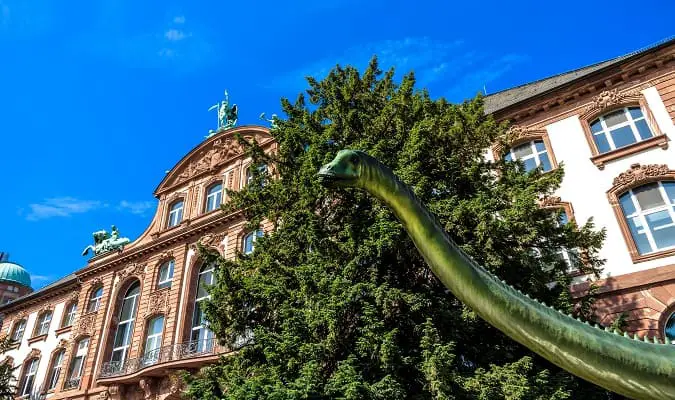
The Naturmuseum Senckenberg is one of the most modern natural history museums in Europe .
The museum houses Europe ‘s largest collection of large dinosaurs.
Senckenberganlage 25, 60325
7. Museum of Modern Art
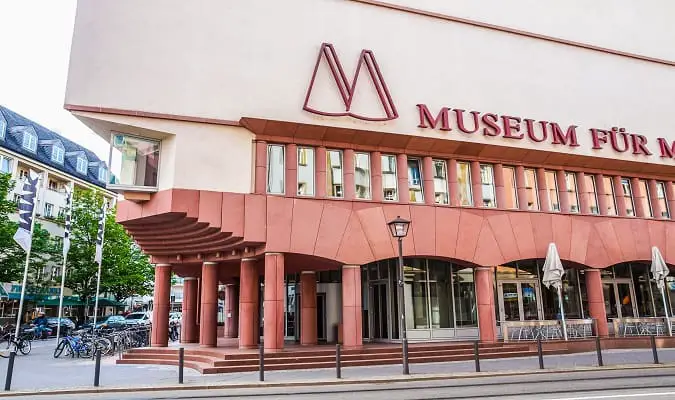
The Museum of Modern Art is considered to be one of the most important galleries in Europe of contemporary art. It was opened in 1991.
Domstraße 10, 60311
8. Alte Oper
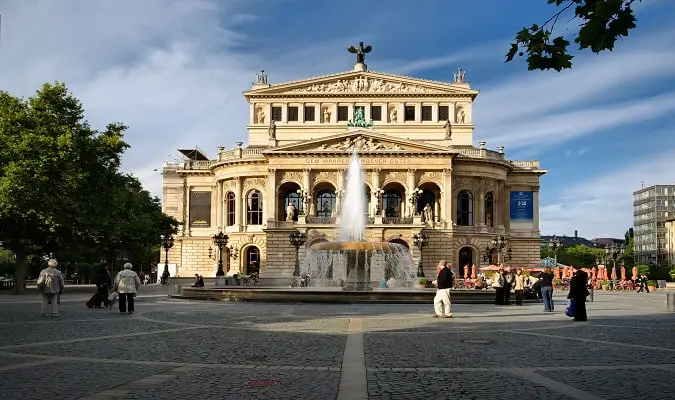
The Alte Oper was built in 1880. It is located in the heart of the Opernplatz .
It remains one of the most important concert halls in the city.
Opernplatz 1, 60313
9. Frankfurt Zoo

The Frankfurt Zoo is home to more than 4,500 animals representing at least 450 different species.
It is the second oldest zoo in Germany .
Bernhard-Grzimek-Allee 1, 60316
10. Palmengarten
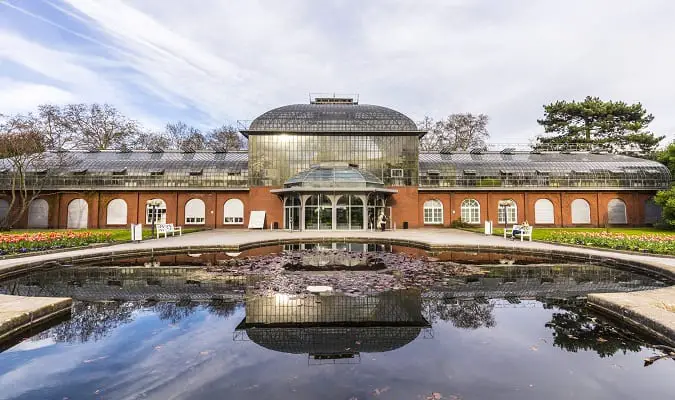
The Palmengarten is Germany ‘s largest Botanical Garden .
The gardens offer leisure facilities such as children’s playgrounds and picnic areas.
Siesmayerstraße 61, 60323
11. Hauptwache
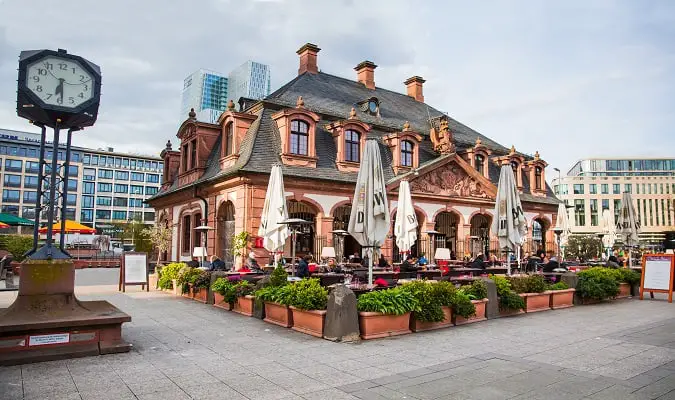
The Hauptwache area is undoubtedly one of the busiest pedestrian areas in the city.
It is famous for its mix of historic old buildings and recent modern structures.
An der Hauptwache
12. Eschenheimer Turm
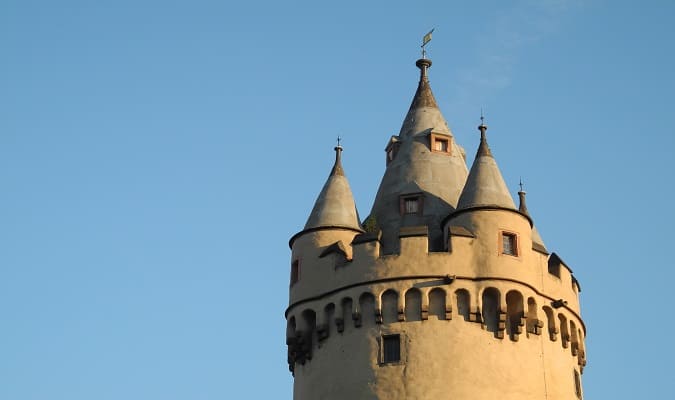
The Eschenheimer Turm was built in the early 1400s. It is 47 meters high and still impresses with its dimensions.
Today the tower houses a café and meeting rooms.
Eschenheimer Tor 1, 60318
13. Commerzbank Arena
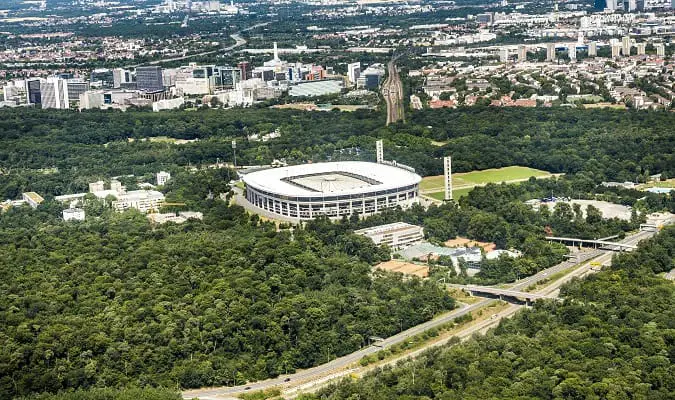
The Waldstadion has been updated several times. At the beginning of the new millennium, it was completely refurbished and received a new concept as the Commerzbank Arena .
Mörfelder Landstraße 362, 60528
14. Main Tower
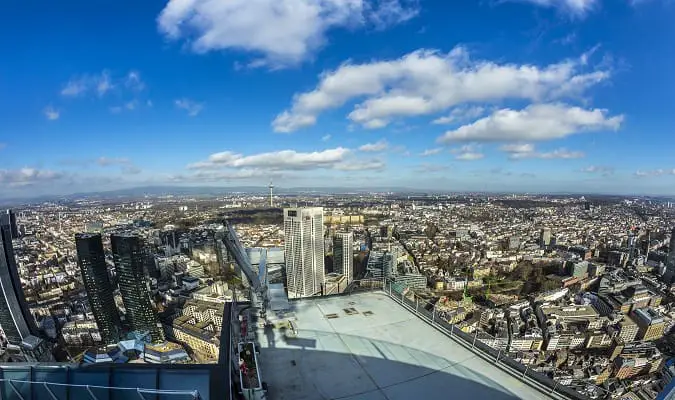
The Main Tower is 200 meters high. The construction of the Main Tower was completed in 1999, a tall building with a facade made entirely of glass was first built in Europe .
This building is particularly popular with people from Frankfurt and tourists. It has an observation platform accessible to the public with a restaurant.
Neue Mainzer Str. 52-58, 60311
Where to stay in Frankfurt
1. fleming´s frankfurt.
The Fleming´s Frankfurt is located 15 minutes by tram from the Frankfurt Messe .
Rooms are equipped with a flat-screen TV, minibar, safe.
Lange Str. 5-9, 60311
2. Hilton Frankfurt City Centre
The Hilton Frankfurt City Centre is located approximately 15 minutes walk from the Römerberg .
Rooms feature contemporary decor with a large window overlooking the city or park.
The hotel has a swimming pool and sauna.
Hochstraße 4, 60313
3. Marriott Frankfurt
The Marriott Frankfurt is located near the Messe .
Rooms are equipped with a flat-screen TV, minibar, safe, work desk.
Hamburger Allee 2, 60486
Malls and Department Stores in Frankfurt
The My Zeil is located near the Hauptwache .
Brands: Adidas, Bench, Guess, Pandora, Gant, Swarovski.
Zeil 106 1. UG- 7. OGU-Bahn Station Hauptwache, 60313
2. Karstadt Frankfurt
Karstadt is a German department store chain with many stores in Germany .
The company features brands like Cacharel, Clarins, Coach, Desigual, Estée Lauder.
Zeil 90, 60313
3. Skyline Frankfurt
The Skyline Frankfurt is located 850 meters from the Messe .
Brands: Marc O´Polo, Mango Kids, Mango, Pandora, Zara, Zara Home, Swarovski.
Europa-Allee 6, 60327
4. Galeria Kaufhof Frankfurt
Galeria Kaufhof is a German department store chain with many stores in Germany .
The company features brands like Esprit, S. Oliver, Tom Taylor, Gerry Weber, Tommy Hilfiger, Bugatti, Olymp.
Zeil 116-126, 60313
5. Hessen Center
The Hessen Center is located 7 km from the old town.
Brands: Bonita, Douglas, Tom Tailor, Vero Moda.
Borsigallee 26, 60388
6. Wertheim Village
The Wertheim Village is an outlet located in Wertheim 88.5 km (55 miles) from Frankfurt .
Brands: Fossil, Coach, Calvin Klein, Diesel, Gant, Escada, Lacoste, Versace, Tommy Hilfiger.
Almosenberg, 97877 Wertheim
Plan your Trip
Frankfurt has easy train access from various cities in Germany . Famous cities nearby: Mannheim , Heidelberg , Stuttgart , Koblenz , Wiesbaden .
Mannheim – 84.2 km (52.3 miles)
Heidelberg – 88.7 km (55.1 miles)
Stuttgart – 206 km (128 miles)
Koblenz – 127 km (78.9 miles)
Wiesbaden – 39 km (24.2 miles)
Cologne – 189 km (118 miles)
Würzburg – 119 km (73.9 miles)
Baden-Baden – 175 km (108 miles)
Book a Train Trip
Frankfurt Germany Map
Book your trip, book your accommodation.
Book your hotel with Booking.com as they consistently provide the cheapest and lowest rates.
Book Your Flight
Find cheap flights to Germany by using Momondo . Momondo is a flight search engine that searches a lot of different airlines, including many budget carriers.
Book a Train Ticket
Check the train routes and schedules with Omio . Omio is an authorized Deutsche Bahn ticket seller, which compares and combines transport options for complete flexibility.
Don’t Forget Travel Insurance
Travel insurance will protect you against illness, injury, and cancellations. It’s a protection in case anything goes wrong. You can book your travel insurance with Travelexinsurance.com .
20 Top Things to do in Frankfurt
10 Best Hotels near Romerberg Square Frankfurt
The Best Museums in Frankfurt
The Best Beer Gardens (Biergarten) in Frankfurt
Top 10 Hotels Near the Frankfurt Messe
10 Suggested Itineraries for Germany + Top Destinations
Outlets & Department Stores in Germany: Shopping Guide
40 Popular Train Routes in Germany
German States Map
German States and Regions

Perfect 2 Days In Frankfurt Itinerary
by Melissa Giroux | Last updated Nov 8, 2023 | Europe , Germany , Travel Tips
Frankfurt in Germany is one of the biggest financial hubs in Europe and, therefore, a popular expat destination.
Because of this, you may wonder, ‘Why visit Frankfurt as a tourist?’, or ‘Is Frankfurt worth visiting?’
Ready To Travel? Don't Go Without Travel Insurance.
Check Prices
Aside from the skyscrapers and banks, Frankfurt is full of things to do and see.
The city boasts over 20 museums and has various historical monuments scattered around towns, so it is ideal for those interested in history.
Frankfurt also has an abundance of markets to explore, especially around Christmas time, and you’ll find plenty of fabulous beer gardens and restaurants along the main river.
Most travelers find 2 days in Frankfurt to be enough time to enjoy all the main sights. So, if you’re wondering how many days in Frankfurt you’ll need – 2 days should be enough!
Therefore, we have put together this Frankfurt itinerary detailing everything to do, see, and eat on your upcoming Frankfurt city break.
Before we start, note that you could grab a Frankfurt Card for discounts on attractions, museums, and free public transportation.
Without further ado, let’s talk about the best things to do in Frankfurt so that you can plan your 2 days in Frankfurt.
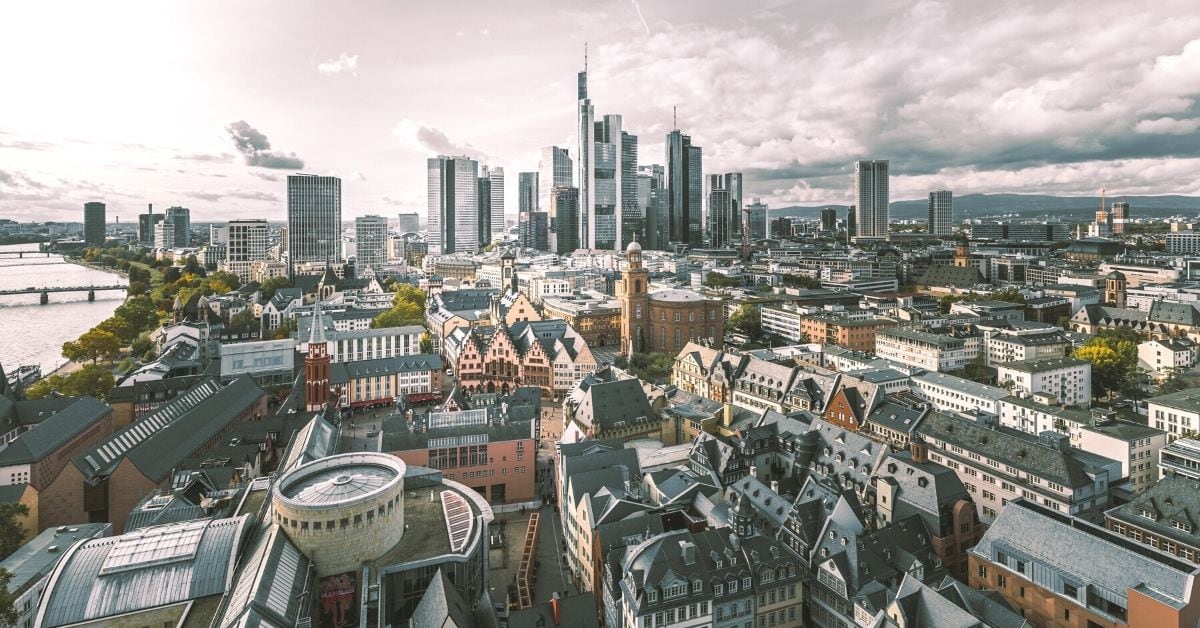
Day 1
For your first day in Frankfurt, you’ll get to enjoy the lovely old town, plenty of fascinating museums, and some fun nightlife!
Morning – Explore The Old Town
Begin your 2 days in Frankfurt by exploring the city’s central district. Frankfurt Old Town (Altstadt) is my favorite area.
It is one of the only parts of the city that has maintained its traditional look and feel after the 1944 bombings; therefore, it has the most ‘German feel’.
The old town is great to wander around at your peril, but you can also book a walking tour to learn more about the area’s history.
Start in Römerberg square to admire the timber houses and cobbled streets. Here you will find the town hall (Römer), a small medieval church, and the gothic-style Frankfurt cathedral.
Admission to the cathedral is free so head inside to see the renaissance fresco decorations and statues.
You can climb the 330 steps of the tower to enjoy some splendid city views, for a small €3 fee.
Altstadt is also home to Kleinmarkthalle, a huge indoor food market hall with over 60 vendors.
You will come across every type of food you can think of here and have fun tasting the German meats, cheese, bread, and wine.
You’ll also find delicious chocolates, cakes, and many new German delicacies.
Afternoon – Check Out The Museums
Once you can’t eat another bite, head south of the old town towards the river.
Then, walk across The Eiserner Steg (The Iron Footbridge) to enjoy expansive views of the city (and walk off all the food).
Once over the other side, turn right along the river promenade, and you will soon come to many museums.
Which museums you decide to spend your afternoon in will depend on your interests.
I recommend checking out the German Film Museum for some exciting and interactive displays.
Spanning over two floors, you will learn all about the history of film production, discovering everything from early optical illusions to trick photography.
Admission to the permanent exhibition is €6, but an extra fee exists to access any temporary exhibit.
Another museum that is well worth checking out is The Städel Museum.
This art gallery has an impressive collection, including 3,100 paintings, 660 sculptures, and more than 4,600 photographs.
These art pieces date as far back as the Middle Ages, all the way to the modern-day, housing 700 years of European art under one roof. Admission to The Stadel is €14.
Evening – Sachsenhausen & Brückenviertel Districts
When you tire of the museums, head inland towards the cobblestone district of Sachsenhausen.
Here there are some superb restaurants to unwind and fill your belly after the first of your 2 days in Frankfurt.
A dolf Wagner is a popular tavern-style eatery specializing in schnitzels and cider.
After dinner, move east towards Brückenviertel district for an array of cocktail and wine bars.
Hop between Jazz Café Bar, Gatzby, Drinksmith, and Old Fashioned Bar.
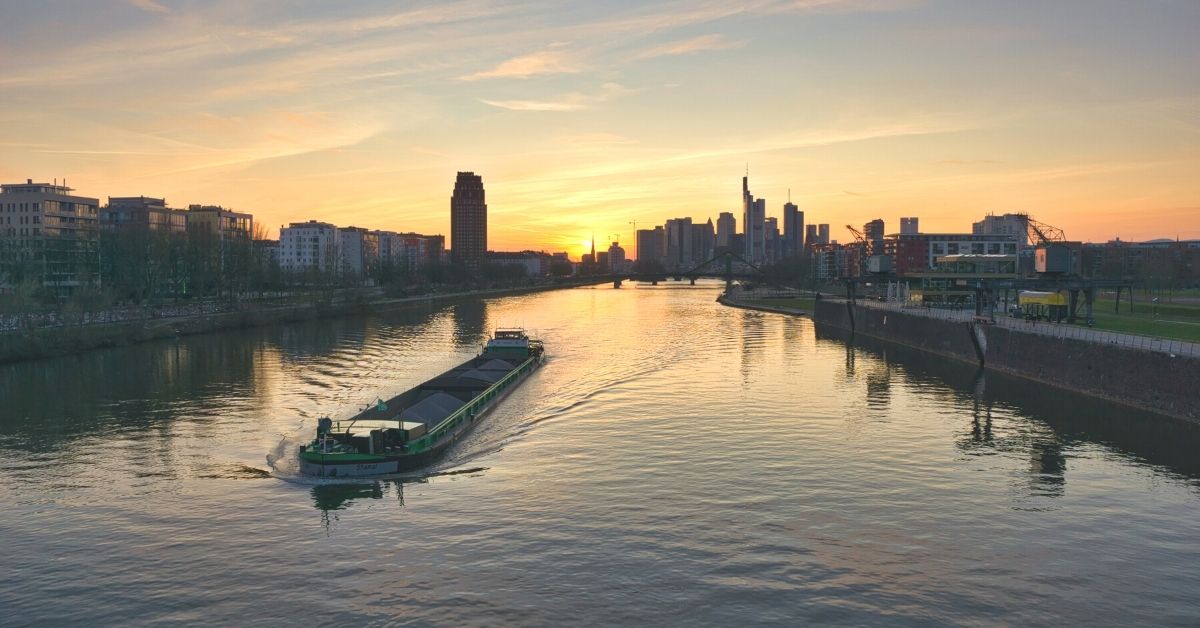
Your second day in Frankfurt is full of fun, but relaxing activities, like a river cruise, visiting the botanical gardens, and catching a concert at the opera.
Morning – Frankfurt Skyscrapers & Sightseeing River Cruise
Start your second day in Frankfurt slowly by enjoying breakfast and coffee at Cafe Karin in the old town.
There are many breakfast options to choose from, both sweet and savory. The cakes are delicious too!
After breakfast, walk west to the financial district to check out the city’s famous skyscrapers.
Main Tower, Euro Tower, and Willy-Brandt-Platz are the most impressive buildings.
At 11 am, head to the riverfront to catch the first sightseeing river cruise of the day.
Primus-Linie is a famous tour company that offers 50-minute boat trips, traveling two different routes.
You can choose to cruise upriver to Gerbermühle or downriver to Griesheim Lock.
If you can’t decide which one to take, combine both into an extended 100-minute trip. 50-minute trips cost €10, and 100-minute cruises are €14.
Browse Cruises
Afternoon – Relax In Palmengarten
Once you finish your cruise, enjoy lunch at the riverside eatery, MainNizza.
The food, service, and ambiance are all top-notch here, and the views are splendid.
After so much city exploration, spend the last afternoon of your 2 days in Frankfurt enjoying the nature the city has to offer.
Palmengarten is an enormous botanical garden north of the city center. The gardens are so enchanting that it’s easy to forget you’re in an urban area.
In the botanical garden, various greenhouses have different climates suitable for American, African, and Asian plants.
As well as the impressive array of plants, there’s a lake with boats and a small waterfall. After walking around the vast park, relax by the water or sip a coffee at one of the garden cafes.
Entry costs €7 and is worth every cent for the tremendous level of care the staff put into taking care of the grounds.
Evening – Watch A Concert At Alte Oper Or Oper Frankfurt
Alte Oper and Oper Frankfurt are Frankfurt’s two biggest opera houses. Therefore, if you’re a fan of the opera, enjoy a concert in one of these areas.
Both venues take a break in the summer, but you will generally find a production taking place most nights from late August to late May. Tickets start from €25, and the showtimes vary.
After the show, grab dinner in town. Then, if you’re not ready for the night to end and don’t have an early flight the following day, visit Jazzkeller for a couple of cocktails and some funky tunes.
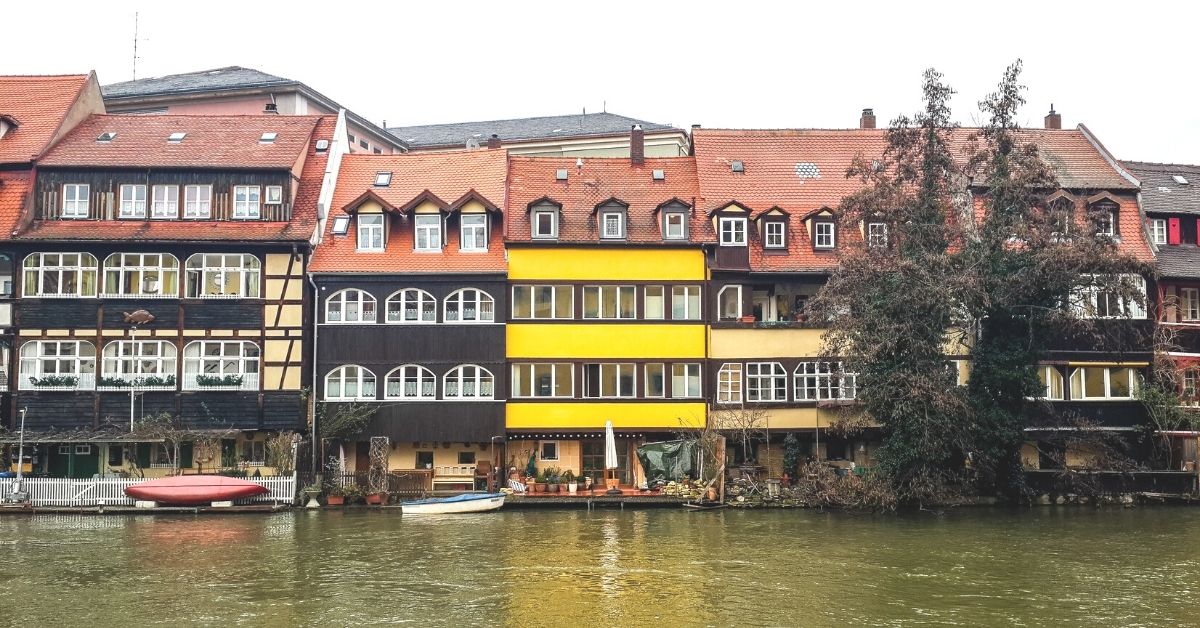
Is Frankfurt Worth Visiting?
Wondering if Frankfurt is worth visiting? We think so!
Why? See the main reasons why you should visit Frankfurt below.
- Frankfurt is a popular flight hub, which makes it easy to fly to.
- Frankfurt has a lot to offer, from museums to architecture to nightlife. This means you’ll have plenty of things to do in Frankfurt.
- The city is easy to navigate, and there is something for everyone.
That said, if you’re searching for a modern city to visit while in Germany, we recommend visiting Frankfurt.
We really believe Frankfurt is worth a visit.
Best Time To Visit Frankfurt
If you are planning a trip to Frankfurt, the best time to visit is during the spring, autumn, or summer months.
The weather is warm and sunny, making it the perfect time to explore all Frankfurt has to offer.
Several events and festivals occur during these months, so you will surely find something to keep you entertained. Just make sure to pack your sunscreen!
If you want to visit Frankfurt during winter, that is also a great time to come. The city is decorated with Christmas markets and lights, and you can enjoy a festive atmosphere while sipping on some mulled wine.
Just be prepared for colder weather, and make sure to pack your warmest clothes!
How Many Days In Frankfurt Is Enough?
Wondering if two days in Frankfurt is enough? The truth is that it depends on your arrival time and departure time.
For example, if you get to Frankfurt late, you won’t have a lot of time to make the most of your holidays in Frankfurt.
That said, looking at this 2-day itinerary in Frankfurt, you probably noticed it’s possible to see Frankfurt during a weekend.
If you arrive late, we suggest you add one more night so that you can fully enjoy your time in Frankfurt.
To help you figure out how many days you’ll need in Frankfurt, we suggest you list the things you wish to see and do. Then, look at the map and see if it seems realistic.
Adding the arrival time and departure time to your Frankfurt itinerary, you’ll see exactly how many days in Frankfurt is going to be enough.
If you decide to use Frankfurt as a base, you may want to rent a car and explore the area.
Where To Stay In Frankfurt For 2 Days
Wondering where to stay in Frankfurt?
You won’t be short of accommodation choices in Frankfurt, and you can enjoy staying in the city center no matter your budget.
Here are our top hotel recommendations for your 2 days in Frankfurt. You can browse the best hostels here .
Best Budget Accommodation
If you’re on a tight budget, you don’t have to slum it during your two days in Frankfurt.
Manhattan Hotel has modern and welcoming private rooms with ensuite bathrooms for a very affordable price. Single rooms cost €74 and doubles are €94.
Manhattan hotel boasts a convenient location opposite the city’s central train station. Therefore, this hotel is ideal for traveling to Frankfurt via train.
In addition, the hotel offers free WiFi and a breakfast buffet (for an additional cost), and the rooms are equipped with air-con and soundproofing.
Check Availability
Best Mid-Range Accommodation
Mercure Hotel Kaiserhof is a fantastic mid-range accommodation option in Frankfurt city center.
Standard double rooms cost around €150 a night, so it won’t cost you an arm and a leg if you only stay one or two days in Frankfurt.
The rooms are super modern and contain all the necessary amenities, such as air-conditioning, soundproofing, a coffee machine, and a lovely ensuite bathroom.
Moreover, the hotel is close to the train station, has a 24-hour reception, and offers a filling buffet breakfast every morning (at an additional cost).
Best Luxury Accommodation
If money isn’t an issue, stay at the luxurious Jumeirah Frankfurt hotel , located in the old town.
This modern high-rise hotel has sleek decor, a peaceful vibe, and the highest standard of customer service.
Facilities include a spa with tropical rain showers and saunas, access to the next-door fitness center and swimming pool, and an onsite restaurant serving breakfast, lunch, and dinner.
All the rooms feature a state-of-the-art climate control system, Nespresso coffee machine, and incredible skyline vistas.
A deluxe room costs around €500, but if you really want to splash out, you can stay in one of the suites!

Final Thoughts On Frankfurt Itinerary
Whether you’re traveling through Germany on a summer backpacking trip or planning your next trip to Europe , Frankfurt is well worth a visit.
With so much culture to explore and cuisine to taste, spending one or two days in Frankfurt is bound to be a fantastic experience because there are enough things to do in Frankfurt to keep you entertained.
However, be sure to follow an itinerary like ours to make the most of your short trip.
If you’re traveling to other destinations in Germany, consider renting a car for your German adventures.
We hope we managed to help you figure out what to do in Frankfurt, Germany.
Traveling to Germany soon? Learn how to buy a German SIM card .
Read one of the following guides:
- Best places to live in Germany
- Munich in 2 days
- Things to do in Fussen

MY TOP RECOMMENDATIONS
BOOK HOTEL ON BOOKING.COM
BOOK HOSTEL ON HOSTELWORLD
GET YOUR TRAVEL INSURANCE
LEARN HOW TO START A TRAVEL BLOG
LEARN HOW TO VOLUNTEER ABROAD

Best Hotels
48 Hours in Frankfurt
Day Trips From Frankfurt
Top Things to Do
Free Things to Do
Things to Do with Kids
Frankfurt's Best Museums
The Best Restaurants in Frankfurt
Nightlife in Frankfurt
Where to Try Apfelwein in Frankfurt
Best Time to Visit
Weather & Climate
Frankfurt Airport Guide
Neighborhoods to Know
Public Transportation
Getting Around Frankfurt: Guide to Public Transportation
:max_bytes(150000):strip_icc():format(webp)/ebephoto-5b7352c3c9e77c005080d5ad.jpg)
TripSavvy / Christopher Larson
Frankfurt is a common entry point into Germany because of its major international airport . From there, visitors disperse throughout the country and into greater Europe , but hopefully not before discovering what Frankfurt has to offer.
The financial hub of Germany has elevated itself from a purely business reputation to become a top German city to visit . It has numerous attractions from its world-class museums to events like the illustrious Book Fair to its eclectic eating and apfelwein (German apple cider) scene.
Public transportation allows visitors to easily travel all over the city and is easier, cheaper, and often faster than a car. The system consists of the U-Bahn (subways), S-Bahn (commuter trains), trams, and buses. It's run by the Rhine-Main Transport Association (RMV) and Verkehrsgesellschaft Frankfurt (VGF), one of Germany's largest public transport networks. The system is well-organized, safe , and fairly punctual, but it takes some practice to get comfortable. Use our complete guide to Frankfurt's public transport.
How to Ride Frankfurt's U-Bahn
The U-Bahn (underground) operates partly below ground and often works in connection with the tram system. Trains run every 2 to 5 minutes within the city center. Frequency slows to 10 to 20 minutes after 8 p.m., and night buses take over from 1 to 4 a.m.
There are nine combined U-Bahn/tram lines and almost 90 stations:
- U1–U3: These lines run from the southern railway station to the north of the city on one route, then split towards Nordweststadt (U1; red), Bad Homburg-Gonzenheim (U2; light green), and Oberursel (U3; dark purple).
- U4 (Pink): Runs from western Bockenheimer Warte through the Hauptbahnhof (main train station) to eastern Enkheim.
- U5 (Dark green): This is a combined tram and underground line from northern Preungesheim to the city center. It shares some underground stations with the U4.
- U6 (Blue): Runs from Heerstraße in the west to Ostbahnhof (East Station) in the east.
- U7 (Orange): Runs from the east in Hausen in the west to Bergen-Enkheim in the northeast.
- U8 (Light Purple): Runs from northern Riedberg to Frankfurt-Süd. It shares tracks with U1-3.
- U9 (Yellow) : Starts from the north at Nieder-Eschbach to Ginnheim in Nordweststat on the shared U2 line, as well as the shared U8 line. This is the only line that doesn't travel through the city center.
Use the RMV website to plan your trip , find timetables ( fahrplan ), and real-time departure/arrival information.
How to Ride Frankfurt's S-Bahn
The city's S-Bahn or Stadtbahn (city train) is the local rail which runs primarily above ground from the city center to the surrounding suburbs and cities. The area around Frankfurt is densely populated and the S-Bahn offers easy access to the outskirts of the city, as well as the surrounding cities like Mainz , Wiesbaden, and Hanau.
The S-Bahn runs as frequently as every three minutes during peak times, and every 15 to 30 minutes during the night or on the outskirts. Service starts at 4 a.m for some lines, with full service from 6 a.m. to 8 p.m. on all lines. The last S-Bahns leave Frankfurt at 1:20 a.m. The S8 and S9 lines run 24 hours a day. The tickets offer access to the S-Bahn as well as the rest of Frankfurt's public transport system.
S-Bahn stations can be identified by the green and white "S" symbol. Enter the platform and once you have a ticket, stamp it and board the S-Bahn. Maps are available on the platform and electronic boards provide info on the next arrival.
Frankfurt's S-Bahn covers 9 lines and 112 stations.
- S1: Wiesbaden – Frankfurt-Höchst – Frankfurt – Citytunnel – Offenbach Ost – Rödermark-Ober Roden
- S2: Niedernhausen – Frankfurt-Höchst – Frankfurt – Citytunnel – Offenbach Ost – Dietzenbach
- S3: Bad Soden – Frankfurt-West – Frankfurt – Citytunnel – Langen – Darmstadt
- S4: Kronberg – Frankfurt-West – Frankfurt – Citytunnel – Langen (– Darmstadt)
- S5: Friedrichsdorf – Frankfurt-West – Frankfurt – Citytunnel – Frankfurt-Süd
- S6: Friedberg – Frankfurt-West – Frankfurt – Citytunnel – Frankfurt-Süd
- S7: Riedstadt-Goddelau – Groß-Gerau Dornberg – Frankfurt Hauptbahnhof
- S8: Wiesbaden – Mainz – Frankfurt Airport – Frankfurt – Citytunnel – Offenbach Ost – Hanau
- S9: Wiesbaden – Mainz-Kastel – Frankfurt Airport – Frankfurt – Citytunnel – Offenbach Ost – Hanau
For a complete map for the S-Bahn routes, visit the RMV website.
How to Ride Frankfurt's Buses
Buses fill in some of the gaps in Frankfurt's public transport system. All major routes are served by rail-based modes of transportation, but stops are closer together and buses can be a good way to orient yourself with the city. Where buses are most useful is in the north between S-Bahn stations and at night.
Bus stops are marked by a circular sign with a green "H." They often have a small shelter and electronic sign updating arrivals, as well as posted regular schedules and routes. Tickets can be purchased from machines at S- or U-Bahns or directly from bus drivers. If you have a ticket that is not time-stamped, stamp it with the machine near the entrance of the bus.
Night Buses in Frankfurt
Between the hours of 1 a.m. and 4 a.m., U-Bahns and S-Bahns have reduced or paused service and night buses replace those lines as they run 24 hours a day. Nachtbus lines have numbers beginning with "N." Tickets cost the same as daytime transport.
Tickets on Frankfurt's Public Transport
Regular tickets ( einzelfahrt ) cost 2.75 euros (1.55 euros discounted) and allows for travel on all forms of transport. Zone 50 includes most of Frankfurt, excluding the airport.
Tickets are time-stamped and valid for two hours of travel beginning immediately. It allows for unlimited transfers in one direction. For example, you can travel around the city on a single ticket for 120 minutes from the time the ticket was stamped, but you can't go in one direction then come back the same way. Children under 6 do not need tickets and reduced fare is available for children 6 to 14.
There are also other ticket options:
- All-day ticket (Tageskarte): This costs just a little more than two single journeys at peak times. The fare is generally 5.35 euros (3 euros discounted). Tickets are valid from time of purchase to end of operations that day. Note that day tickets purchased at price level 3 valid for use in Frankfurt (fare zone 50) are not valid for travel to Frankfurt Airport.
- Kurzstrecke : A short-trip ticket valid for journeys up to 1.2 miles (2 kilometers) away. It costs 1.85 euros.
- Gruppentageskarte (all-day group ticket): This day ticket is valid for up to five people and costs 15.80 euros (it excludes airport transfers).
- Frankfurt Card : For 23 euros, up to five visitors can utilize all the transport options for 24 hours plus travel from Frankfurt Airport or Frankfurt HBF, and get discounts on main attractions.
- Wochenkarte (weekly pass): Valid for seven consecutive days.
Tickets can be purchased via touch-screen ticket machines ( fahrkartenautomaten ) in S-Bahn and tram stations, RMV outlets, or on the RMV app. The app can be used in English. If traveling inside Frankfurt, the red button "Stadtgebiet Frankfurt" purchases a basic ticket.
Machines have an English language option (as well as several others). Machines accept euro coins and notes (up to 10 or 20 euros) and chip-and-PIN credit cards.
You must be in possession of a valid ticket on public transport and it's largely on the honor system. However, you need to show a ticket when entering buses and when ticket controllers—both uniformed and plain clothes—ask to see your ticket by saying " Fahrscheine , bitte" (Ticket, please). If caught without a ticket, you are subject to a 60 euro fine and controllers are infamously unsympathetic.
Accessibility on Berlin's Public Transportation
Entrance to the U-Bahn and S-Bahn is barrier-free and escalators and elevators service most stations - but not all. At www.traffiq.de there is a list of all stops and stations that are barrier-free.
On trams and buses, look for doors marked with wheelchairs or strollers for the best cars for wheeled travelers. Frankfurt's tourism board offers information for barrier-free travel for visitors with disabilities.
Other Modes of Transport in Berlin
- Taxis: Taxis are available throughout the city at taxi stands, airport and train stations or by reserving ahead. Taxis are cream with a “TAXI” roof sign.
- Car Rentals: Renting a car is not necessary for travel within Frankfurt, but can be helpful for traveling around the country and exploring the world-famous Autobahn . Refer to our full guide on car rentals in Germany for more information.
- Trains : Deutsche Bahn transports millions of travelers in Germany and beyond every day. The earlier you purchase tickets, the cheaper they will be. Regional day tickets, weekend tickets, or day tickets for all of Germany are offered so check for discounts.
- Bikes: Biking is a good way to travel around Frankfurt. Second-hand bikes are usually inexpensive, although you should get a receipt as bike theft is rampant. If you only need a bike for a short period of time, use one of the many bike-sharing programs. Also note that bikes can be taken on Frankfurt’s metro system for free, but they may be refused during peak hours.
Tips for Getting Around Frankfurt
- Public transport vastly slows between the hours of 1 to 4 a.m. Note that some lines still run during these nighttime hours, particularly the Nachtbus .
- Though travelling by taxi in the city center is easy to do, there are times during major conventions (like the Frankfurt Book Fair ) where finding a taxi can be near impossible.
The Best Time to Visit Frankfurt
The Top 9 Day Trips From Frankfurt
The 9 Best Neighborhoods in Frankfurt
Frankfurt with Kids
Weather in Frankfurt: Climate, Seasons, and Average Monthly Temperature
48 Hours in Frankfurt: The Ultimate Itinerary
Your Trip to Frankfurt: The Complete Guide
Nightlife in Frankfurt: Best Bars, Clubs, & More
Frankfurt Apfelwein
Best Things to See and Do for Free in Frankfurt
How to Travel From Frankfurt to Berlin by Train, Bus, Car, and Plane
The Best Museums in Frankfurt
7 Ways to Enjoy Frankfurt in Spring
How to Travel From Frankfurt to Munich by Plane, Train, Bus, or Car
The Top 10 Restaurants in Frankfurt

Home » Travel Guides » Germany » 15 Best Day Trips from Frankfurt
15 Best Day Trips from Frankfurt
The central German city of Frankfurt, located on the river Main, is often referred to as the Gateway to Europe, but there’s actually a whole lot going on in the city itself.
It’s a charming place to wander round, what with its impressive Gothic architecture and futuristic skyline, and there are plenty of museums and galleries to pique the interest.
As the business and transport hub of Germany, Frankfurt is also a diversely peopled city, with everyone from wealthy bankers to student dropouts populating its streets.
It’s a very interesting destination for a visit, and there are also some really great day trip options available further afield, due to its great location.
1. Heidelberg

Arguably one of the most beautiful cities in Germany, Heidelberg is an excellent day trip option, what with its imposing castle ruins and prestigious university.
Travel along the Neckar River to reach the city, and once there allow yourself plenty of time to wander among its beautiful buildings, spanning across historic periods from the Renaissance to the Gothic.
From the castle you can experience some fantastic views from the terrace, and spot one of the largest wine barrels in the world.
The town centre is full of gems too: the Knight’s House, the Old Bridge, and the Church of the Holy Spirit are all intriguing.
Plus, the cramped lanes lined with half-timbered houses are a sight in themselves.

The Rhine Valley is a UNESCO world heritage site, and it’s easy to see why.
Skirted with postcard-perfect villages, and packed full of castles at the highest density in the world, the valley is a gorgeous place to spend the day.
Exploring by boat is a great option, as you’ll get to see all its glory from the tranquillity of the water.
If it’s summertime, you can take a ride on the cable car down into the valley, before you grab lunch on the banks of the river.
There are also some excellent wine options available – try the tavern in Rüdesheim.
3. Wertheim Village

If shopping is on your mind, the Wertheim Village is absolutely the only place to do it from Frankfurt.
Over 110 luxury boutiques populate the area, including Versace, Tumi and Ralph Lauren – and this is a great way to save a bunch on the top brands.
Only an hour away from the city, this is a truly indulgent place to visit: spend time wandering the shops, eating at the on-site establishments, and hopefully going home satisfied with your purchases.
With savings of up to 60% it just might be the best trip you take.
4. Rothenburg

The well-preserved medieval town of Rothenburg is a very popular place to visit from Frankfurt.
On your way there you’ll pass along the Romantic Road, worth the trip in itself, and once you arrive in Rothenburg you certainly won’t be disappointed.
Take a guided tour around the historic centre, and learn about the intricacies of its history, from the half-timbered houses, to the church, the town hall and the turrets of the city gates.
You can also visit the intriguing Kriminalmuseum.
5. Eltz Castle

Perched on the Moselle River, Eltz Castle is an impressing sight, rising out of the trees with its turrets and spires.
Over 850 years of history awaits you in this perfectly preserved historic site, and much of the furnishings are original too.
Inside you can explore the various rooms of the castle, including a medieval kitchen and the knight’s hall, as well as all of the weaponry, armour, hangings and paintings lining the walls.
In the treasury you’ll find still greater intrigue, in over 500 pieces of precious art.
6. Neuschwanstein Castle

A fairy tale castle like no other, Neuschwanstein Castle is on many people’s bucket lists, so it’s a fantastic place to visit from Frankfurt.
Perched on the top of a hill near the village of Hohenschwangau, this 19th Century Romanesque Revival castle is visited by more than 1.3 million people a year.
It was originally commissioned by Ludwig II of Bavaria as an homage to Richard Wagner, and paid for using his own fortune.
This is truly an impressive site, and is also thought to have been the inspiration behind the Disney film, Sleeping Beauty.
7. Baden-Baden and the Black Forest

So good they named it twice, the spa town of Baden-Baden lies a mere 90-minute drive away from Frankfurt along the river.
The main attraction here is of course a soak in its therapeutic thermal springs, whether in the cheaper public baths or from a more exclusive resort location.
There’s also lots to explore on foot, from boutique shops, to the chateau-like Kurhaus, dating back to the 19th century.
While you’re here, it would be remiss of you to miss the chance to explore the gorgeous Black Forest, one of Germany’s main highlights.
Its rolling hills and dense forest are dotted with picturesque villages, and there are plenty of options for hiking around, including a trip to the highest waterfall in Germany.

The picturesque old town of Hanau sits just 20 kilometres away from central Frankfurt, making it an easy place for a day trip.
Not only is it chock full of pretty buildings, it also has an excellent claim to fame, in being the birthplace of the Brothers Grimm, the authors of many well-known fairy tales.
If you can, time your visit to coincide with the Brothers Grimm Festival.
Aside from the fairy tale connection, there’s a marketplace, the impressive new town hall, and the goldsmith’s house with some stunning jewellery on display.
If you run out of things to do, there’s also a Baroque palace located just a few kilometres out of town, which is home to the Hanau Historical Museum.

The richly historical city of Mainz is located on the west bank of the Rhine, only 44 kilometres from Frankfurt.
This cathedral city has a whole host of attractions to be explored, including several excellent museums, and of course, its impressive cathedral.
The cathedral began being constructed in 975 AD, though many of the tombs were added in the 11th century, and it towers above the city with its six spires.
Museums of note include the Roman-Germanic Central museum and the Museum of Ancient Navigation, which houses full-scale replicas of Roman ships.
10. Strasbourg

Located just the other side of the Black Forest lies the perfect opportunity to spend the day in another country: France.
Strasbourg is the capital of Alsace, and its old quarter is delightfully dotted with half-timbered buildings and cobblestone streets.
The town centre is a UNESCO world heritage site.
Strasbourg is also a very cosmopolitan city, what with it being the location of the headquarters of the European Parliament, and is also home to many excellent cuisine options.
La Petit France, as Strasbourg is also known, is a canal city, meaning you can take the chance to hop on a boat and explore by water.
11. Schloss Büdingen

The old town of Büdingen is a more than a pleasant place to spend the day, with plenty of historical attractions to whet the appetite.
Even the walls of the town itself date back to the 15th century.
Stroll along to the market place, where you’ll spot the old town hall from the Late Gothic period, which also houses an excellent museum exploring the folk traditions of the area.
The Schloss Büdingen nearby is also well worth a visit.
Built in the 13th century it also hosts a museum and a Gothic chapel.
12. Darmstadt

For something a bit different from quaint houses and Gothic architecture, a trip to Darmstadt is an excellent option.
Art Nouveau is the theme of many buildings here, and it’s certainly obvious from the moment you step through its quiet streets.
In 1899 Grand Duke Ernst Ludwig founded an artists’ colony in Darmstadt, in the impressive Mathildenhöhe.
There are heaps of art exhibitions throughout, and several museums can be visited throughout the city.
For a good view, climb the Hochzeitsturm.
13. Wiesbaden

Another option for a spa-based day trip, if one wasn’t quite enough for you, is the pretty town of Wiesbaden.
You can spend the day hopping from bath to bath quite easily, though if you feel like working for your pampering, you can climb up nearby Neroberg hill, who’s Opel Baths sit on top.
Start the day from the market square, from which you can wander in almost any direction and find suitable relaxation.
The Fountain Colonnade is perhaps the most well-known, but there’s also the Aukammtal district, the Kochbrunnen, and the Kaiser Friedrich baths.
14. Frankenstein Castle

Spoiler alert: this castle is exactly what it sounds like.
English author Mary Shelley visited the area in 1814, and it is thought that this castle is part of what inspired the gothic story of Frankenstein, which was released two years after her visit.
It’s got an excellent haunted history, with stories ranging from ghosts, to witches, to crazy alchemists, who are all supposed to have inhabited the place throughout the centuries.
More than 750 years old, and starting to crumble, this is a fascinating spot to visit.
15. Nuremberg

The second largest city in Bavaria is certainly worth a stop on your itinerary around Frankfurt.
Its long history begins in the Middle Ages, but nowadays it is most often spoken of for its importance in the Nazi regime.
You can explore this side of its history in the Documentation Centre, but if you want to steer clear of that tragic era, there’s the castle to visit, nightlife and cuisine to be sampled, and if you time your visit for the right time of year, some fantastic Christmas markets to be explored.
15 Best Day Trips from Frankfurt:
- Wertheim Village
- Eltz Castle
- Neuschwanstein Castle
- Baden-Baden and the Black Forest
- Schloss Büdingen
- Frankenstein Castle

Home » Destinations » Europe » Germany » 5-14 Day Germany Itinerary: A Guide For Planning Your Perfect Germany Trip
5-14 Day Germany Itinerary: A Guide For Planning Your Perfect Germany Trip
Links in this article may earn us a little money if you book/ order stuff. More here .
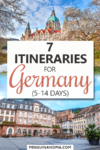
Plan Your Perfect Germany Itinerary with These Detailed Templates!
If you’re looking to plan the perfect trip around Germany, you are in luck! We’re passionate about exploring Germany because it’s a great country – and because Lisa is German!
Jokes aside, we’ve been lucky enough (and have made it a point) to see lots of different parts of the country – from the sea in the north to the mountains in the south. That said, Germany can be a tough country to plan a route or road trip through because there is just so much to see and do!
So, whether you’re looking for the best week in Germany or a Germany itinerary that covers 5 days or 14 days – here’s our master guide with 7 detailed Germany itineraries by train and/or by car! We’ve got cities, attractions, hotels and accommodations, directions, and distances to help you plan the best Germany travel route for you!
We’ve got other great posts to help you plan a visit to Germany:
- Must-Knows + Tips for Travelling to Germany for the First Time
- Helpful German Phrases to Get You By
- Discover 30 Beautiful Places in Germany
- Our Top Hostels in Germany (Stayed at all of them)
Table of Contents
Things to Consider When Travelling in Germany
Before you plan your trip to Germany, there are some things that you should know and keep in mind to make planning easier and to have a successful trip. While you probably know that the currency used in Germany is the Euro, here are some other topics that you should consider as well.
Best Time of Year to Visit Germany
Germany is actually a destination that you can visit year round – but it is important to plan accordingly and go in with the right expectations. If you’re planning a trip during the spring – let’s say from March to May – you could absolutely have beautiful weather… but it may also just rain a lot.
Unfortunately, the weather can be quite difficult to predict. However, as long as you prepare for different possibilities, you can have a great time no matter the weather! Generally you can say that Germany has a moderate climate with cool and rainy winters (more snowy the farther south you get) and warm – but not overly hot – summers.
July and August are usually the warmest months with an average temperature around 20°C. However, there can be days where you have 30°C. Of course, this can vary depending on the exact location you’re travelling to. Often, it is colder by the north coast than it is farther south.
We would honestly recommend that you avoid visiting the country in July if you dislike crowds since this is when the majority of kids are on their summer break from school. As a result, some cities can get quite busy.
Typically, we would recommend travelling in May or June and then from the end of August until the end of September (or even the middle of October). However, there is also a great reason to plan a Germany trip during the winter because of the many beautiful Christmas markets that you could visit at that time of year!
Public Transportation in Germany
Public transportation in Germany is quite good, especially when compared to North America. Yes, sometimes us Germans like to complain about the “Deutsche Bahn” – the German train company – but at the same time we are also super glad that it exists and works well.
If you’re wondering: Yes, all the itineraries mentioned below can absolutely be done if you want to take the train (minus the odd day trip to a castle here and there). If you want to check a train connection and/or buy tickets in advance you can do so on the DB Website . Alternatively, you can also download the DB app to your phone. We both have it and use it regularly.
As an alternative to the train, you can sometimes also use the bus to get from one city/town to another. Since 2013 (before this date it wasn’t allowed), long distance buses have established their presence in more and more cities and are now a popular way to get around for people who are more conscious of their money.
Unfortunately long distance train tickets can sometimes get quite expensive if you don’t book in advance – so the bus can be a good alternative in some cases.
The most popular long distance bus company in Germany is probably Flixbus. We have also used them multiple times to get between cities. If you want to look at the schedule and/or book a ticket, you can do so on their website .
In addition to the trains and long distance buses, the public transport within the cities is also usually pretty good – especially in bigger centres. Many of the cities – or transport associations – have their own transport apps. So, if you know where you are going and plan on using the local buses, trams, metros, etc. then downloading the local transport app would be a great idea!
Car Rental in Germany
If you want to rent a car and plan a Germany road trip, then that is certainly an option as well. Driving in Germany is generally pretty safe and people are not usually as reckless as in some countries in the south of Europe. However, it can get a little crazy in bigger cities like Berlin or Munich – especially if you are not used to driving in bigger centres.
In Germany, you drive on the right side as it is done in the United States, Canada, and many other countries as well. You have probably heard of the “Autobahn” – that’s simply the German name for our highway system. If you follow any of these itineraries, you’ll drive on many different highways.
While it is true that there is no speed limit in some parts of the Autobahn, there are lots of sections where there are actually speed limits in place. You can usually find limits imposed at/around construction zones along the way – so don’t think you can just speed all the time.
And PLEASE don’t drive on the Autobahn like you would on a highway in the United States or Canada – pass on the left and then get back over . If you’re going slower than other cars, there’s no need for you to be in the left (or even in the middle) lane. You can probably tell that this is something that Lisa complains about in Canada frequently, haha.
Since Germany is such a popular destination, there are lots of different rental car agencies to choose from. You can compare prices from different agencies for the duration of your trip with this handy rental car comparison tool . Please make sure to read the fine print so you know whether you need extra insurance, etc.
Also please be aware that many people in Germany drive cars with a stick shift. Rental cars with automatic transmissions exist, but the numbers available are usually lower and these cars might be slightly more expensive.
We’d also recommend that you reserve an automatic car well in advance if you need one – just so you can make sure that one is available for you. It probably wouldn’t be fun learning how to drive a stick shift while on a road trip in a foreign country.
Travel Insurance for Germany
If you’re planning a trip to Germany and you’re not from another EU country, then you should make sure to get travel insurance for the duration of your trip!
While you’ll probably be fine, accidents do happen and it could get really expensive if you’re not covered. That’s why we always travel with insurance.
If you live in another EU country and have health insurance there, you can get the blue health insurance card with which you are covered in other EU countries in emergency cases, as well.
If you don’t have that option – or are from outside of Europe – we recommend that you get private travel insurance.
Germany Itinerary 5 Days
If you only have a few days to travel through Germany, then have a look below at the two 5-day itineraries we have created. For these itineraries, we have assumed that you are not already in the country so they all start and end in bigger cities.
This should help make it easier for you to fly in/out of an airport with good connections if you are coming from overseas.
Depending on your preferences, you can choose between a trip through the northern part of Germany or a trip through the south of the country (mainly Bavaria). If you are interested in bigger cities and/or harbours, then we’d recommend the northern route.
In case you prefer half-timbered houses and beautiful old towns, then you should have a look at the southern route instead. Of course, you can always modify any itinerary to better suit your interests!
Germany Itinerary 5 Days – North
This 5-day Germany itinerary through the northern part of the country can certainly be considered a “sampler-type” of itinerary since you get to see the two biggest cities in the country – but not much more than that.
That’s completely fine though – you can only see so much in five days anyway. If you are interested in bigger cities and don’t have more than a few days, then this itinerary would be great for you!
The total driving time for this itinerary would be about 5 hours 30 minutes with a total distance of approx. 520 km. Of course, this can change depending on the route you are taking and the time of day you are travelling. Commuter traffic could add quite a bit of travel time to your journey.
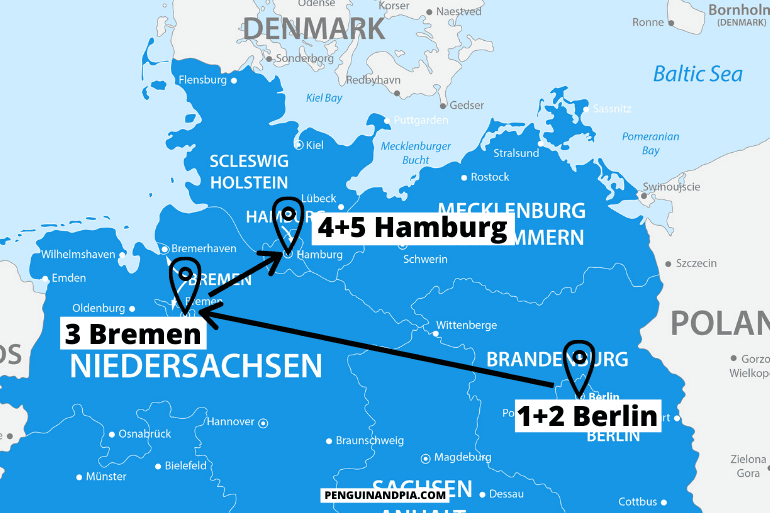
Day 1+2: Berlin Day 3: Bremen Day 4+5: Hamburg
Day 1+2: Berlin
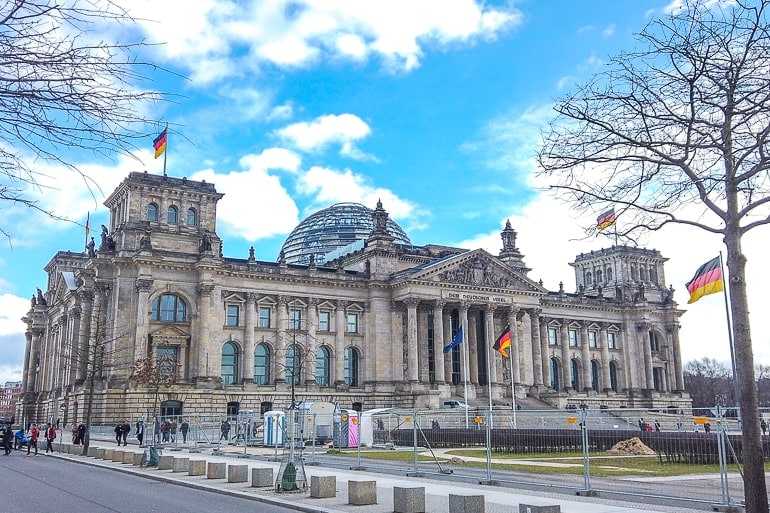
Berlin is a great place to start your adventure since it is the German capital, has multiple airports close by, and has really good train connections.
Since Berlin is such a popular tourist and business city, the car rental industry is well established and there are many different rental agencies to choose from.
— Compare prices from rental car companies in Berlin here
However, since you are only visiting bigger cities on this relatively short itinerary, we believe that a rental car is probably not necessary. Instead, for this trip, it might make more sense to take the train.
Since Berlin is such a big city with lots of things to do, it is worth it to spend (at least) two days in the city. So, remember to book your accommodation in Berlin for two nights .
Accommodation in Berlin : Berlin is a massive sprawling city with loads of different areas to stay and different accommodation options. You can check here for accommodations and hotels in Berlin .
If you are travelling to Berlin with a car, you’ll need a place to park. Check out Park Plaza Wallstreet Berlin Mitte for a stay right in the middle of the city close to Museum Island and other top attractions. It also has a tasty breakfast. Park Plaza has free parking on the street near the hotel (if available) or else it’s for a fee (but a reasonable price considering you’re in the middle).
If you are arriving into Berlin by train, you can check out NH Collection Berlin Mitte am Checkpoint Charlie . Located in the city centre right near the top sight “Checkpoint Charlie”, this popular hotel is in the heart of the action/attractions and is easy to get to via modes of public transit (metro – called the “U” for U-bahn).
If you are searching for a hostel/hotel, check out PLUS Berlin . Located over near the East Side Gallery (the piece of the Berlin wall with the artwork on it), Eric stayed here and really liked it! It’s also very easy to get to using public transit and is close to other areas to go out, etc.
Must-see Attractions in Berlin:
- Brandenburg Gate
- East Side Gallery (Berlin Wall)
We have also written a whole article about classic tourist attractions in Berlin in case you’d like some more inspiration. If you’re looking for some tips on how you could spend a day in Berlin, have a look at our One Day in Berlin Guide .
Day 3: Bremen
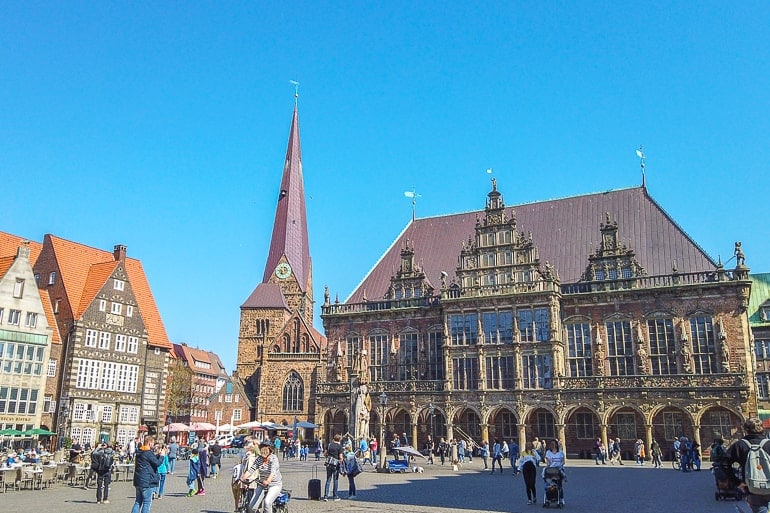
On the third day of your 5 days in Germany, you’ll head for Bremen. We’d recommend that you do the drive/train ride in the morning so you have enough time to explore the city once you get there.
Bremen is a hanseatic city with a nice old town – the market square with the town hall and the cathedral is especially popular. In German-speaking countries, the city is also known for a tale called the “Town Musicians of Bremen” by the Brothers Grimm. You’ll come across the animals of the tale (donkey, dog, cat, and rooster) many times as you stroll through the city.
The drive from Berlin to Bremen will take you approximately 4 hrs 10 min by car , but only around 3 hrs by train . If you take the train, try to book in advance if you can as this will usually save you some money.
Accommodation in Bremen: Bremen is a popular city to explore and it’s also on the larger side so you’ll find plenty of accommodations to suit your needs. There are hotels in the city centre/old town which put you within walking distance of the river and top attractions. You can check here for accommodations and hotels in Bremen .
For a popular choice in the historic middle, you should check out the very popular Radisson Blu Hotel Bremen . Funny story – we know there’s underground parking because we parked there when we visited Bremen by car.
If you want to stay closer to the train station just outside the historic centre (but still very central), check out the Dorint City-Hotel Bremen . This lovely and also very popular hotel is close to the pretty Windmill and flower gardens and has water views just outside the old city walls.
Must-see Attractions in Bremen:
- Marktplatz with Town Hall and Cathedral
- Böttcherstraße
- Schnoorviertel
If you want some more tips for Bremen, have a look at our detailed Things to do in Bremen Guide .
Day 4+5: Hamburg
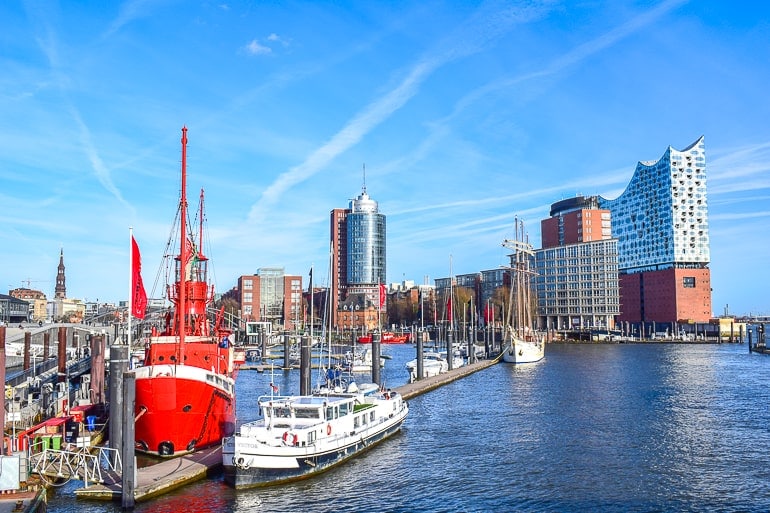
Hamburg is the second-biggest German city and the last stop on this short itinerary. We have been to Hamburg numerous times now and it is actually one of our favourite bigger German cities. You’ll find that the atmosphere of the city is very different than in Berlin. Not necessarily better or worse – just different.
Interesting (and slightly irrelevant) fact: The cities you visit on this itinerary are the three city states that exist in Germany in addition to the 13 area states such as Bavaria, Nordrhine-Westphalia etc.
The drive from Bremen to Hamburg is actually pretty simple and should only take around 1 hour 30 minutes by car and just around 1 hour if you take an ICE (fast train) . The train connection between these two cities is great with trains running pretty frequently. That should make it quite easy to find a train connection that works for your schedule.
Accommodation in Hamburg : Hamburg is popular city with loads of different accommodations and areas to stay in. You can check here for accommodations and hotels in Hamburg .
If you are travelling to Hamburg with a car, you might want to check out the Mövenpick Hotel Hamburg . Located in an old water tower, this unique hotel has a number of cool features with stunning views and parking onsite. It’s very popular – and also close to public transit for getting around!
If you are travelling to Hamburg by train, ARCOTEL Rubin Hamburg is a great hotel option for you to check out. Located in the cool area of St. Georg, you can easily walk to the hotel from the train station. It’s also walkable to other parts of the city centre and other attractions.
If you are looking for a hostel in Hamburg, you might want to check out Generator Hamburg as a reliable and popular hostel stay close to central station and the heart of the city.
If you want more details about accommodations in the city, we have a more detailed guide on where to stay in Hamburg .
Must-see Attractions in Hamburg:
- Speicherstadt
- Elbphilharmonie
- St. Pauli Piers
As one of our first ever articles on Penguin and Pia, we actually wrote a short Hamburg Guide . Have a look if you want some more Hamburg inspiration. Unfortunately it’s not nearly as detailed as our newer article – looks like it’s time for an update!
Germany Itinerary 5 Days – South
If you would like to explore the southern part of Germany instead of the north, then we would recommend the following 5 days Southern Germany itinerary. Compared to the northern itinerary, this trip includes stops in some smaller towns and cities. So, if you are interested in seeing some places of various sizes, beautiful old towns, and maybe a castle, then this might be a good itinerary for you.
The driving distance of this trip is just around 680 kilometres with a total driving time of approx. 7 hours . Depending on your mode of transportation, this can – of course – vary slightly.
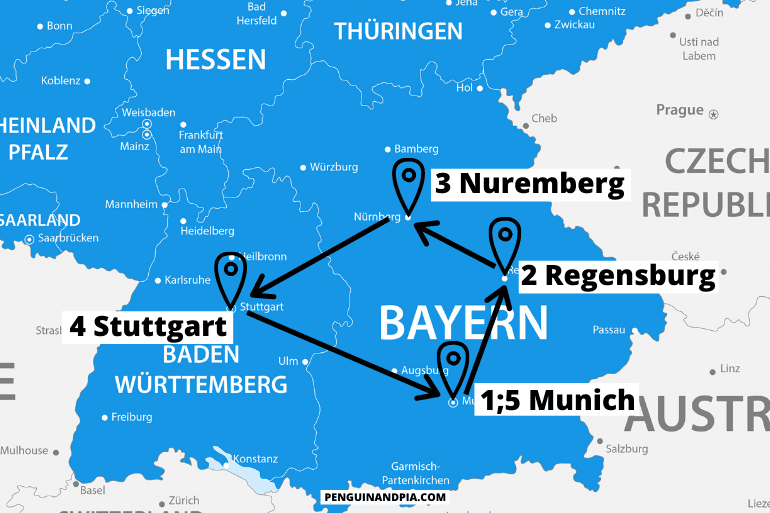
Day 1: Munich Day 2: Regensburg Day 3: Nuremberg Day 4: Stuttgart Day 5: Munich
Day 1: Munich

We are starting (and ending) this itinerary in Munich since it is an easy airport to fly in and out of from other parts of the world. If you are coming from another part of Europe by train, the connections to Munich are also usually pretty good.
Munich is the third-biggest German city and a very popular tourist destination. International travellers often mainly know the city because of the Oktoberfest which happens every year from the middle of September until October.
However, there is so much more to do and see in Munich than just the “Wiesn” (as the Oktoberfest is sometimes called as well). We are always happy to return to Munich because there is just so much to explore.
If you are thinking about renting a car for this itinerary, then you’ll be happy to know that it is quite easy to get a rental car in Munich. You can either pick it up directly at the airport after you land (if you arrive by plane) or in the city centre before you head to the next stop on this journey.
— Compare prices from rental car companies in Munich here
Accommodation in Munich: Munich is very large and popular city so finding a place to stay is no problem. The issue becomes that there are too many places to choose from! That said, you can check here for accommodations and hotels in Munich .
Specifically, we stayed at the very popular H2 Hotel München Olympiapark and we would highly recommend it for the value for money. The hotel has nice, cozy rooms, a super great breakfast buffet, and has a metro station steps from the front entrance to take you to the city centre.
There’s also onsite parking which makes this hotel perfect if you are travelling to Munich by car. The famous Olympic Park and BMW Museum are close by, too!
If you want to stay a little more in the city centre, then check out the Platzl Hotel Superior . This trendy hotel is in the heart of the Old Town just steps from top attractions like Marienplatz and the famous Hofbräuhaus. It’s also easy to get to the central train station either walking or on the metro.
If you are looking for more details on accommodations in this massive city, we wrote a detailed guide on where to stay in Munich .
Must-see Attractions in Munich:
- Marienplatz with New Town Hall
- Olympic Park
- Victuals Market
- English Garden
We also have a great little guide on how to spend one day in Munich if you want more details.
Day 2: Regensburg
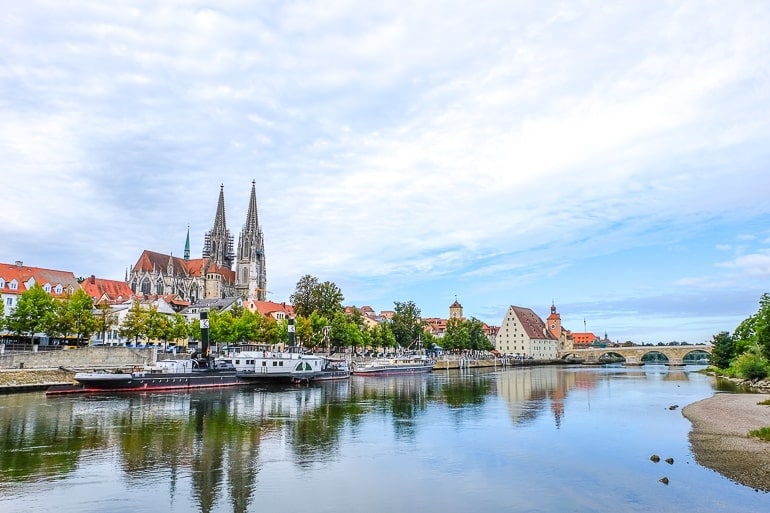
On day two of your trip you’ll be on your way to Regensburg, a small city in Bavaria on the Danube river. Due to its location by the river, Regensburg is a popular stop for people on a river cruise. So don’t be surprised if you see many different tour groups in the Old Town.
We recently spent a couple of days in Regensburg to get to know the city better and enjoyed our time there. One of the highlights is the Old Stone Bridge in the city centre which was built in the 12th century. We actually filmed a small YouTube video in Regensburg – which you can watch here if you are curious about what the city looks like.
The journey from Munich to Regensburg takes approximately 1 hr 20 minutes by car and around 1 hr 30 minutes by train . If you decide to travel by train – and especially if you are travelling with other people – we would recommend that travel with a “Bayernticket” (Bavaria Ticket). This ticket for train travel within the state of Bavaria usually allows you to save some money compared to regular prices.
Accommodation in Regensburg: If you are staying a night in Regensburg, you’ll have a number of great accommodations to choose from. To get started, you can check here for accommodations and hotels in Regensburg .
When we visited the city, we stayed at the Holiday Inn Express – Regensburg and really liked it. It’s a newer hotel and it really shows. The breakfast was excellent and there is even an onsite parking garage if you are travelling with a car. It’s not in the Old Town or near the river – but we did walk there one day and it only took about 15 minutes.
If you are travelling by train and you are on-foot, then check out the Altstadthotel Am Pach . This simple hotel is located right in the heart of the old town so you’re close to everything there is to see and do in Regensburg – including the beautiful Danube River. They also have breakfast included.
Must-see Attractions in Regensburg:
- Old Stone Bridge
- St Peter Cathedral
We are currently still working on our Regensburg Guide – but we’ll link it here once it is published.
Day 3: Nuremberg
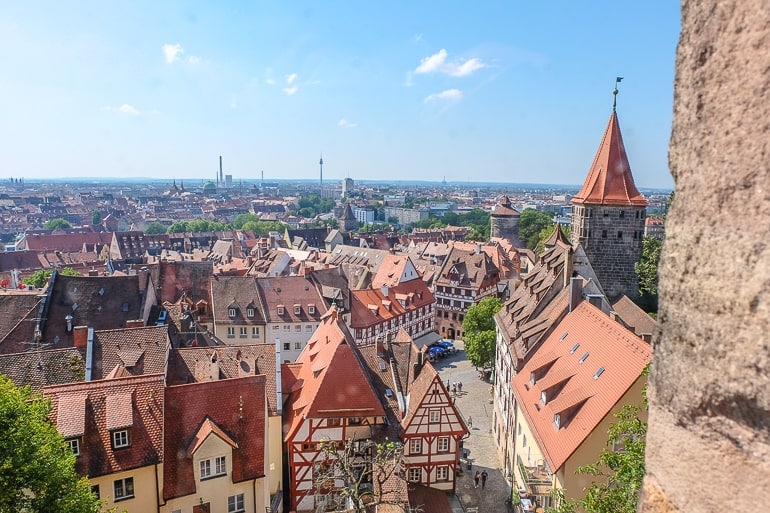
On the third day of this 5 day Southern Germany itinerary you’ll drive – or take the train – from Regensburg to Nuremberg. Nuremberg is a medium sized city in a part of Bavaria called Franconia. If you pay attention, you might notice that the dialect spoken here is quite different from that spoken in Munich and other places farther south.
Lisa actually grew up in this part of Germany so she has been to Nuremberg many, many times. Last year we also went to explore the city together and had a great time. Travellers from abroad mainly know the city for the Nuremberg Trials which took place there after World War II. You can certainly learn alot of history in this German city!
Since Nuremberg is quite close to Regensburg the drive won’t be long – giving you slightly more time to explore the city.
The journey takes approximately 1 hour 10 minutes by car and between 1-2 hours by train depending on which train you take (some stop more often than others). Once again, a regional ticket – such as the Bavaria Ticket – will probably save you some money if you travel with more people.
Accommodation in Nuremberg : Since Nuremberg is a very popular city to visit in Germany, there are many, many places to stay scattered throughout the city centre and around it. You can check here for accommodations and hotels in Nuremberg .
When we visited, we stayed at Five Reasons Hotel and Hostel and we really liked it. Located just inside the medieval city walls, we were really close to the train station and yet also steps from top attractions like the Germanisches Nationalmuseum. The place was bright and great value for the price which we liked a lot.
Close to Five Reasons, we had friends stay at the Sheraton Carlton Nuremberg and they loved it. We actually saw it with our own eyes – it had a pool with views of the city among other perks. There’s also a parking lot right across from the hotel if you’re coming to Nuremberg by car. It’s walking distance to the old centre and the central train station so best of all worlds!
Must-see Attractions in Nuremberg:
- Imperial Castle of Nuremberg (Kaiserburg)
- Documentation Center + Nazi Party Rally Grounds
- Albrecht Dürer’s House
As is the case with Regensburg, we are also still working on our article for Nuremberg. Once it’s live, we’ll link it here.
Day 4: Stuttgart
Stuttgart is the capital of the German state called Baden-Württemberg and the only place on this itinerary that is not located in Bavaria. The city is mainly known for being a “car hub” since both Mercedes-Benz and Porsche have their headquarters there. There are also museums dedicated to both car brands.
Stuttgart is a bit smaller than Munich but there is still a lot to see. In fact, one day won’t be enough to see the whole city – but it’ll allow you to get a good first impression. Next to the car museums, you could visit some of the many green spaces and/or old buildings that the city has to offer.
Driving from Nuremberg to Stuttgart by car will take you approximately 2 hours 15 minutes. If you have the time, you could even take a small detour and stop in Rothenburg ob der Tauber, known for its picturesque Old Town.
By train , the journey from Nuremberg to Stuttgart will take between 2 hrs 10 minutes and 2 hrs 30 minutes – depending on the type of train you are taking. Try to book your ticket in advance if possible as this can save you some money.
Accommodation in Stuttgart: There are many places to stay in Stuttgart – especially in the city centre. You can check here for accommodations and hotels in Stuttgart .
If you’re travelling to Stuttgart with a car, check out the Abalon Hotel ideal . Located very much in the city centre, this popular hotel has an underground parking garage and offers a good breakfast selection.
If you’re travelling to Stuttgart by train, you can check out the Pension am Heusteig . This guesthouse-style accommodation doesn’t have parking but offers a great breakfast and is a doable walk or metro ride from the train station. Funny enough, these two accommodations are very close to one another!
Must-see Attractions in Stuttgart:
- Schlossplatz
- Mercedes-Benz Museum
- Staatsgalerie Stuttgart
Day 5: Munich
On the last day of your trip you’ll make your way back to Munich since it is usually easier to leave Germany through the Munich airport than smaller airports in the surrounding area.
However, if you don’t have to get to an airport – and/or are taking the train home – you could also stay an extra night in Stuttgart if you wanted. Both cities are worth spending an extra few hours in – so you really just have to see what works best for you.
If you decide to get back to Munich, then the journey from Stuttgart to Munich will take approximately 2 hours 20 minutes by car and just slightly less (2 hrs 15 minutes) by train .
Accommodation in Munich : We already went over accommodations in Munich in Day 1 of this itinerary. So, you can head back up for the full details – but we would highly, highly recommend the H2 Hotel München Olympiapark as great value for money with great breakfast, parking, and a metro stop outside the front door.
Don’t forget we also have our detailed guide on where to stay in Munich if you want to have a deeper look at accommodations in the city.
We also have a post on spending one day in Munich if you want more details about the city!
Germany Itinerary 7 Days
If you have slightly more time to explore Germany, we have also created two 7 day Germany itineraries for you. Similar to the 5 day itineraries, we made two different itineraries since it’s pretty much impossible to see the whole country in just a week.
Instead of a northern and southern itinerary, this time we have focused on the western and eastern parts of the country. But please don’t read too much into that description – we use the terms quite loosely. As always, you’re welcome to modify any part of the itinerary to make it better fit your schedule/interests.
Germany Travel Itinerary 7 Days – West
For this itinerary, the total driving time would be around 14 – 15 hours and the distance would be slightly over 1100 km . For these calculations, we included the day trip to Monschau (and back to Cologne) as well as the day trip to Freiburg im Breisgau (and back to Stuttgart), which would be a longer day trip anyway.
So, depending on which day trips you decide to add on to (or remove from) this itinerary, your driving time and distance could be noticeably different than the estimates given above!
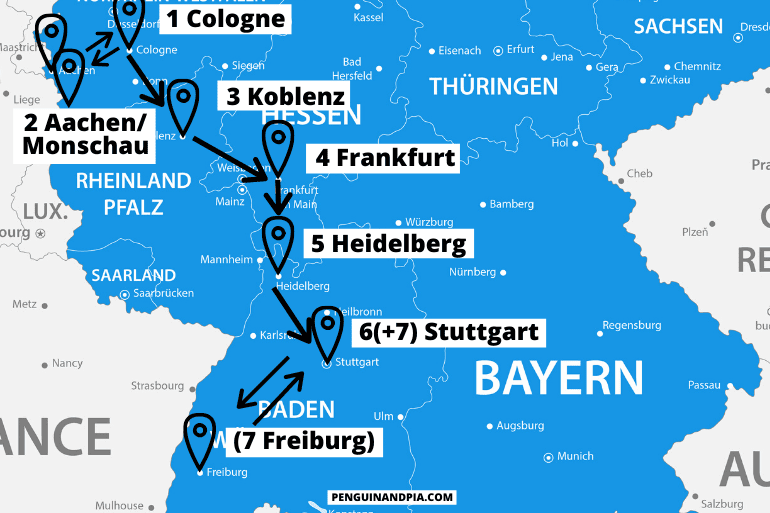
Day 1: Cologne Day 2: Day Trip to Monschau/Aachen Day 3: Koblenz Day 4: Frankfurt Day 5: Heidelberg Day 6: Stuttgart Day 7: Stuttgart / Day Trip to Freiburg im Breisgau
Day 1: Cologne
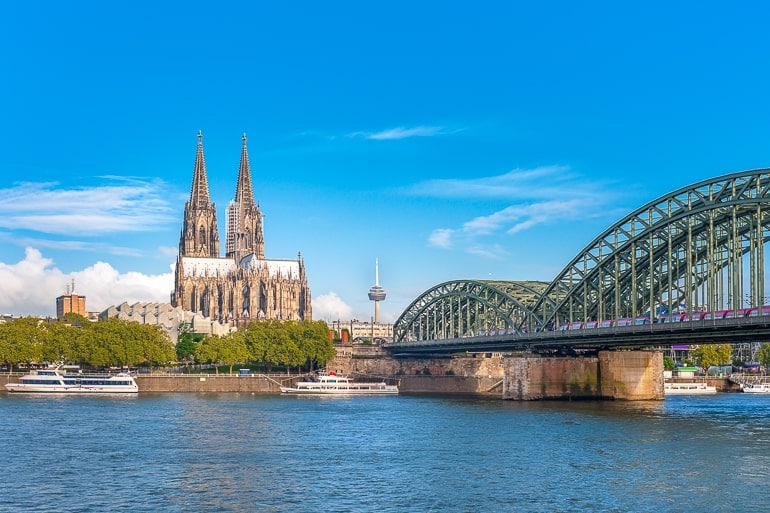
As we have already explained above, we like to start these itineraries in bigger cities to make it easier for people from overseas to get to Germany and start their adventure without hassle. Cologne is Germany’s fourth-biggest city (by population) and has two pretty good airports (Airport “Köln Bonn” and Airport “Düsseldorf”) close by for those coming from far away.
If you want to rent a car for this itinerary, it should be pretty easy to get one in Cologne since it’s quite an international city with lots of visitors.
— Compare prices from rental car companies in Cologne here
Cologne is a pretty spread-out city so you won’t be able to see the whole city in a day or two. However, the highlight of the city is certainly the Cologne Cathedral which is located right next to the central station and the Rhine River.
Make sure to plan some time to visit this impressive building – we always spend much longer in there than we originally plan. It’s free to enter so it can get very crowded depending on the day and time you’re visiting.
Accommodation in Cologne : Cologne is a very big city with multiple areas to stay in. As such, there are lots of accommodation options across the city. Wherever you book, remember to book your accommodation for two nights since you will go on a day trip and then return to Cologne on the second day. You can check here for accommodations and hotels in Cologne .
We have stayed in the Lindner Hotel City Plaza and loved it. The floors all have themes (we got Cologne Zoo with animals), the breakfast buffet is absolutely fantastic, and it’s a short walk to the Cathedral along one main street. There’s also parking available at/near the hotel for those with a car.
If you want to stay more in the heart of the city centre, check out something like the CityClass Hotel Residence am Dom . It’s popular, centrally located with shops and restaurants around, and only a short walk to the train station.
If you are looking for a hostel in Cologne, Eric once stayed at Cologne Downtown Hostel and it was honestly excellent. There’s a grocery store right below it and it’s located in the city centre. It also has a large balcony to enjoy the sunshine from!
Must-see Attractions in Cologne:
- Cologne Cathedral
- Cologne Chocolate Museum
Day 2: Day Trip to Monschau/Aachen
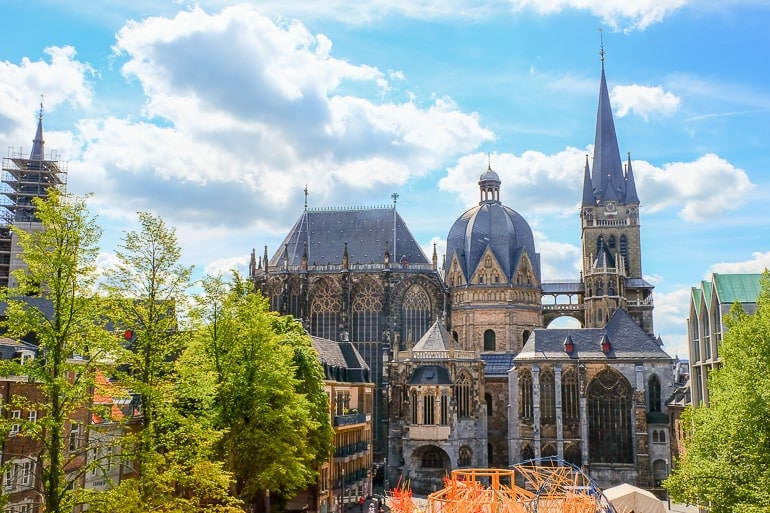
On the second day of this Germany itinerary, you have a few different option: you can either spend another day in Cologne if you feel like you haven’t seen enough of the city yet or take a day trip to Monschau or Aachen. Both of these are two places not too far from Cologne.
Monschau is a popular day trip in the area mainly because of its picturesque buildings in the old town. In fact, you probably have already seen photos of it on social media. To get to Monschau from Cologne, you can either drive or take a combination of trains and buses.
Getting to Monschau takes around 1 hr 40 minutes by car and approx. 2 hours by public transport . To visit Monschau by public transport, you can take the regional train from Cologne to Aachen-Rothe Erde and then take Bus #66 from there to Monschau.
Must-see Attractions in Monschau:
- Monschau Castle
If you want to go on a day trip but don’t want to venture that far, then Aachen would be another great option. This city is actually Germany’s most western city very close to the borders of The Netherlands and Belgium.
We’ve lived close to Aachen for a while and have written a whole guide full of things to do in Aachen that you should read if you want more information. In our opinion, one day is the perfect amount of time to explore the city since it doesn’t have that many attractions and the old town in the city centre is quite compact (but still very pretty).
Getting from Cologne to Aachen is also very easy. It takes approx. 1 hr 20 minutes by car and just around 50 minutes by regional train . You should look into getting a “Schönes Tag Ticket NRW” for the day if you’re travelling with more people as this can save you some money.
Must-see Attractions in Aachen:
- Aachen Cathedral
- Elisenbrunnen
Day 3: Koblenz
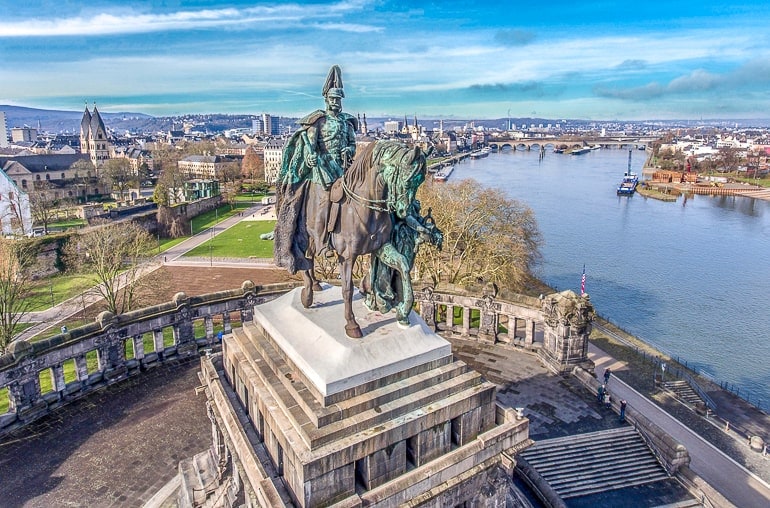
From Cologne, your journey continues to Koblenz – another city on the Rhine River. Koblenz is a smaller German city with a population of slightly over 110,000 inhabitants.
There are quite a few castles and nice hikes in the area which are easy to reach from Koblenz – just in case you decide that you don’t want to spend the day in the city. Depending on the time of year, you could also look into booking a boat tour on the Rhine river. This way, you get a unique perspective of the beautiful region.
Getting from Cologne to Koblenz is pretty easy and will take approximately 1 hour 30 minutes by car and between 50 minutes and 1 hr 10 minutes by train . We really like this train journey since the tracks follow the river for a majority of the trip. As a result, you get some really nice views – and might even spot some of the beautiful castles in the area!
Accommodation in Koblenz: Koblenz is certainly not a huge city – but you’ll still find a good number of places to stay for a night or two. You can check here for accommodations and hotels in Koblenz .
For a hotel right in the city centre, check out the Sander Hotel . This lovely hotel is super popular and close to shops and the rivers. If you are arriving to Koblenz by car, there is onsite parking at the hotel. However, since the city is smaller you can also easily reach the hotel by walking from the central train station.
Must-see Attractions in Koblenz:
- Deutsches Eck
- Ehrenbreitstein Fortress
- Koblenz Cable Car
Day 4: Frankfurt
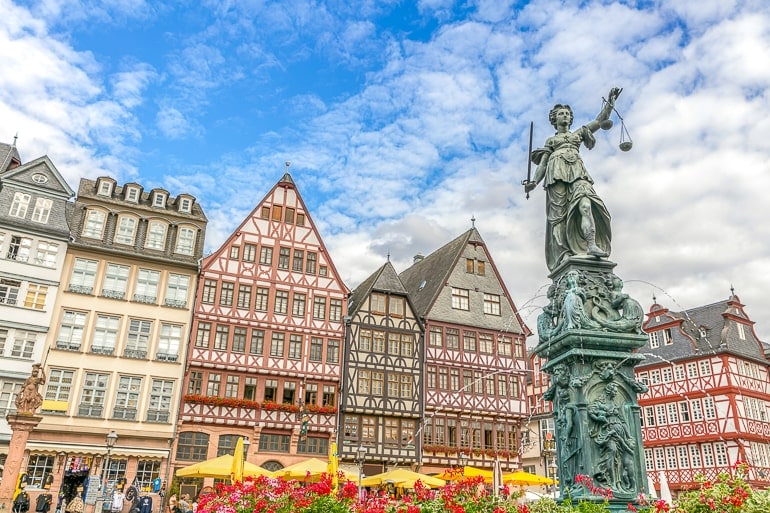
The next stop on your itinerary is Frankfurt, arguably one of the country’s most popular transport hubs due to the busy Frankfurt airport. Frankfurt is an interesting city that divided people: some people really enjoy it while other people don’t like it at all. To be fair, we haven’t spent enough time in the city to really solidify our opinion.
Either way, we do believe that Frankfurt is a stop that you shouldn’t miss if you are trying to get to know different areas of Germany. Known as the financial hub of Germany, this city with its many skyscrapers can feel quite a bit more modern than other German cities. However, the city also has a beautiful, historical market square that you should visit.
The journey from Koblenz to Frankfurt is another easy one – and if you are taking the train (we would recommend that!), you’ll once again follow the Rhine River for big parts of the journey and be rewarded with some great views.
The train ride will probably be between 1 hr 25 minutes and 2 hrs 12 minutes long – depending on the connection you choose. By car , the trip will take around 1 hr 30 minutes . Of course, this can vary depending on traffic.
Accommodation in Frankfurt : There are loads of places to stay in Frankfurt given its popularity and size. You can check here for accommodations and hotels in Frankfurt .
A great option in Frankfurt is the Motel One Frankfurt-Römer . Located very much in the heart of the city centre close to the old town and river, this cool hotel has underground parking if you are arriving to Frankfurt by/with a car. It also serves up a great breakfast!
If you are arriving by train to Frankfurt, you should check out Fleming’s Express Hotel Frankfurt . Located literally right beside the central station (which is in the city centre), this upscale hotel is very popular because it’s very affordable and also has a great breakfast.
Must-see Attractions in Frankfurt:
- Palmengarten
Day 5: Heidelberg
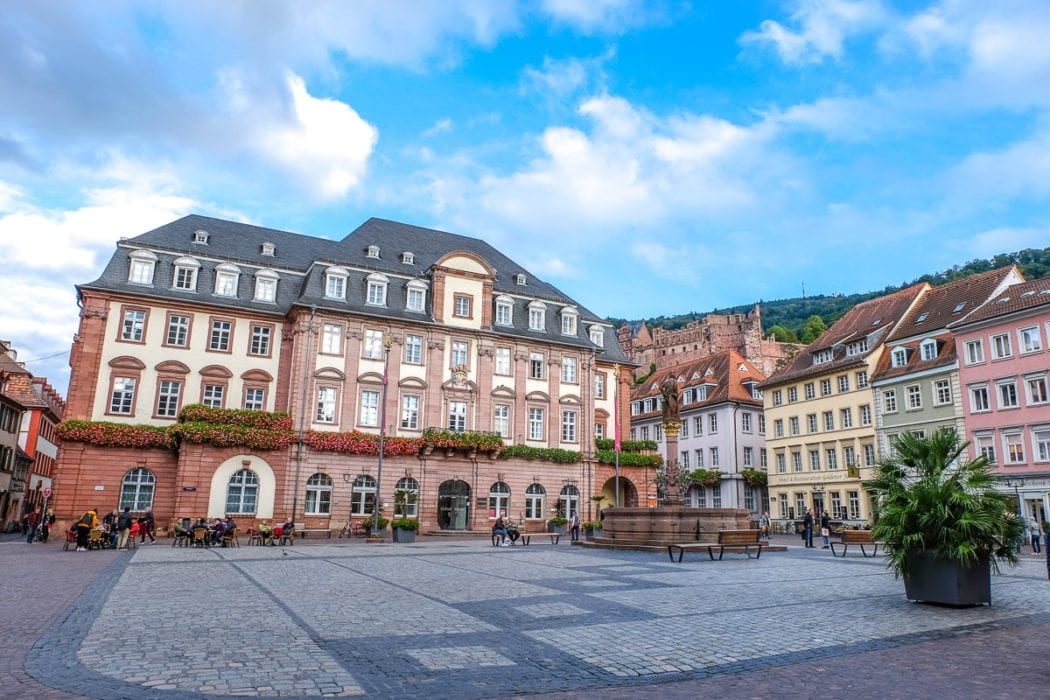
After your day in Frankfurt, you’re heading to Heidelberg which is actually one of our favourite German cities. The highlight of the city is certainly the castle on top of the hill which is visible from many different parts of the city.
Heidelberg is smaller than Frankfurt so you can see quite a bit in just 24 hours. The Old Town is beautiful and lots of attractions are located there. Our highlight was probably the tower climb of the Church of the Holy Spirit. From up there, you get a beautiful view of the Old Town. A very close second was the cable car ride up to the Königstuhl which was lots of fun – even in the rain.
Getting from Frankfurt to Heidelberg won’t take too long. The journey will be approximately one hour by car and between 45 minutes and 1 hr 30 minutes by train – depending on which type of train you are taking.
Accommodation in Heidelberg: If you’re heading for Heidelberg (good choice), there are lots of great places to stay. You can check here for hotels and accommodations in Heidelberg .
We stayed a little outside the old town – but close to the train station – at NinetyNine Heidelberg City . This hotel was really, really great. The beds were comfy and the decor has animals everywhere – you have to see it to understand!
There’s onsite parking (paid) and street parking (free, but not guaranteed) if you are travelling with a car. There’s also a tram stop right outside the hotel to get directly into the city centre in minutes.
If you are looking to stay in the historic old town, then check out colourful hotels like Hotel Holländer Hof which overlooks the river or Hotel Zum Ritter St.Georg which is literally overlooking the main Marktplatz.
Must-see Attractions in Heidelberg:
- Heidelberg Palace
- Church of the Holy Spirit (mainly tower climb)
If you want to learn some more about Heidelberg and what there is to do, you can read our detailed Heidelberg Guide here .
Day 6: Stuttgart
The next day you will drive to Stuttgart, a city that we’ve already mentioned in one of our Germany itineraries for 5 days. As we have already mentioned, you’ll probably really enjoy Stuttgart if you are interested in cars.
Even if you aren’t, there is still lots for you to explore. Did you know that wine also plays a huge role in Stuttgart and the surrounding region? If this is something that interests you and you’re there in the summer (specifically around the end of August), then you should stop by the “Stuttgarter Weindorf” (“wine village”) – but obviously, please don’t drink and drive.
As for getting from Heidelberg to Stuttgart, the journey will take you approximately 1 hr 20 minutes by car and between 40 minutes and 1 hr 30 minutes by train . As mentioned before, the time differs depending on the type of train you are choosing.
Accommodation in Stuttgart: Stuttgart has many places to stay so you can check here for accommodations and hotels in Stuttgart .
Be sure to see the Abalon Hotel ideal if you have a car. This hotel has underground parking available and a tasty breakfast. It’s also in the city centre which makes sightseeing easy.
Those coming to Stuttgart by train should look at the Pension am Heusteig . It’s a guesthouse that is located not too far from the first hotel here and it’s a doable walk or metro ride from the central station.
Day 7: Stuttgart / Day Trip to Freiburg im Breisgau
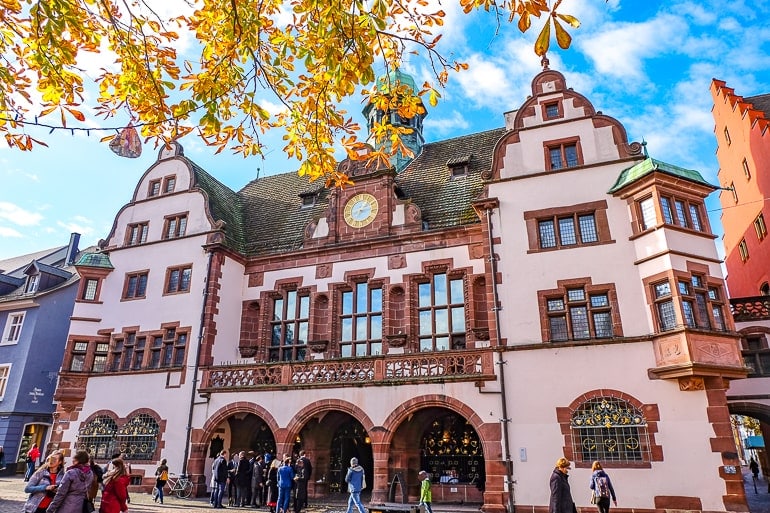
For this itinerary, you can decide how you would like to spend your last day. You could either spend another day to explore more of Stuttgart (and maybe relax for a bit) or you could head farther south and spend a day in Freiburg im Breisgau. We really enjoyed spending time in this small city in the south of Germany during our visit.
We are currently still in the process of writing our Freiburg guide, but we’ll link it here once it’s done. However, a good way to start your exploration of the city is by wandering the old town.
In Freiburg, you’ll find that many of the cobblestoney streets have small water-filled runnels – called Bächle – running alongside it. Sometimes they even have small yellow ducks in them!
The journey from Stuttgart to Freiburg im Breisgau is slightly longer than most other parts of this itinerary. It takes approximately 2 hrs 30 minutes by car and around 2 hours by train . Since this train journey will probably include at least one ICE (the fast train), we’d recommend that you book your train tickets early if you can to save some money.
Must-see Attractions in Freiburg:
- Freiburger Münster (Cathedral)
- Schlossberg + Tower
- New + Old Town Hall
Germany Travel Itinerary 7 Days – East
If the other week-long Germany itinerary doesn’t interest you and/or you really want to visit the German capital Berlin, then you might prefer this eastern route instead.
The driving time would be just slightly over 10 hours and would be approximately 900 km driving distance – including the day trip to Potsdam (which would honestly be easier with public transport, though)!
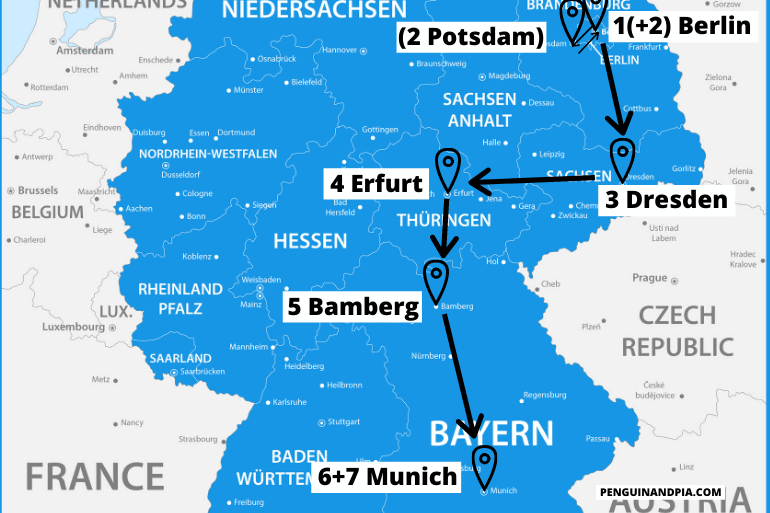
Day 1: Berlin Day 2: Berlin / Day Trip to Potsdam Day 3: Dresden Day 4: Erfurt Day 5: Bamberg Day 6+7: Munich
Day 1: Berlin
Once again, this itinerary begins in Berlin since it is one of the big cities that is easier to get to for people coming from overseas. Similar to the five day itinerary that started in Berlin, you’ll stay two nights in the German capital. There is just too much to see to spend only one day – and even in two days you wouldn’t be able to explore everything.
In case you’ve already been to Berlin on a different trip and/or aren’t a huge fan of big cities, we also give you the option of a day trip to Potsdam (a city close by) on the second day. More on that below.
Accommodation in Berlin : Finding a place to stay in Berlin can be tough because there are just so many options. You can check here for accommodations and hotels in Berlin .
If you have a car, check out Park Plaza Wallstreet Berlin Mitte . Located right in the middle of the city close to Museum Island, this hotel has a great breakfast and free parking on the street behind the hotel. Otherwise, parking is paid but for a decent price for the city centre.
Those without a car travelling by train should see the NH Collection Berlin Mitte am Checkpoint Charlie . If you want a hotel close to a top attraction that is easy to get to with public transport, this is definitely one of them!
Across the city, PLUS Berlin is a really good hostel/hotel that Eric stayed at a few years ago. It’s a big place but it was a great stay over by the East Side Gallery (part of the Berlin Wall with the graffiti on it).
As already mentioned above, if you want to read some more about Berlin, check out our articles on Things to do in Berlin and How to spend one day in Berlin .
Day 2: Berlin / Day Trip to Potsdam
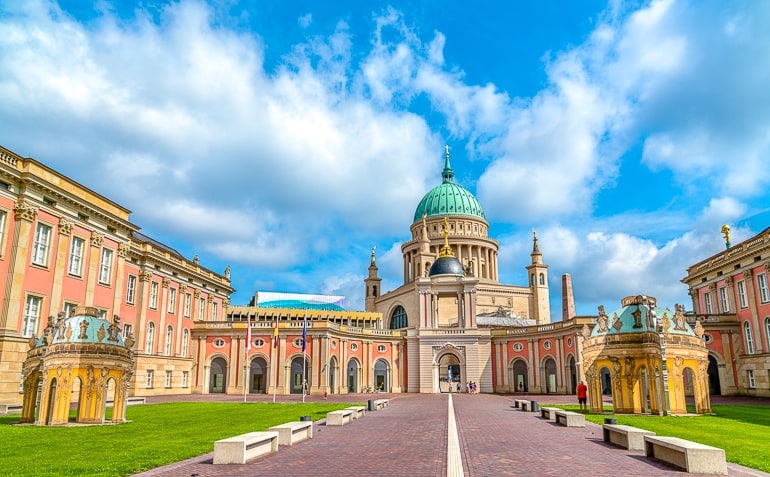
On your second day, you can choose between spending another day in Berlin to see more of the German capital or going on a day trip to Potsdam – which is a smaller city not far from Berlin.
Potsdam is actually the capital city of the German state called Brandenburg. It’s most popular attraction is probably Sanssouci Palace with the beautiful Sanssouci Park surrounding it.
During our visit, we also enjoyed walking through the Dutch Quarter with its small shops and cafes. Since the city isn’t too big, one day gives you a chance to get a good impression and check out some of the more popular sights.
It is also very easy to get to Potsdam from Berlin. If you decide to drive , it’ll take you approx. 40 minutes , but it could be longer – traffic depending. We would honestly recommend that you do this day trip by taking public transport. This way, you don’t have to worry about traffic and/or finding a parking spot.
For trains, you can take the S-Train #7 (S7) from Berlin Central Station (as well as other train stations) straight to Potsdam Central Station. The journey will take around 35 minutes with trains running very frequently throughout the day.
Must-see Attractions in Potsdam:
- Sanssouci Palace
- Dutch Quarter
- Cecilienhof
Day 3: Dresden
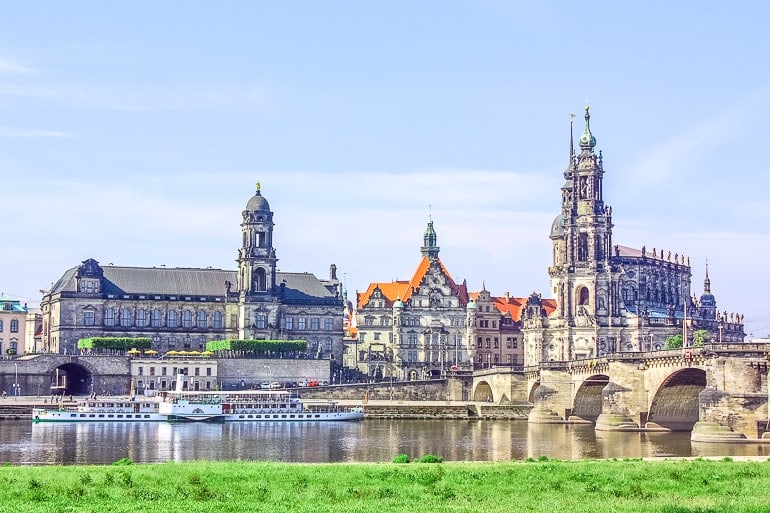
The third day of this Germany itinerary will take you from Berlin to Dresden which is a German city close to the Czech border. To be honest, we haven’t spend that much time in Dresden yet – and it’s certainly on our list of places to visit this year.
One of the city’s main attractions – the Zwinger – is known across the country and a sight that you shouldn’t miss during your visit. It’s a beautiful palace built in a baroque style.
Fun fact: When Lisa was a kid, she didn’t actually know that the “Zwinger” was a palace. Since that word can also mean “dog kennel” in German, she was always confused as to why people would want to visit it during their time in Dresden!
As for getting from Berlin to Dresden, the drive will take you around 2 hrs 10 minutes by car and around 2 – 3 hours by train. Once again, this depends on which connection you choose.
Accommodation in Dresden: There are a number of accommodations in the compact “Innere Altstadt” close to the River Elbe for you to choose from. You can check here for accommodations and hotels in Dresden .
For a great hotel option right in the old town, look no further than the Star Inn Hotel Premium Dresden im Haus Altmarkt . You’re a short walk to the train station, the river, and all the best old sights in Dresden if you stay here and arrive by train. If you come to Dresden by car, the hotel has discounted underground parking available.
Another option right in the old town (and even closer to the river) is Aparthotel am Schloss . Since this is an apartment-style hotel, it’s a great option if you are looking for more of a base to relax in a “home away from home”. It’s a very popular choice, too – and also has onsite parking.
Must-see Attractions in Dresden:
- Frauenkirche
Day 4: Erfurt
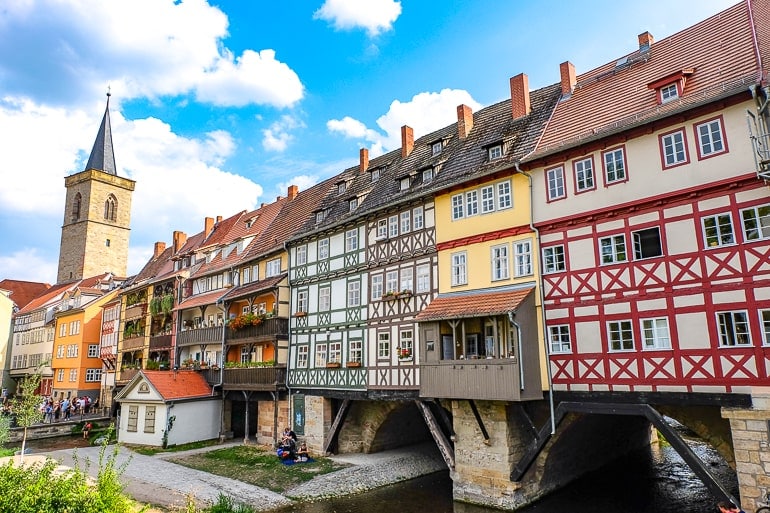
Erfurt is a popular city to visit in the middle of Germany – and it’s also the capital city of the German state Thuringia. We’ve spent some time in Erfurt a few months ago and instantly fell in love with the city. Its size is perfect (in our opinion) – giving you enough things to do without feeling overwhelming.
Maybe you’ve seen photos of one of the city’s most popular attractions, the Krämerbrücke. This bridge is not only pretty to look at and photograph, it’s also unique in the sense that there are buildings on the bridge and when you’re walking on it, you can’t actually see the water running below.
Visiting the bridge and climbing the tower of the Ägidienkirche, a church at one end of the bridge, is something we’d certainly recommend during your time in the city. We actually filmed a short video of our time exploring Erfurt. If you are interested in seeing what parts of the city look like, then you can find our video here .
Getting to Erfurt from Dresden won’t take you too long. It will take approx. 2 hours 20 minutes by car and between 2 and slightly over 3 hours by train .
Accommodation in Erfurt: Since Erfurt isn’t a huge city, there aren’t a ton of accommodations – but certainly more than enough to find one that works for your style and budget. You can check here for hotels and accommodations in Erfurt .
We stayed at Gästehaus in der Gotthardtstraße and really liked our stay. It’s located in a quiet neighbourhood just north of the city centre – a short walk to the Krämerbrücke. The host was lovely, the room was cozy, and there was secure onsite parking for those driving to Erfurt.
If you want to stay RIGHT in the city centre then you should check out Hotel Krämerbrücke Erfurt which is right beside the famous bridge. This might be a good place to stay if you are travelling to Erfurt by train and you’re on-foot.
Must-see Attractions in Erfurt:
- Krämerbrücke
- Erfurt Cathedral
- Citadel Petersberg
For more details, have a look at our Things to do in Erfurt article .
Day 5: Bamberg

Bamberg is a small city – or larger town – in the German state called Bavaria. It’s actually located in a region called Franconia, which is noticeably different from the Bavaria that you might know in the area surrounding Munich, etc.
We’ve been to Bamberg multiple times over the years (it’s also close to the part of Germany where Lisa grew up) and are always happy to come back. Bamberg is known for its cute, historic old town which is actually a declared UNESCO World Heritage Site.
One of the most popular buildings the city has to offer is the Old Town Hall (shown above) which is built on an artificial island. The story behind it is quite interesting.
The drive from Erfurt to Bamberg is doable and will take approx. 2 hrs by car and around 3 hrs by train . On the way, you’ll drive through quite a few tunnels since you’ll drive through an area known as “Thuringian Forest”.
Accommodation in Bamberg: Bamberg is a small place to visit so there aren’t a ton of options but still enough to find what you’re looking for. You can check here for accommodations and hotels in Bamberg .
Anywhere you stay is basically in or close to the old town/city centre. For a place to stay with parking (for those arriving by car), check out Welcome Hotel Residenzschloss Bamberg . It’s located right on the river.
You might also want to see Palais Schrottenberg to stay right in the middle of the Old Town! For reference, the train station is a short walk to the north of the river – not far from these places in the centre.
Must-see Attractions in Bamberg:
- Bamberg Cathedral
- Old Town Hall
- Alte Hofhaltung
If you want some more information about Bamberg, please read our detailed Bamberg, Germany Guide .
Day 6+7: Munich
From Bamberg, your journey will continue to Munich which will be the last stop on this 7 day eastern itinerary. Not only is this the third biggest city of the country, it is also one of the most internationally known destinations in Germany.
Whenever we come back to Munich, we always enjoy our time there. For some reason, the atmosphere always feels more laid back than in other big German cities and the people are usually quite friendly. We might also be a little bit biased, though, since Lisa grew up in this part of the country and is more used to the mentality, dialect etc. than in other parts of Germany.
For this itinerary, you’ll spend two days in Munich since there is quite a lot to see. Next to the obvious attractions like the Marienplatz with the New Town Hall and the Frauenkirche close by, there are also lots of museums and other things that you can explore.
If you’ve already been to Munich before and/or decide that one day in the city is enough for you, you could also opt for a day trip on one of these days. We’ve just recently written a whole Day Trips from Munich Guide , which you can browse through to get some inspiration!
Driving from Bamberg to Munich will take about 2 hrs 20 minutes by car and between 2 and 3 hrs by train . If you decide to only take regional trains instead of the ICE (fast train), you should look into getting the Bayernticket. This can save you some money, especially when you’re travelling with more people.
Accommodation in Munich: Since Munich is so large and popular to visit, there is definitely no shortage of places to stay! You can check here for accommodations and hotels in Munich .
That said, we loved our stay at H2 Hotel München Olympiapark . Located up by the famous Olympic Park, we’d highly recommend it since it was amazing value for money. The breakfast was huge and delicious and there’s a metro station outside the lobby door that takes you into the heart of the old town in minutes. There’s also parking if you are arriving by car.
For a hotel that is a little more central, you should see the Platzl Hotel Superior this hotel is really popular – and for good reason. It’s located around the corner from attractions like Marienplatz and the famous beer hall, Hofbräuhaus.
For more help looking into accommodations and neighbourhoods in Munich, check out our where to stay in Munich guide .
(Check out our guide to one day in Munich if you want more details on things to do and see.)
Germany Itinerary 10 Days
Although we have tried to create short itineraries that allow you to see more than just the standard cities, it is no doubt easier to see more of Germany if you are able to travel for longer than one week. To give you a couple different options that you could look at (and then potentially modify), we have created two 10-day Germany itineraries.
Once again, we believe that ten days would not be enough time to see the whole country – and even if you managed to do that it would be too stressful (in our opinion). Both of the following itineraries give you a good mix of bigger and smaller cities as well as a few interesting day trips. So, have a look and see which one you like better!
Germany Itinerary 10 Days – North
If you’re interested in seeing more of the northern part of Germany and experiencing the mentality and way of life of people in the flatter part of the country, closer to the sea, then have a look at the following 10-day itinerary!
The total driving time would be slightly less than 17 hours with a distance of approx. 1470 kilometres. For these calculations, we have included the day trips to Schloss Drachenburg, Lübeck, and Flensburg. So, if you decide to skip any of these, your driving time and distance would obviously be slightly lower.
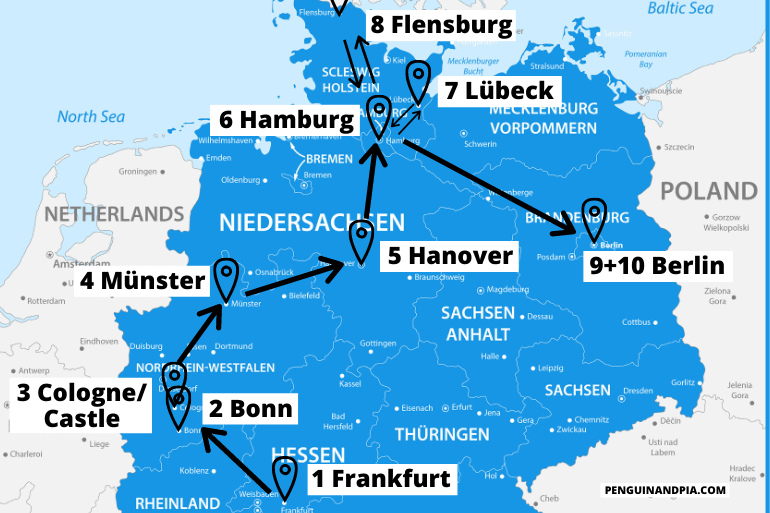
Day 1: Frankfurt Day 2: Bonn Day 3: Day Trip to Schloss Drachenburg / Cologne Day 4: Münster Day 5: Hanover Day 6: Hamburg Day 7: Day Trip to Lübeck Day 8: Day Trip to Flensburg Day 9+10: Berlin
Day 1: Frankfurt
Similar to some of the other itineraries mentioned in this article, we start this 10-day itinerary in Frankfurt. By now you should probably already know why – Frankfurt has the biggest airport of the country which should make it easier for people coming from overseas to get to Germany and start their adventure.
Furthermore, Frankfurt is quite centrally located so it is easy to get to many different cities from here. So even if you decide against following our itineraries step-by-step, Frankfurt would be a good starting point!
— Compare prices from rental car companies in Frankfurt here
Accommodation in Frankfurt : You’ll find plenty of places to stay in Frankfurt. You can check here for accommodations and hotels in Frankfurt .
One really popular hotel in Frankfurt is the Motel One Frankfurt-Römer . This Motel One is near the river and walking distance to lots of things in the city centre. If you are coming to Frankfurt with a car, Motel One has underground parking which can make life easy! They also have a nice breakfast.
A hotel option closer to the train station is Fleming’s Express Hotel Frankfurt . This hotel is just to the north of the main station which makes it a great option if you are arriving by train and have no car. It’s popular because it has a great breakfast and is good value for money.
Day 2: Bonn
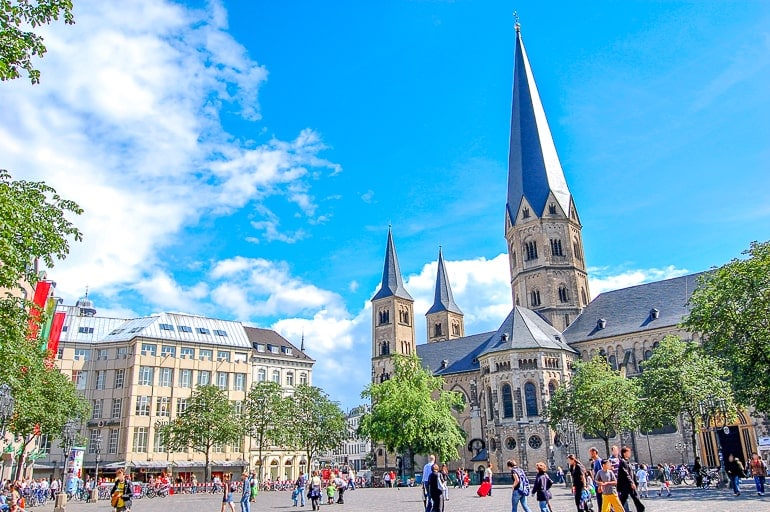
On the second day, you’ll head from Frankfurt to Bonn. As you might know, Bonn used to be the capital of the Federal Republic of Germany during the time that Germany was split into two countries. Later, the capital was relocated from Bonn to Berlin.
If you are interested in learning more about the history of Germany during your time in the country, then Bonn would be a good city to do that in. For example, you could visit the so-called “Haus der Geschichte” which is a museum about the history of the Federal Republic of Germany.
It won’t be difficult to get from Frankfurt to Bonn since the two cities are not too far apart. The journey will take approximately 1 hr 50 minutes by car and between 1 hr 20 minutes and 2 hrs if you take the train . Once again, we’d recommend that you book your train ticket in advance if possible.
Accommodation in Bonn: There are a number of accommodation options in Bonn which you can choose from – many are right in the city centre/old town. You can check here for accommodations and hotels in Bonn .
Keep in mind to book your accommodation for two nights for this itinerary. (You could also spend the following night in Cologne if you day tripped to there, though).
For a great hotel in the heart of the old town, check out BrauHotel Bonn . You can easily walk here from the central train station but they also have a and parking garage close by if you arrive by car. There’s also a craft beer bar on the ground floor!
Another option is the Hilton Bonn . This hotel offers you amazing views of the Rhine River. It’s a bit north of the city centre but still very much close to it. There is parking but it can be expensive so keep that in mind when you book.
Must-see Attractions in Bonn:
- Bonn Minster
- House of the History of the Federal Republic of Germany (Haus der Geschichte)
Day 3: Day Trip to Schloss Drachenburg / Cologne
On day three of this itinerary, you can choose to stay in Bonn, or go on one of two day trips: to Schloss Drachenburg (a castle not far from Bonn) or to Cologne which is also close by.
Schloss Drachenburg is actually a private villa/mansion that was built to look like a castle in the 19th century. Today, it is a popular attraction in the area.
From Bonn, you can either drive to Königswinter by car (and then leave your car at the car park) or take public transport to the Königswinter/Clemens-August-Straße station. You can find more information about that and opening hours etc. on the offical website .
If you are not a huge fan of castles, then you might opt for a day trip to Cologne instead. In this case, you might even decide to change your base and spend the night in Cologne instead of returning to Bonn at the end of the day. That is definitely an option that you can choose since there are lots of accommodation options in Cologne as well.
Getting to Cologne from Bonn will take you around 40 minutes by car (this can obviously depend on traffic) and only approx. 25 minutes by train . Just a quick warning: Trains can get very full if you are travelling during rush hour traffic – so try to avoid that if you don’t like being surrounded by lots of people in a small space.
Day 4: Münster
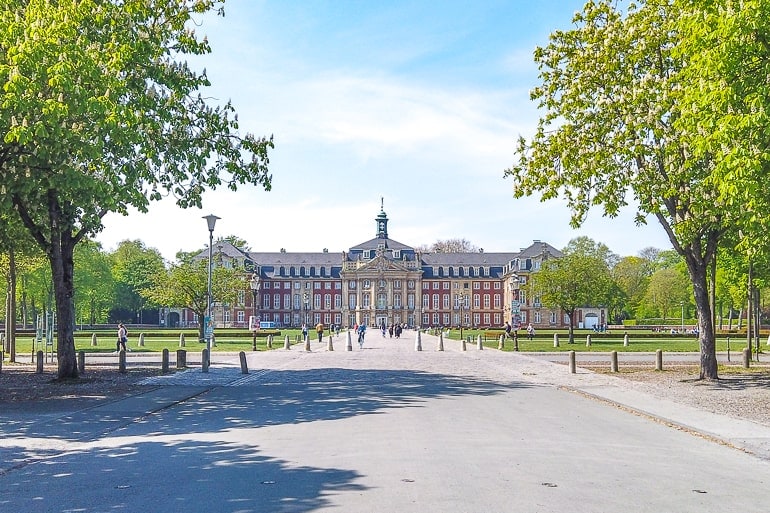
The next day you’ll head from Bonn – or Cologne – to Münster. Since Bonn and Cologne are so close, the journey wouldn’t really differ much from either city.
Münster is a smaller German city that we really enjoy. To be honest, it sometimes reminds Lisa of Copenhagen – mainly because of the many bikes that you can see all around the city. The University of Münster plays a big role in the city and the vibe – depending on which part of the city you are in – is noticeably younger.
One of the highlights of the city – for locals and visitors alike – is the lake Aasee which is located quite centrally. When the weather is nice, there are always people sitting on the grass enjoying the sun and maybe even out on the water (depending on the time of year). You can rent a small paddle boat to explore the lake from a unique perspective.
The journey from Bonn to Münster should take you slightly less than 2 hrs by car and between 2 hrs and slightly more than 3 hrs by train . If you want to save some money and are travelling with other people, then you should look into getting an “NRW Schönes Tag Ticket”. With this ticket, you wouldn’t be allowed to travel on ICE’s (the fast train), but the connections using only regional trains wouldn’t be much longer.
Accommodation in Münster: Münster might feel small but it’s actually pretty spread out and offers accommodations for all styles and budgets. You can check here for accommodations and hotels in Münster .
If you want a popular hotel option right in the centre, the H4 Hotel Münster is a short walk to the heart of the historic centre. It also has onsite parking for those travelling to Münster by car – but you can easily walk there from the train station in the south of the city centre.
Must-see Attractions in Münster:
- Münster Prinzipalmarkt
- Historic Town Hall
- Münster Cathedral
For a more detailed guide, have a look at our Things to do in Münster, Germany article .
Day 5: Hanover
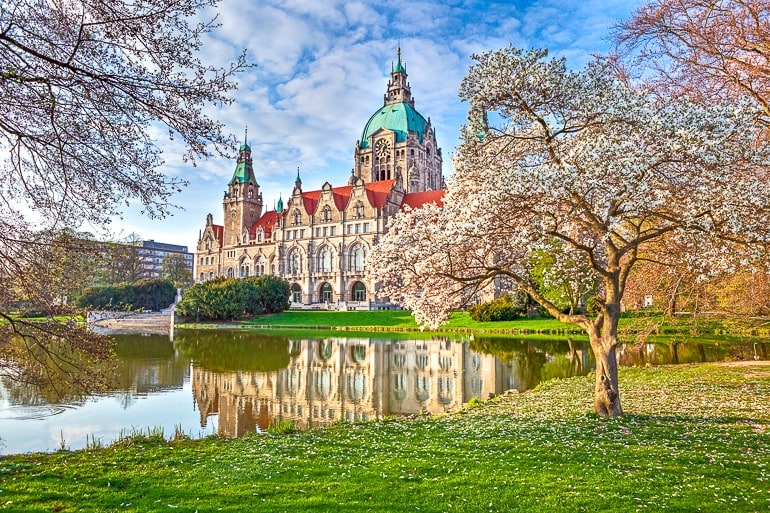
The following day you are travelling from Münster to Hanover. In German “Hannover” is actually written with two “n”, so don’t be surprised if you see it being written slightly differently.
Hanover is the biggest city and the capital of the German state called Lower Saxony. Compared to some other cities on this itinerary it is a less popular tourist destination. To be fair, even we haven’t spent that much time in Hanover yet. Hopefully we’ll be able to change that soon. However, that’s not to say that Hanover is not worth a visit.
Not only can you explore some beautiful gardens and interesting museums in the city, but it is also located pretty much halfway between Münster and Hamburg. That makes it a great stop to break up the journey and spent another day in a city that allows you to explore without too many other (international) tourists around.
By car , the journey from Münster to Hanover will take you around 2 hrs . If you choose to travel by train instead, it will take you approximately the same amount of time .
Accommodation in Hanover: Hanover is a larger city but the accommodation are still relatively packed together in and around the historic city centre. You can check here for accommodations and hotels in Hanover .
For a stay right in the city centre, check out the Hotel Loccumer Hof . This popular hotel is a very short walk from the central station which is perfect if you are arriving to Hanover by train. That said, they also have parking onsite so this hotel works well if you arrive by car!
For another hotel option, check out the Arthotel ANA Prestige am neuen Rathaus . This boutique hotel is directly across from the beautiful New Town Hall in the south end of the city centre by the greenspace and water! They also have a really nice breakfast and parking available.
Must-see Attractions in Hanover:
- New Town Hall
- Marktkirche
- Herrenhausen Gardens
Day 6: Hamburg
On day six of this 10-day itinerary you’re on your way to Hamburg. If you’ve read the details of any of the shorter itineraries in this article, you’ll know that we really like Hamburg.
The city offers modern areas, such as “HafenCity”, mixed with historic (e.g. “Speicherstadt”) and alternative areas (“Sternschanze”) . This makes exploring the city all the more interesting – there is truly something for everyone. During your time in the city, we’d also recommend that you climb the tower of the St. Michael’s Church. From up there, you get a beautiful view of most parts of the city.
The journey from Hanover to Hamburg won’t be long. Depending on the route you are taking (Highway A7 or A1), it’ll take between 1 hr 30 minutes and 2 hrs by car . If you opt for the train , you can expect the journey to take between 1 hr 15 minutes and 1 hr 30 minutes . This depends on the connection you choose.
Accommodation in Hamburg : Hamburg has many, many places to stay. You can check here for accommodations and hotels in Hamburg .
The Mövenpick Hotel Hamburg might be a good option if you have a car while you travel around Germany. This cool hotel is inside an old water tower which gives guests stunning views of the city around. There’s also parking onsite and it’s close to a transit stop for getting around the city.
Located not too far from the central train station, ARCOTEL Rubin Hamburg makes for a good hotel option if you don’t have a car. It’s located in St. Georg which is a lively area within walking distance of the city centre.
Those that need hostel for their stay in Hamburg might be happy with Generator Hamburg . It’s a popular hostel in the city and is close to the train station for easy getting around. If you’re unsure about where to stay, you can always check out our detailed guide on where to stay in Hamburg .
Once again, if you’d like to read our (very) short Hamburg guide, you can find our Things to do in Hamburg article here .
Day 7: Day Trip to Lübeck
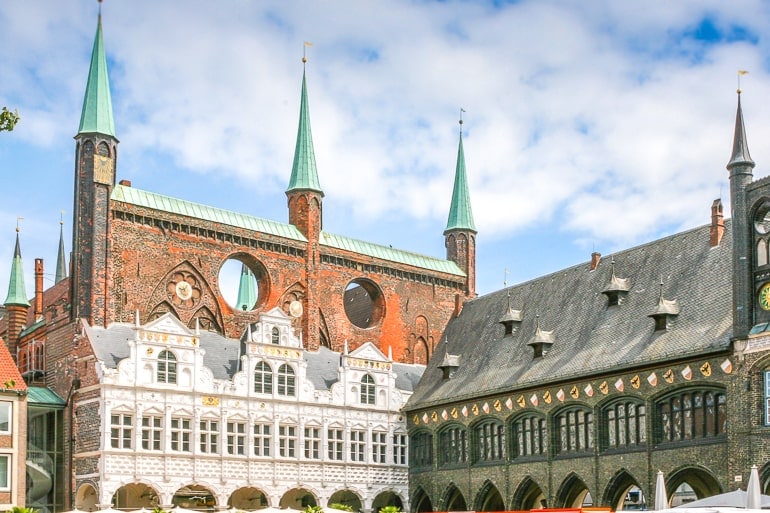
For the next couple of days, we decided to include some day trips from Hamburg. This allows you to stay in one accommodation for longer than just one night and gives you the option to see some more of Hamburg as well. If you don’t want to visit any other cities and want to spend more time in Hamburg instead, then feel free to skip one or both of the day trips mentioned.
Lübeck is the closer one of the two day trips mentioned from Hamburg. Within Germany the city is mainly known for its delicious “Lübecker Marzipan” (Lübeck Marzipan) – but of course there is much more to the city than just that. One of the highlights is the Holsentor, a red-brick city gate dating back to the 15th century.
The journey from Hamburg to Lübeck will take you slightly over 1 hr by car and just around 45 minutes by train . In our opinion, that’s great for a day trip since it gives you lots of time to actually see the city instead of spending a lot of time in the car/on the train.
Must-see Attractions in Lübeck:
- Marienkirche
- Heilig-Geist-Hospital
Day 8: Day Trip to Flensburg
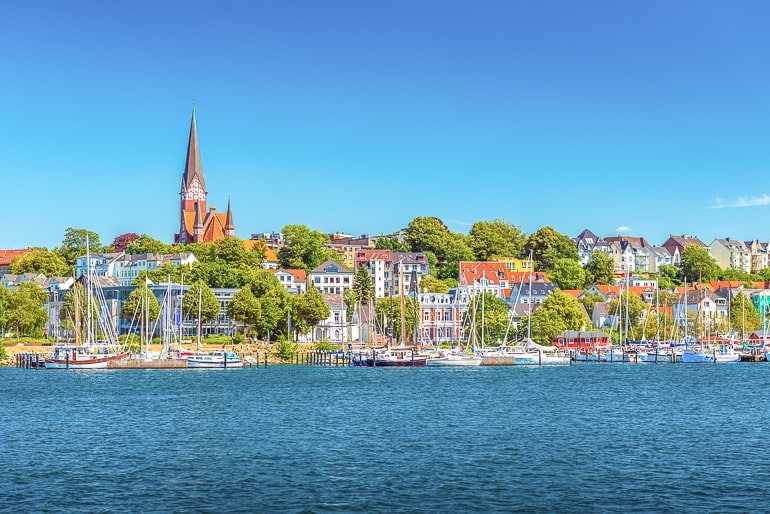
For the following day, we have another day trip option for you. The journey to Flensburg is slightly longer than to Lübeck – but it would be worth it. Flensburg is a smaller German city in the north of Germany, very close to the Danish border.
Since it is located close to the water, shipping plays an important role in the city to this day. If you’re interested in learning more about that, then the Maritime Museum would be a good place for you to visit.
Another thing we would recommend is a walk along the Rote Straße. Here you’ll find different “Hinterhöfe” (similar to backyards) with cute cafes and small shops.
Getting to Flensburg from Hamburg should take slightly less than 2 hrs by car and the same amount of time by train . As already mentioned, it would be a longer journey than to Lübeck, but if you want to experience a smaller, maritime city, the trip would be worth it!
Must-see Attractions in Flensburg:
- Historischer Hafen (Historic Harbour)
- Flensburger Schifffahrtmuseum (Maritime museum)
- Museumsberg Flensburg
Day 9+10: Berlin
On the second to last day of this itinerary, you’ll head from Hamburg to Berlin where your journey ends. This allows you to spend two days in the German capital. Since there is so much to do in Berlin, we’d recommend that you do some research beforehand to narrow down which attractions you’d like to visit.
If you’ve never been to Berlin before classics like the Brandeburg Gate and the Reichstag would be a good place to start. We’ve written a few different articles about Berlin – one about classic attractions (link below). Maybe these will be a good starting point to gather some more information!
The drive from Hamburg to Berlin will be one of the longest mentioned as part of this itinerary – so you should keep that in mind. It’ll take approximately 3 hrs 20 minutes by car (with traffic it could be longer), but just 1 hr 50 minutes by train .
It’s a popular train route since it connects the two biggest German cities so trains run frequently throughout the day. Once again, we’d recommend to book your train ticket in advance to get one of the discount tickets and save some money.
Accommodation in Berlin : As the capital city, there are lots of accommodation options for Berlin. You can check here for accommodations and hotels in Berlin .
Those travelling to Berlin with a car should look into the Park Plaza Wallstreet Berlin Mitte for a hotel in the city centre with free street parking available. There’s always paid parking for a reasonable fee if those are full and you’ll be close to top attractions.
The NH Collection Berlin Mitte am Checkpoint Charlie is a popular hotel option for those coming to Berlin by train since it’s close to attractions in the city centre and you can get there very easily with the metro.
Finally, if you need a hostel/hotel, check out PLUS Berlin . This is where Eric stayed a few years back and really enjoyed it. You’ll be close to the East Side Gallery – the part of the Berlin wall with the artwork on it. It’s also easy to get in and out of the city centre from here.
Also feel free to have a look at our guide on Berlin Attractions and tips for a day in Berlin .
Germany Itinerary 10 Days – South
This 10 day Germany itinerary begins and ends in Frankfurt – so it’s pretty much a small loop through the southern part of the country. If you want to be closer to the mountains (for part of the trip at least) instead of the sea, then this itinerary might be better suited for you than the other 10 day version.
For this itinerary, the total driving time would be slightly over 17 hours with a total distance of approx. 1330 kilometres. This includes the day trips to Neuschwanstein Castle, Garmisch-Partenkirchen, and Tübingen. So depending on if/how you modify the itinerary, these estimates could differ.
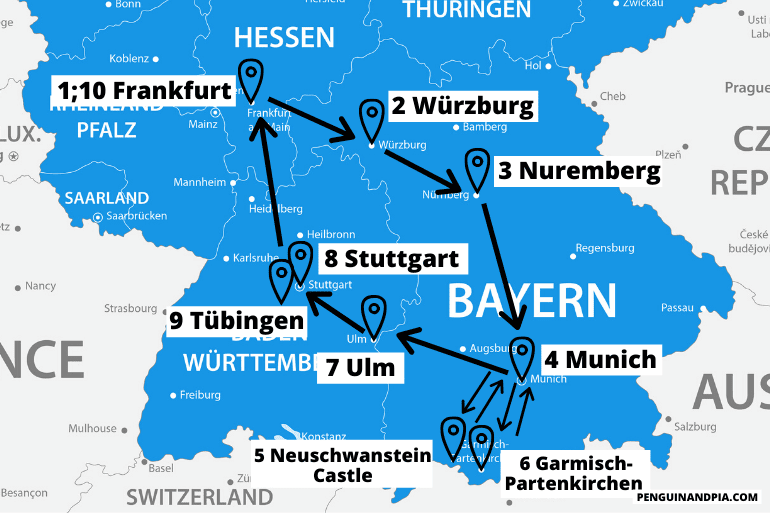
Day 1: Frankfurt Day 2: Würzburg Day 3: Nuremberg Day 4: Munich Day 5: Day Trip to Neuschwanstein Castle Day 6: Day Trip to Garmisch-Partenkirchen Day 7: Ulm Day 8: Stuttgart Day 9: Day Trip to Tübingen Day 10: Frankfurt
Similar to the northern version of this itinerary for 10 days, you begin your adventure in Frankfurt. During your day in the city, you shouldn’t forget to visit the Römerberg with the beautiful half-timbered houses. If you want to get a nice few of the city from above, then you should look into visiting the Main Tower as well.
Frankfurt is also a great place to pick up your rental car – if you decide to complete this itinerary by car instead of using public transport. You can either pick up a car at the airport or at different spots in the city centre. This obviously also depends on the rental company you choose.
Accommodation in Frankfurt: Frankfurt is full of accommodation options – from the city centre to the airport. You can check here for accommodations and hotels in Frankfurt .
For a hotel in the heart of the city, check out the Motel One Frankfurt-Römer . Complete with underground parking, good breakfast, and a top location in the centre and close to the river, this hotel is a decent option if you are travelling around with a car.
For those not travelling with a car (and taking the trains around Germany), check out Fleming’s Express Hotel Frankfurt . This nice looking hotel is really popular for its breakfast, price, and the fact that it’s steps from the central train station.
Day 2: Würzburg
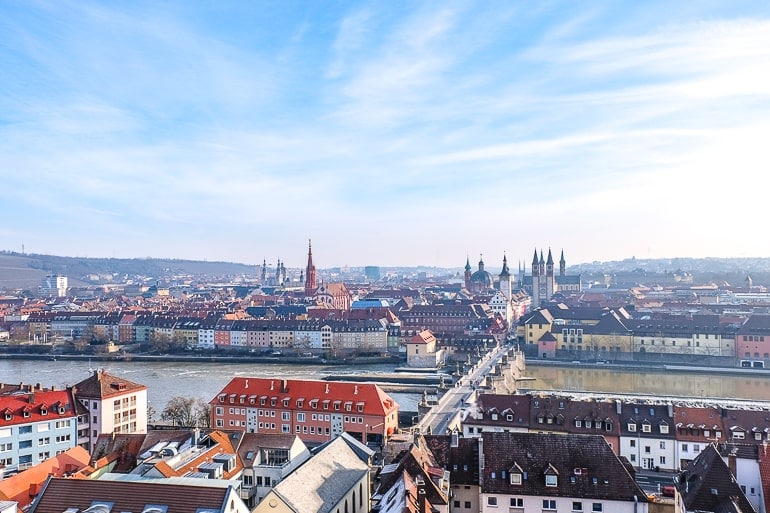
On day two of this itinerary, you’ll be on your way to Würzburg, a small German city that we’re always happy to return to. Similar to Stuttgart, Würzburg is located in a region that is known for its wine.
As such, it comes as no surprise that a highlight in Würzburg is to drink a glass of (white) wine on the Old Bridge across the Main river. We’ve done that multiple times and would especially recommend it during the evening when it gets dark.
Another thing you shouldn’t miss in Würzburg is the short walk up the hill to Marienberg Fortress. Up there you can not only explore the old fortress, but you also get a beautiful view of the old town and other parts of the city.
We actually wrote a whole guide about Würzburg (link below) where we not only talk about things to do but also mention some great cafes and restaurants!
The drive from Frankfurt to Würzburg will be a short one. It should only take you around 1 h 20 minutes by car and between 1 h 07 minutes and 1 hr 50 minutes by train depending on the type of train you’re taking (ICE vs. regional train).
Accommodation in Würzburg: Würzburg isn’t a huge city so you’ll find a number of places to stay packed together in the city centre and a number of other hotels and guesthouses around. You can check here for accommodations and hotels in Würzburg .
On a recent trip, we stayed at the Best Western Hotel Würzburg-Süd . It’s a little south of the city centre but the tram stop is right outside the hotel so you’re into the historic city centre in minutes. There is also an onsite parking lot if you’re arriving to Würzburg by car. We booked this one last minute but we would stay again.
If you want to stay a little more central, then you can check out Hotel Strauss . With a location close to the river, the train station, and the city centre – it’s a great option fo those arriving by train.
We also once stayed at Hostel Babelfish for a budget accommodation and it was honestly not too bad, either. It’s right across from the train station for easy access in and out of the city.
Must-see Attractions in Würzburg:
- Marienberg Fortress
- Würzburg Residence
If you want more tips for visiting Würzburg, have a look at our detailed Things to do in Würzburg Guide (+ insider tips) .
The next day you’ll be on your way to Nuremberg, which is another city in Bavaria that we really like. In German, Nuremberg is actually written/called “Nürnberg” – just an FYI, so you’re not confused when you see this written somewhere.
As we have already mentioned in the description of one of the shorter itineraries, there is a lot of history to be found in the city. Not only can you explore an old castle in the middle of the city, you can also learn a lot about Germany’s dark history if you’re interested.
Getting from Würzburg to Nuremberg will take approx. 1 hr 20 minutes by car and between 53 minutes (ICE) and 1 hr 13 minutes (regional) by train . If you’re travelling with more people and decide to just take a regional train, look into getting a “Bayernticket” as that could save you some money.
Accommodation in Nuremberg : Nuremberg is a larger and well-travelled city in Germany so you will have no problem finding a place to stay! You can check here for accommodations and hotels in Nuremberg .
We ended up staying in the very popular Five Reasons Hotel and Hostel and we enjoyed our stay. The room was bright with new furnishings. It’s also located just inside the old city walls so we were close to the metro, a short walk to central train station, and also close to the heart of the old town!
Very nearby was the Sheraton Carlton Nuremberg – we had friends stay there. They really liked this hotel which had a swimming pool with city views and other great perks. If you are arriving to Nuremberg by car, there’s a parking lot across the street from the hotel as well as street parking around. The train station is very close as well so it’s a great location overall.
- Documentation Center Nazi Party Rally Grounds
Day 4: Munich
On day four of this Germany trip, you’ll be on your way to Munich. As you might know Munich is the capital of the German state called Bavaria and there are lots of things to do in this city.
That’s why you’ll spend three nights in Munich. This way you can explore the city in more detail if you want or go on a couple of day trips from Munich to see other popular attractions as well. It’s really up to you.
The journey from Nuremberg to Munich won’t be overly long and it’s a route Lisa has driven many times. It’ll take you around 2 hrs by car (of course traffic depending) and between 1-3 hrs by train.
Since this is a popular train route, there are lots of different connections of varying length – some are quick and others are slower trains with more stops. Since that’s the case, we’d recommend that you plan in advance and try to catch a better connection to avoid an unnecessarily long train ride!
Accommodation in Munich: Since Munich is such a popular and large city, there are plenty of accommodation options for you to choose from. You can check here for accommodations and hotels in Munich . Just remember to book your accommodation for three nights if you are following this itinerary!
We stayed at the H2 Hotel München Olympiapark which is a very popular hotel because of the price and the value. It was a prefect stay. The breakfast was amazing, they had parking, and the location was great – only a quick metro to the heart of the city centre. You also have the Olympic Park and BMW Museum as top attractions nearby!
If you’re itching to stay right in the heart of the action in Munich, check out the Platzl Hotel Superior . This is a hotel around the corner from Marienplatz in the old town with the famous beer hall Hofbräuhaus just steps away. The central train station is also walkable from here.
Of course, you can learn all about the best areas to stay in more detail with our Munich accommodation and neighbourhood guide .
Learn more about Munich with our one day in Munich post!
Day 5: Day Trip to Neuschwanstein Castle
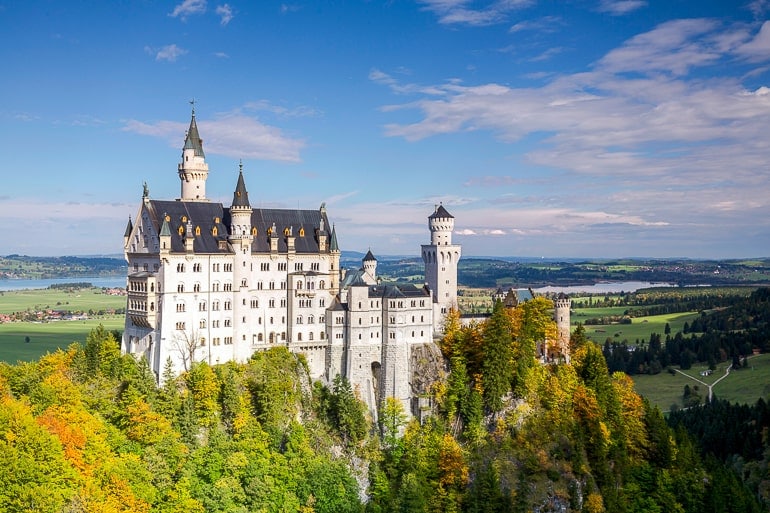
Neuschwanstein Castle probably doesn’t need a lot of introduction – it is arguably one of the most popular day trips from Munich. If you want to see this fairy-tale castle with your own eyes, then this day trip might be for you.
However, it is such a popular attraction that depending on the time of year it can get incredibly crowded. So if you are planning this itinerary for the middle of summer, we’d honestly recommend that you think twice about whether you really want to do this day trip. A second day in Munich wouldn’t be so bad either, would it?
If you are set on visiting Neuschwanstein Castle, then have a look at our Day Trips from Munich Guide . In that article – under the Neuschwanstein Castle section – we talk about all the different ways you can get to the castle.
In case you don’t want to stress too much about logistics and are not travelling with a rental car, you could always look into a day tour that brings you to Neuschwanstein Castle and then back to Munich. Here are some examples:
- Neuschwanstein and Linderhof Palace – A very popular tour to check out two castles in one day!
- Just Neuschwanstein Castle – Grab your live guide and check out the classic castle you came to see!
- Neuschwanstein Castle and Füssen – Explore the surrounding area on this day trip + see that great castle!
Day 6: Day Trip to Garmisch-Partenkirchen
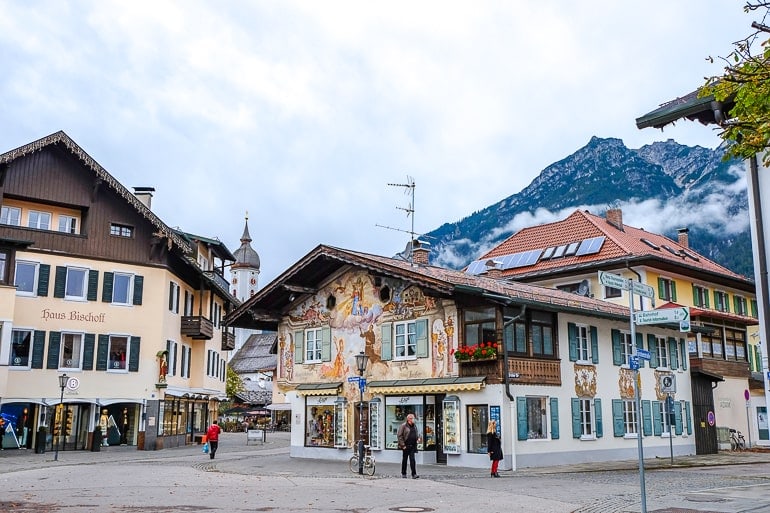
Another popular day trip from Munich – and the one we would recommend for Day 6 of this itinerary – is a trip to Garmisch-Partenkirchen in the south of Bavaria, close to the Austrian border.
We have been to Garmisch-Partenkirchen recently and really enjoyed our day there. However, that was during the shoulder season, so we can’t really say much about how busy it gets in the summer or during the ski-season.
There are a few good reasons for visiting Garmisch-Partenkirchen. The obvious one is that the town is super close to the mountains and it is very easy to reach the “Zugspitze” (Germany’s highest mountain) from here.
Of course, you don’t have to go that high up – there are also lots of other mountains and great hiking trails in the area if you’re looking for a day in nature.
Other reasons why people come to Garmisch-Partenkirchen is to visit the Partnach Gorge which is quite beautiful and/or the old town where you can admire the decorative paintings found on many houses.
It’s actually quite easy to get from Munich to Garmisch-Partenkirchen. By car , it should take you around 1 hr 10 minutes and by train the journey would be approx. 1 hr 22 minutes . It’s actually a nice drive/train ride since you’ll get some great views of the mountains as you get closer to your destination.
Must-see Attractions in/close to Garmisch-Partenkirchen:
- Partnach Gorge
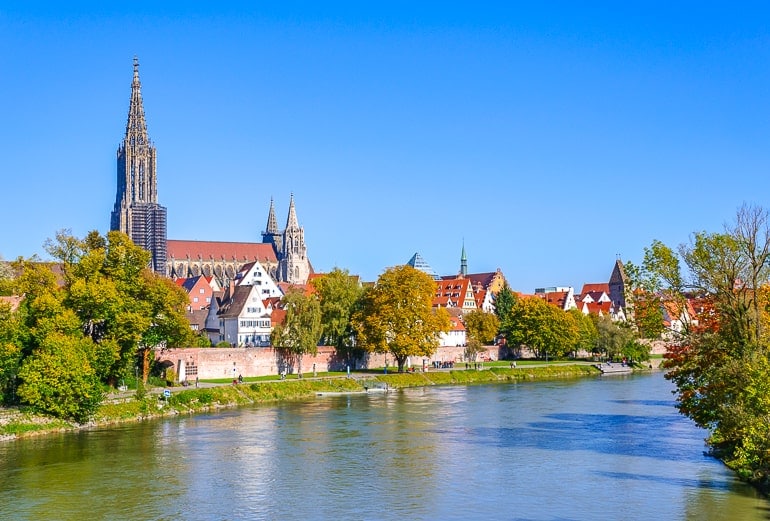
The following day you’ll travel from Munich to Ulm, a small city in the German state of Baden-Württemberg. It is actually located right by the border with Bavaria – “Neu Ulm” in fact is a city on the Bavarian side. When you’re there, it sometimes feels like it is just one bigger city. For you as a visitor, this doesn’t really matter – just an interesting side note.
Ulm is mainly known for having the church with the tallest steeple in the world – so that is something you shouldn’t miss during your visit. Other than that, we’d also recommend that you check out the Fishermen’s Quarter where you can find some beautiful, half-timbered houses.
Getting from Munich to Ulm won’t take you long. The journey will take approx. 1 hr 40 minutes by car and between 1 hr 19 minutes and 2 hrs by train. Once again, this depends on which type of train connection you choose (ICE vs. regional trains).
Accommodation in Ulm: It’s best to stay in the centre of Ulm since it’s not huge and the attractions can mostly be found there. You can check here for accommodations and hotels in Ulm .
For a boutique hotel option right in the city centre, check out Boutique 005 Ulm City . This hotel is super walkable to the train station if you are arriving by train but also offers an option for parking. It’s location makes it really close to all the top attractions in the city.
For a stay closer to the river, you can check out the Hotel am Rathaus – Hotel Reblaus . With onsite parking available and a really good breakfast, this more “authentic” hotel is an experience not to be missed in Ulm.
Must-see Attractions in Ulm:
- Ulmer Münster
- Fishermen’s Quarter
Day 8: Stuttgart
From Ulm, you’ll head to Stuttgart on the next day. Stuttgart is a city that we have mentioned a few times in this article already. If you’ve read some of the other itineraries, you’ll know that Stuttgart is known for both cars and wine.
Of course, there’s more to see in the city than that. If you’re interested in architecture, you might enjoy visiting the New Palace at the “Schlossplatz” and if you’re into art, the Staatsgalerie (an art museum) might be for you.
Getting to Stuttgart from Ulm will only take slightly over 1 hr by car and approx. the same amount of time by train . There are slower trains – called RB instead of RE which stands for “Regional Express” – that take longer than that. However, if you plan ahead, you shouldn’t have a problem catching an RE or ICE Train since they run frequently throughout the day.
Accommodation in Stuttgart: Since there are a number of places to stay in, you can check here for accommodations and hotels in Stuttgart .
Those with a car can check out the Abalon Hotel ideal because it has an underground parking garage while those travelling to Stuttgart by train can check out the Pension am Heusteig since it’s easy to get to walking or with the metro.
Day 9: Day Trip to Tübingen
On day 9 of this itinerary, you have the choice between either spending a second day in Stuttgart or taking a day trip to Tübingen, a university town not far away.
Tübingen is a popular day trip from Stuttgart and is mainly known across the country for its old university. In fact, some of Lisa’s friends have studied there. When in town, you shouldn’t forget to visit the market square with its 15th century town hall. Another popular attractions is the Hohentübingen Castle on the hill which nowadays is home to a museum.
It won’t take you long at all to get to Tübingen from Stuttgart. That makes it great for a (half-)day trip. The journey should only take around 42 minutes by car and between 43 minutes and 1 hr 30 minutes by public transport – depending on the connection you choose.
Must-see Attractions in Tübingen:
- Hohentübingen Castle
- Market Square with Town Hall
- Hölderlinturm
Day 10: Frankfurt
On the last day, you’ll make your way back to Frankfurt. This is where your itinerary ends since it will hopefully be easy for you to get back home from here.
The journey from Stuttgart back to Frankfurt will probably be the longest one for this trip – but it’s still easily doable. It should take you approx. 2 hrs 25 minutes by car and between 1 hr 17 minutes and 3 hrs 30 minutes by train. Once again, this is dependent on the connection you choose (ICE vs. regional trains).
Accommodation in Frankfurt: Since you’re back in Frankfurt, we already went over accommodations in Day 1 of this same itinerary. That said, you can check here for accommodations and hotels in Frankfurt and specifically check out the Motel One Frankfurt-Römer for a central hotel with parking.
Germany Itinerary 14 Days
This Germany itinerary is the longest one that we have for you – for now. If anyone is interested in a 21 day version, please let us know!
The distance you’d cover with this 14 day itinerary would be around 1960 kilometres . The driving time would be approx. 22.5 hours – but of course, this varies depending on traffic and the exact route you decide to take.
As you’ll see below, sometimes the driving time between two cities is longer than 3 hours. So, while this itinerary is totally doable in two weeks – if you wanted to slow down the pace a bit, you could just as easily spend more time in some of the cities and complete the itinerary in more days.
Since you have probably already read about most of these places in some of the itineraries above, we’ll try to keep the descriptions short and not get too repetitive.
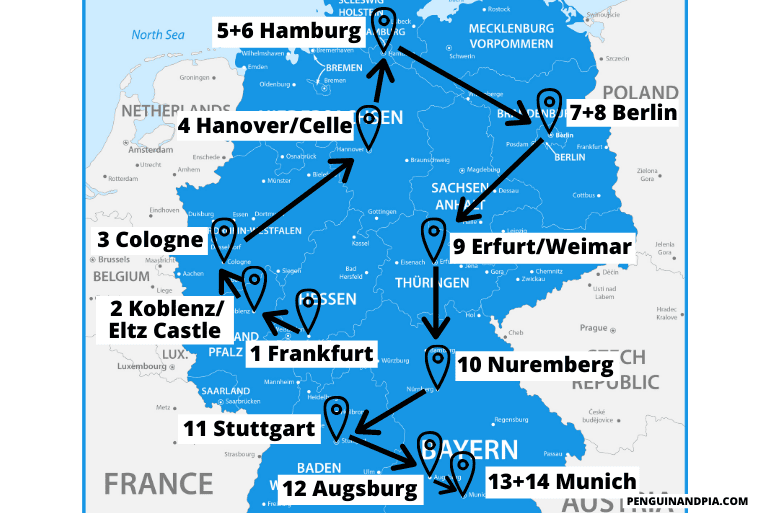
Our version here is written as an “incomplete route” from Frankfurt to Munich. However, as with most of our itineraries, you are welcome to reverse the direction if that works better for you and/or start and end in the same city. So, to see a big part of the country, your 14 day Germany itinerary could look something like this:
Day 1: Frankfurt Day 2: Koblenz / Eltz Castle Day 3: Cologne Day 4: Hanover or Celle Day 5+6: Hamburg Day 7+8: Berlin Day 9: Erfurt or Weimar Day 10: Nuremberg Day 11: Stuttgart Day 12: Augsburg Day 13+14: Munich
Once again we begin this itinerary in Frankfurt since it is an easy city to get to. As we have mentioned before, there are a few things to see in the city so you can start exploring on day one!
Frankfurt is also a great city to pick up a rental car. Since many international (business) travellers fly into Frankfurt, there should be many cars available with automatic transmissions. In smaller German towns you’ll find that this is not always the case.
Accommodation in Frankfurt: If you are making a stop in Frankfurt, you can check here for accommodations and hotels in Frankfurt .
As for accommodation options, the Motel One Frankfurt-Römer has parking available and is located in the city centre close to the Main River. That’s important if you have a car with you but it’s also walkable to the train station, so you know.
Another great hotel option that is even closer to the train station is Fleming’s Express Hotel Frankfurt . This hotel is known for its prime location to the north of the station, its tasty breakfast, nice decor, and fair price. This is definitely a popular place you should at least look into if you are travelling by train around Germany.
Day 2: Koblenz / Eltz Castle
On day two of this itinerary, you’ll be on your way to Koblenz, a small German city on the Rhine river. You can either explore the city or use it as a base to visit one of the many castles close by.
Our suggestion would be a visit to Eltz Castle which is a beautiful medieval castle surrounded by a forest. Please keep in mind that the castle is not open year round. You can check opening hours here .
You could also visit Eltz Castle as a day trip from Frankfurt but then you’d have to return to Frankfurt at the end of the day. This wouldn’t make much sense unless you want to spend some more time in Frankfurt anyway, as Cologne (your next destination) is closer to Koblenz and Eltz Castle than Frankfurt.
The drive from Frankfurt to Koblenz should take around 1 hr 30 minutes by car . If you want to take the train , the journey would take between 1 hr 30 minutes and 2 hrs 15 minutes . From Koblenz, it is only about a 30 minute drive to Eltz Castle.
Accommodation in Koblenz: Since Koblenz isn’t that large, you should have no problem finding and choosing an accommodation that works for you. You can check here for accommodations and hotels in Koblenz .
If you want a popular option right in the heart of the city centre, you should see the Sander Hotel . This hotel is located within walking distance to the rivers as well as restaurants and shops in the centre. If you travel by car to Koblenz, they have onsite parking which is handy. That said, you can also easily walk from the hotel to the train station in minutes.
Day 3: Cologne
The next stop on your 14 day Germany itinerary is Cologne, a city we have mentioned already in some of the previous itineraries. As you might know, the highlight of the city is the Cologne cathedral which is quite an impressive sight. As the city is located on the Rhine river, a boat tour might also be a great activity depending on the time of year you are visiting.
Getting to Cologne from Koblenz takes around 1 hr 15 minutes by car and between 50 minutes and 1 hr 15 minutes by train . The train tracks follow the Rhine river for part of the journey which allows for some beautiful views!
Accommodation in Cologne : There are lots of great places to stay in Cologne. You can check here for accommodations and hotels in Cologne .
We recently stayed at the Lindner Hotel City Plaza which was great value for money. The breakfast buffet is incredible and it’s an easy, short walk into the city centre near the Cathedral. It also has parking available for those with a car.
If you want to stay a little closer to the river and the Old Town, check out the CityClass Hotel Residence am Dom . With many things around to keep you busy – like attractions, food, and/or drinks – you’re just a short walk to the central train station if you stay here.
For those looking for a hostel, Cologne Downtown Hostel was a great stay for Eric a number of years ago. It’s really popular, in a great location, and has a nice rooftop balcony to enjoy.
Day 4: Hanover or Celle
Day 4 of this itinerary will take you to either Hanover or Celle depending on your preference. Celle is a noticeably smaller city/town than Hanover and the two places are only a few minutes apart.
Getting from Cologne to Hanover will take approximately 3 hrs 10 minutes by car and between 2 hrs 40 minutes and 3 hrs 5 minutes by train .
Accommodation in Hanover: Since Hanover is a well-travelled city for people moving around Germany, there are a number of accommodation options in and around the city centre. You can check here for accommodations and hotels in Hanover .
To stay very close to the central train station in the city centre, you should see the Hotel Loccumer Hof . The location makes it great if you are travelling by train and on foot. They also have onsite parking if you are arriving to Hanover with a car!
To the south of this hotel, the Arthotel ANA Prestige am neuen Rathaus is an option right across from the New Town Hall. This hotel has a beautiful, light style and is also close to the water/parks. Complete with breakfast and onsite parking, you can’t go wrong here!
If you want to spend a night in a smaller German city instead, then Celle is a good option as it is not far from Hanover. That will make it easy to reach the next stop on your itinerary without too much of a detour. The journey from Cologne to Celle would be slightly longer and take around 3 hrs 30 minutes by car and 3 hrs 19 minutes by train .
Accommodation in Celle: Celle isn’t that big at all – so there are only a handful of places to stay. That said, there are still some great options. You can check here for accommodations and hotels in Celle .
Of note, check out Hotel Borchers . This hotel – one of only a handful located in the heart of “city centre” is a top pick with a tasty breakfast and an underground car park. You can also walk there from the Celle train station which is located not too far across town.
Must-see Attractions in Celle:
- Celle Castle
- Bomann Museum
- French Garden
Day 5+6: Hamburg
An itinerary across a large part of the country wouldn’t really feel complete without including Hamburg. Since there is quite a bit to see in this hanseatic city, you’ll spend two nights in the city to give you more time to explore.
Getting from Hanover to Hamburg will take you approx. 1 hr 45 minutes by car and between 1 hr 15 minutes and 2 hrs 30 minutes by train . As mentioned before, this varies depending on the type of train connection you choose.
The journey from Celle to Hamburg will be approximately 15 minutes shorter at 1 hr 30 minutes by car . If you opt for the train, you can expect travel times between 1 hr 10 minutes and 2 hrs .
Accommodation in Hamburg : Since Hamburg is a well-travelled city, it makes sense that there are loads of places and areas to stay in. You can check here for accommodations and hotels in Hamburg .
The Mövenpick Hotel Hamburg might work for those with a car since they have onsite parking. This old water tower is a different hotel than you might be used to but it’s a great experience overall.
Something closer to the central station to get to on foot would be the ARCOTEL Rubin Hamburg which is located in St. Georg. This is an area with shops and restaurants and is very much part of the city centre.
Those looking for a budget accommodation can check out Generator Hamburg which is a popular hostel close to the train station. If you’re ever unsure or want more advice, we have a detailed guide on where to stay in Hamburg .
Day 7+8: Berlin
Of course, we couldn’t forget to include a stop in the capital of the country when planning a longer trip through Germany. Since there is so much to do and see in Berlin you will spend two nights there.
This will also give you some more time to recover from all the driving you have done so far on this journey. Getting from Hamburg to Berlin takes approximately 3 hrs 20 minutes by car (obviously traffic depending) and just about 1 hr 50 minutes by train .
Accommodation in Berlin : There are lots of hotel options in Berlin. You can check here for accommodations and hotels in Berlin .
The Park Plaza Wallstreet Berlin Mitte is a good option in the city centre for those coming to Berlin with a car while the NH Collection Berlin Mitte am Checkpoint Charlie is located right at the attraction “Checkpoint Charlie” in the city centre.
A great option for a hostel/hotel where Eric stayed a few years back is PLUS Berlin . You can find it near the famous East Side Gallery which is a very popular attraction to check out.
As mentioned a few times now, we also have more articles on t hings to see in Berlin and a one day Berlin itinerary .
Day 9: Erfurt or Weimar
For the following day you have the choice between Erfurt or Weimar as your next destination. Both are small cities in the state of Thuringia with Weimar being smaller than Erfurt. If you know anything about Martin Luther, an important figure in the Protestant reformation, then you might have heard of one or both of these places before.
If you’re looking for a place with a beautiful old town and some nice churches as well as buildings for you to explore, then we’d really recommend Erfurt. We had a great time during the days we spent there. The city also has some really nice, cozy cafes if that is something that you care about.
Getting to Erfurt from Berlin will take a while – but it is a great stop on the way to the south of Germany. You can expect the journey to take approx. 3 hrs 40 minutes by car and just around 1 hr 50 minutes by ICE (fast train) .
Accommodation in Erfurt: With Erfurt being a smaller city with a smaller central area to explore, finding a place to stay isn’t too difficult. You can check here for hotels and accommodations in Erfurt .
When we visited Erfurt, we booked the Gästehaus in der Gotthardtstraße . This was a simple guesthouse with a nice host and cozy rooms located just a short walk north of the Krämerbrücke. There’s also a small parking lot onsite if you’re coming to Erfurt with a car.
For a stay that is more central, check out Hotel Krämerbrücke Erfurt . It’s located basically right beside the Krämerbrücke making it a great option if you are travelling by train and you’re on foot.
Once again, if you want to learn some more about Erfurt before you visit the city, check out our detailed Erfurt Guide here .
If you instead preferred to learn some more about the well-known German writers Goethe and Schiller – or about Germany’s dark past – then you should plan to visit Weimar instead.
Two of the highlights there are Goethe’s and Schiller’s House – now turned into museums. Close to Weimar there’s also the Buchenwald Memorial which was a former Nazi concentration camp. This was the first KZ-Memorial Lisa ever visited. It was a somber experience, but also an important one in regards to understanding more about Germany’s past.
The journey from Berlin to Weimar will be slightly shorter than to Erfurt – at least by car. It’ll take approx. 3 hrs 15 minutes by car and around 2 hrs 20 minutes by train .
Accommodation in Weimar : There are a handful of places to stay in Weimar since it’s a smaller city – but you still have good options. You can check here for accommodations in Weimar .
In particular, check out Amalienhof Hotel und Apartment . This classic and very popular hotel is just south of the heart of the city centre. It features parking onsite and an excellent breakfast. It’s also not too far to walk to the train station if you are arriving on foot.
Must-see Attractions in/close to Weimar:
- Buchenwald Memorial
- Goethe’s House
- Schiller’s House
Day 10: Nuremberg
On day 10 of your itinerary, you’ll drive – or take the train – from Erfurt/Weimar to Nuremberg. This Franconian city has also been mentioned in some of the shorter itineraries.
The journey from Erfurt to Nuremberg will take approx. 2 hrs 40 minutes by car in a southern direction. The drive from Weimar to Nuremberg will just be a couple minutes longer.
If you decide to take the train, the journey would take between 1.5 hrs and 2 hrs from Weimar and between 1 hr 10 minutes and 1 hr 30 minutes from Erfurt .
Accommodation in Nuremberg : Nuremberg is a city with loads of history and attractions so it’s very popular. As such, you will find hotels and accommodations all over the city – from the old town to the surrounding areas. You can check here for accommodations and hotels in Nuremberg .
We booked a stay at Five Reasons Hotel and Hostel and we would recommend it. You can find the place inside the massive old city walls so the location was great – walkable to the central train station and also to go find top attractions.
On the same trip, friends of our stayed at the Sheraton Carlton Nuremberg . It was close to where we stayed and they really enjoyed it. There’s this great pool on an upper floor with city views as well as a parking lot across the street if you travel to Nuremberg by car. The train station is close as is the old town by walking so it’s great option overall, too.
Day 11: Stuttgart
The following day you will be on your way from Nuremberg to Stuttgart – once again, a city we have mentioned multiple times now during this article. From Nuremberg, it’ll take you around 2 hrs 15 minutes by car and between 2 hrs 10 minutes and 2 hrs 30 minutes by train to get to Stuttgart.
As we’ve mentioned before, if you are driving and have the time, you could take a small detour and stop in Rothenburg ob der Tauber for a stroll through its beautiful old town. We’ll leave that up to you!
Accommodation in Stuttgart: You can check here for accommodations and hotels in Stuttgart .
The Abalon Hotel ideal has parking for those with a car while the Pension am Heusteig is a guesthouse close by but is easy to get to by the metro system if you arrive by train to central station and you are walking.
Day 12: Augsburg
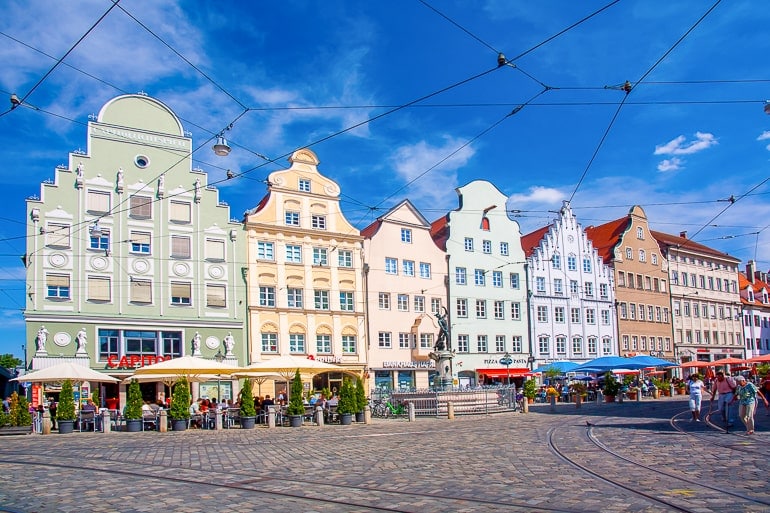
On day 12 you’ll be on your way from Stuttgart to Augsburg, a small city in Bavaria and one of Germany’s oldest cities. Around Germany, most people have heard of Augsburg because of its “Fuggerei” – a historic social housing complex where rent has increased very slowly over the centuries. It’s certainly worth a visit!
It’ll take you around 2 hrs by car to get from Stuttgart to Augsburg. If you opt for the train , then you can expect the journey to take approx. 1 hr 40 minutes .
Accommodation in Augsburg: In Augsburg, you will find a number of places to stay around the city centre. You can check here for accommodations and hotels in Augsburg .
For a reliable stay, check out Hotel Augusta . This popular hotel – located right in the city centre – features breakfast and has parking available if you are travelling to Augsburg by car.
The nice thing about Augsburg is that because it’s a smaller city, you can easily walk to the hotel from the train station if you are arriving by train.
You might also check out City Hotel Ost am Kö which is another hotel in the heart of the centre walkable to the station. It also has breakfast and parking garage right nearby.
Must-see Attractions in Augsburg:
- Augsburg Cathedral
- Perlach Tower
Day 13+14: Munich
On your second to last day of this itinerary you will drive from Augsburg to Munich. That’s the last stop on your two week Germany adventure. In Munich, there is more than enough to see to spend two days in the city.
Munich also has an airport with good international connections in case you’re coming from overseas and need to take a plane to get back home. If that’s not the case, we’d encourage you to see whether the train would be an alternative to get you back home as well.
The journey from Augsburg to Munich should take just less than 1 hr by car and between 30 and 48 minutes by train. So it’s certainly one of the shortest transitions mentioned in this article.
Accommodation in Munich: If you’re exploring Munich while in Germany, there is no shortage of places to stay and areas to check out. You can check here for accommodations and hotels in Munich . For this itinerary, remember to book your Munich accommodation for two nights.
We really liked our stay at the H2 Hotel München Olympiapark . From the really good breakfast, nice rooms, and excellent location with metro access nearby – you cannot beat the price for Munich. There’s also parking available if you’re travelling with a car to Munich.
For a spot right in the heart of Munich’s charming old town, check out the Platzl Hotel Superior . This is a trendy hotel that puts you super close to all the action at busy Marienplatz and is steps from Hofbräuhaus, the beer hall made famous decades ago. You can also catch the metro or walk to the central train station from here.
If you are looking for more details on accommodations in this city, we wrote a detailed guide on where to stay in Munich .
To learn more about the city – as we have mentioned before – check out our post on Munich in a day if you want more details about the city!
And there you have it – one massive Germany guide with more than one Germany itinerary to suit your travel needs! Whether you’re looking for a short 5 day or a wild 14 day itinerary – we’re sure you’ll have a great time exploring Germany. We’re actually really happy to have created this post – Lisa especially. It’s always fun to help others explore your home country!
As always, Happy Germany Itinerary Waddlin’, – L&E
- Compare flights on Skyscanner
- Check for Hotel Deals or Book A Hostel
- Get A Rental Car (depending on the destination)
- Research plug types and possibly get a travel adapter
- Go over our packing list
Pin it for later!
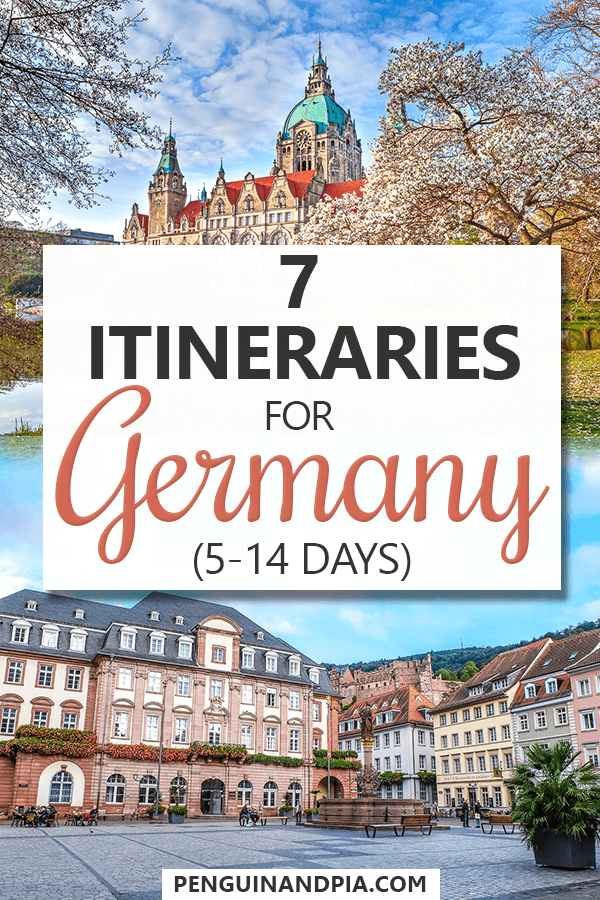
As an Amazon Associate we earn from qualifying purchases.
Destinations
Privacy policy
Disclaimer & Affiliate Disclosure
Terms of use
© 2024 Creativlier Media Inc.
Flight search
- Adults Remove adult 1 Add adult
- Children Aged 2-11 Aged 2 to 11 Remove child 0 Add child
- Infants In seat Remove infant in seat 0 Add infant in seat
- Infants On lap Remove infant on lap 0 Add infant on lap
- Premium economy
Cheap flights from Cercola to Frankfurt
Good to know, when is the cheapest time to fly, popular airports near cercola.
- Naples International Airport (NAP) Naples 16 min 6 km
- Leonardo da Vinci–Fiumicino Airport (FCO) Rome 2 hr 34 min 205 km
- Bari International Airport-Karol Wojtyla (BRI) Bari 2 hr 30 min 204 km
- Giovan Battista Pastine International Airport (CIA) Rome 2 hr 8 min 180 km
Popular airports near Frankfurt
- Frankfurt Airport (FRA) Frankfurt 27 min 11 km
- Hahn Airport (HHN) Frankfurt 1 hr 41 min 103 km
- Munich International Airport (MUC) Munich 4 hr 5 min 298 km
- Düsseldorf Airport (DUS) Düsseldorf 2 hr 45 min 187 km
Frequently asked questions about flying from Cercola to Frankfurt
Search more flights, popular trips from cercola.
These suggestions are based on the cheapest fares to popular destinations in the next six months.
Prices include required taxes + fees for 1 adult. Optional charges and bag fees may apply.
- Paris RUB 6,080 Nov 8 — Nov 10 Nonstop 2 hr 30 min Ryanair
- London RUB 8,297 Sep 26 — Sep 29 Nonstop 2 hr 50 min easyJet
- Madrid RUB 7,584 Jan 9 — Jan 12 Nonstop 2 hr 45 min Iberia Express
- Barcelona RUB 5,203 Oct 17 — Oct 20 Nonstop 2 hr Ryanair
Find flights from Cercola to anywhere
More places to fly.

HUT ke-79 RI, KJRI Frankfurt Adakan Pesta Rakyat
- 19 Aug 24 | 09:09

Follow IDN Times untuk mendapatkan informasi terkini. Klik untuk follow WhatsApp Channel & Google News
Frankfurt , IDN Times - Serangkaian acara peringatan Hari Kemerdekaan ke-79 RI digelar di Wisma Konsulat Jenderal Republik Indonesia Frankfurt pada Sabtu (17/8/2024). Acara tersebut merupakan acara rutin yang diadakan setiap tahun di bulan Agustus.
Acara dimulai dengan upacara bendera pukul 09.30 waktu setempat. Kemudian dilanjutkan dengan pesta rakyat yang dibuka pukul 11.15 dan langsung dibanjiri ribuan pengunjung dari berbagai daerah di Jerman .
1. Upacara bendera dihadiri oleh lebih dari 650 peserta
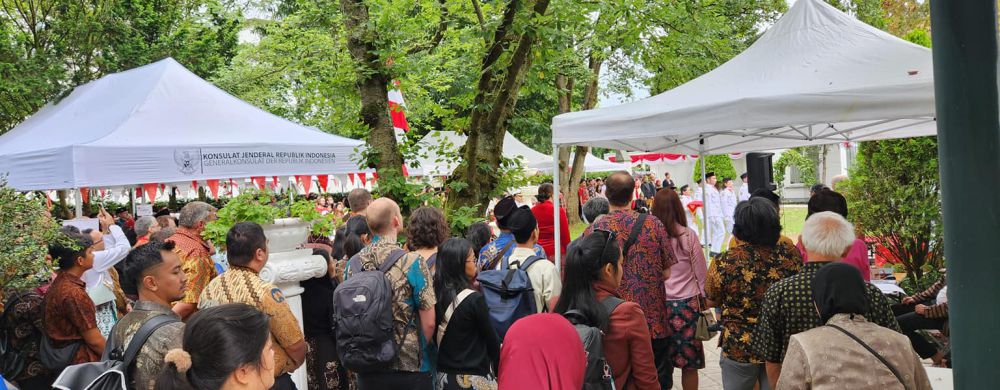
Dalam rangka memperingati HUT ke-79 RI, KJRI Frankfurt mengadakan upacara pengibaran bendera merah putih. Upacara yang dihadiri lebih dari 650 peserta tersebut berlangsung tertutup. Konsul Jenderal RI, Antonius Yudi Triantoro bertindak sebagai inspektur upacara dan Mayor Laut (P) Ardi Pradana sebagai komandan upacara.
Delapan orang putera dan puteri terbaik Indonesia terpilih sebagai Paskibra. Sedangkan pembaca teks proklamasi, pembaca doa, dan dirigen yang bertugas adalah WNI dari berbagai daerah di Jerman yang ada di wilayah kerja KJRI Frankfurt.
2. Rangkaian acara telah digelar sejak Juli 2024
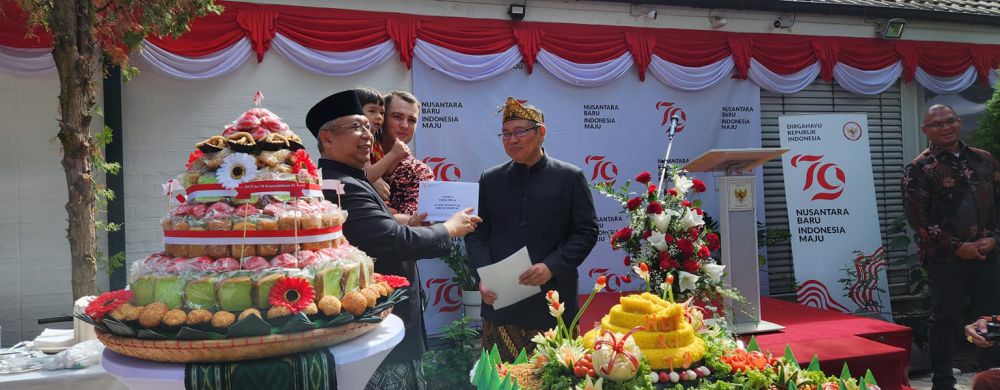
Rangkaian perlombaan dan kegiatan peringatan hari kemerdekaan telah dimulai sejak Juli 2024. Fun walk sepanjang 4 km yang dilaksanakan pada 27 Juli 2024 merupakan kegiatan pembuka dari rangkaian acara perayaan HUT ke-79 RI.
Beberapa perlombaan yang telah selesai dilaksanakan diantaranya pingpong, catur dan gaple. Sedangkan perlombaan untuk anak-anak yaitu musical chair , makan kerupuk dan balap kelereng.
3. Musik dan tarian tradisional mendominasi acara pesta rakyat di Wisma KJRI Frankfurt
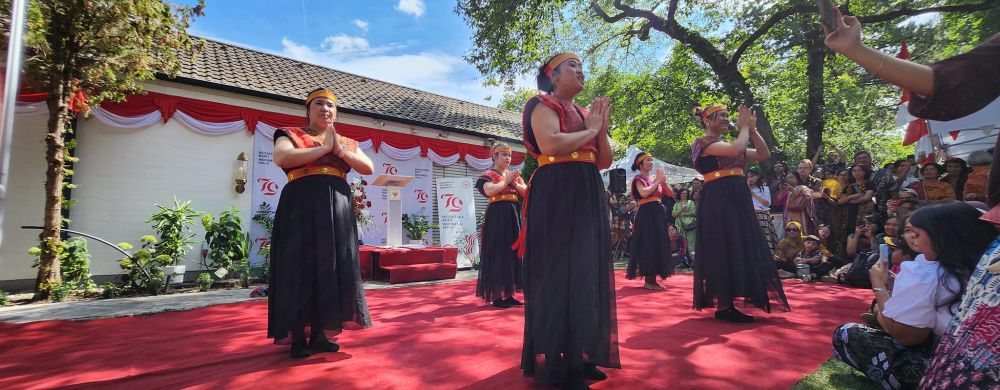
Pesta rakyat HUT ke-79 RI didominasi oleh tarian dan musik tradisional Indonesia. Alat musik angklung dimainkan di awal acara. Salah satu lagu yang dinyanyikan dengan iringan musik angklung adalah Bengawan Solo. Pada pertengahan hingga akhir acara, tari-tarian tradisional ditampilkan secara bergantian. Di antaranya tari tor-tor, tari ruai, tari topeng dan tari kuda lumping.
Baca Juga: Meriahnya Perayaan Hari Kemerdekaan RI di Puncak Gunung Sibayak
3. Banjir kuliner Indonesia

KJRI Frankfurt menyediakan makanan gratis berupa nasi kuning, aneka kue tradisional dan aneka minuman. Sayangnya makanan yang disediakan tidak mencukupi jumlah pengunjung yang membludak.
Editor’s picks
- Jessica Wongso Hirup Udara Bebas
- PDIP Desak Polisi Segera Usut Kasus Dugaan Pencatutan KTP Warga DKI
- PKS Pastikan Gabung KIM Plus, Dukung Ridwan Kamil di Pilkada DKI 2024
Untuk mengantisipasi kekurangan makanan, panitia acara pesta rakyat membuka bazar kuliner. Makanan yang dijual diantaranya nasi padang, asinan, gorengan, nasi bakar, bakso, es cendol, siomay dan masih banyak lagi. Harga yang ditawarkan mulai dari 2 euro atau Rp34.000.
4. Berbeda dengan acara tahun sebelumnya
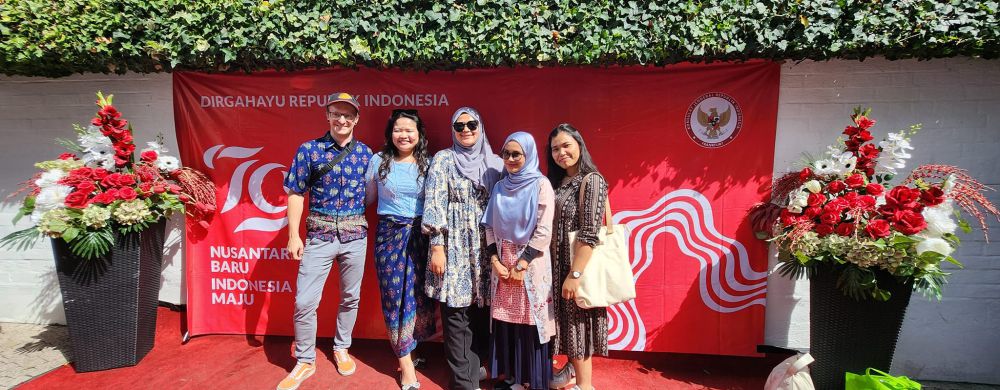
Zelin Aprilia yang datang dari kota Heidelberg mengungkapkan pesta rakyat tahun ini berbeda dengan tahun sebelumnya. WNI yang bekerja di bidang bantuan untuk orang berkebutuhan khusus ini sudah beberapa kali menghadiri pesta rakyat di Wisma KJRI Frankfurt.
"Tahun lalu tidak ada makanan yang dikomersilkan. Semua gratis disediakan oleh pihak KJRI Frankfurt," tutur Zelin.
Sementara itu, Dhea Nasution, seorang perawat Indonesia di Jerman mengaku kesulitan mendapatkan tempat karena padatnya pengunjung pesta rakyat di KJRI Frankfurt.
"Pesta rakyat kali ini terlalu ramai. Saya harus duduk di luar lokasi acara. Mungkin karena bertepatan dengan weekend dan banyak yang libur. Jadi banyak yang datang," ungkap Dhea Nasution.
4. Dangdutan bersama artis ibukota

Pesta rakyat identik dengan musik dangdut. KJRI Frankfurt menyuguhkan musik dangdut yang semakin memeriahkan acara. Artis ibukota jebolan ajang pencarian bakat, Asep KDI. 4, didapuk memimpin acara dangdutan 17 Agustus di Wisma KJRI Frankfurt. Asep membawakan beberapa lagu yang menghipnotis penonton untuk turut bernyanyi dan berjoget bersama.
5. Banyak WNI yang datang dari negara bagian lain

KJRI Frankfurt yang berada di Negara Bagian Hessen bertanggungjawab atas WNI yang tersebar di 6 negara bagian di Jerman.
"Saya datang jauh-jauh ke Frankfurt karena bazar kulinernya. Ada banyak makanan tradisional Indonesia yang bisa dinikmati disini. Lumayan buat obat rindu sama tanah air," ucap Evy Hutasuhut, WNI yang tinggal di Kota Reichenbach, Negara Bagian Baden-Württemberg.
Lulu, seorang perawat Indonesia yang tinggal di Stuttgart, Jerman juga semangat mengikuti perayaan HUT ke-79 RI di KJRI Frankfurt. Meskipun harus menempuh perjalanan jauh dan berganti-ganti kendaraan umum, ia mengaku antusias merayakan 17 Agustus di Jerman.
"Untuk sampai ke KJRI Frankfurt saya membutuhkan waktu sekitar 4 jam perjalanan menggunakan kendaraan umum. Cukup melelahkan, tapi saya senang bisa merayakan 17 Agustus pertama kalinya di KJRI Frankfurt ini," ucap Lulu.
Tidak hanya dihadiri WNI, pesta rakyat di Wisma KJRI Frankfurt juga dihadiri oleh masyarakat lokal Jerman dan negara-negara lainnya. Mereka turut antusias mengikuti rangkaian acara pesta rakyat HUT ke-79 RI.
Baca Juga: Cerita Sri Mulyani HUT di IKN: Pak Bas Mbrebes Mili selama Upacara
Travel || Food || Flower & Plant
IDN Times Community adalah media yang menyediakan platform untuk menulis. Semua karya tulis yang dibuat adalah sepenuhnya tanggung jawab dari penulis.
- Hari Kemerdekaan Indonesia
- Upacara 17 Agustus
Berita Terkini Lainnya
Rekomendasi artikel, berita terpopuler.
- PRIVACY & POLICY
- PEDOMAN MEDIA SIBER
#DIVERSITYISBEAUTIFUL

- Hauptnavigation
- Nebennavigation

DFB-Pokal gegen Braunschweig Vorlage und Doppelpack - Ekitiké zaubert Frankfurt in Runde zwei
Stand: 19.08.2024 23:01 Uhr
Gegen Eintracht Braunschweig hatte Eintracht Frankfurt im DFB-Pokal am Montagabend (19.08.2024) zunächst Mühe, doch dann drehte Hugo Ekitiké auf. Er gab eine Vorlage mit dem Außenrist, dann traf er selbst zweimal. Am Ende gewann Frankfurt 4:1 (0:0).
In den Wochen vor dem Saisonstart hat Frankfurts Trainer Dino Toppmöller manchmal über Ekitiké gesprochen. So war das auch in den Tagen vor dem DFB-Pokalspiel gegen Braunschweig. Bei einer Pressekonferenz nannte Toppmöller Ekitiké einen "kleinen Schlawiner" . Der Franzose, so sah Toppmöller das, gehöre eben nicht zu den Spielern, die in jedem Training an ihre Grenzen gingen.
Doch Toppmöller hatte schon auch die Hoffnung, dass sich Ekitiké beim Pflichtspiel-Auftakt trotzdem in Topform präsentieren würde. Er sagte: "Es wäre schön, wenn das dann auch so ist. Aber wir haben großes Vertrauen in ihn." Er sollte recht behalten.
- 1. Runde - alle Spiele Pfeil rechts
- Zum Live-Ticker: Eintracht Braunschweig gegen Eintracht Frankfurt Pfeil rechts
Ekitiké, 22, spielte zwar eine schwache erste Hälfte, doch damit war er in Frankfurts Mannschaft nicht alleine. Dann drehte er auf. "Wenn man die Aktionen von ihm sieht, ist er schon ein Spieler, der außergewöhnliche Fähigkeiten hat" , sagte Toppmöller nach dem Spiel im ARD-Interview. Was Toppmöller meinte, war in der zweiten Hälfte zu sehen: Ekitiké bereitete das Führungstor von Farès Chaïbi mit dem Außenrist vor (53.), später traf er selbst zweimal (56., 61.). So wurde er zum Pokal-Helden der Frankfurter Eintracht.
Braunschweig gegen Frankfurt - die Stimmen
Frankfurt hat oft den ball, aber kaum chancen.
Damit hatte man nach der ersten Hälfte nicht unbedingt gerechnet. Als Schiedsrichter Florian Exner in Braunschweig zur Pause pfiff, hatte der Erstligist aus Frankfurt 60 Prozent Ballbesitz, doch zwingende Tormöglichkeiten erspielte sich die Mannschaft von Trainer Dino Toppmöller nicht. Braunschweigs Torhüter Lennart Grill wurde kaum einmal gefordert.
Nur zwei Beispiele: Frankfurts Abwehrchef Robin Koch kam zum Kopfball, aber köpfte genau auf Grill (11.). Ähnlich war es in der Nachspielzeit, als Rasmus Kristensen flankte und Hugo Larsson zum Schuss kam. Nur schoss er genau in die Arme von Grill (45.+3).
Was der Eintracht aus Frankfurt fehlte, war aber nicht nur die Torgefahr. Es fehlte auch an Ideen und der Genauigkeit im Passspiel. Wie in der 7. Minute, als Kristensen auf der rechten Seite Ekitiké schickte. Nun liefen drei Frankfurter auf das Braunschweiger Tor zu, das nur noch von zwei Gegnern verteidigt wurde. Ekitiké hob den Kopf, er spielte quer - aber er spielte genau vor die Füße eines Braunschweigers.
Braunschweig gegen Frankfurt - die Analyse
Braunschweig stellt frankfurt vor probleme.
Dass Frankfurt in der ersten Hälfte Probleme nicht nur mit dem Ball hatte, sondern auch mit dem Gegner, das zeigte sich Sekunden später. Denn die Eintracht aus Braunschweig schaltete nach dem Ballgewinn schnell um. So kam der Ball zu Walid Ould-Chikh. Da stand der Neuzugang der Niedersachsen noch in der eigenen Hälfte. Anschließend sprintete er Richtung gegnerisches Tor, dann zog er in die Mitte und von dort mit dem rechten Fuß ab. Bei seinem Schlenzer fehlte vielleicht ein Meter.
Mit dem Umschaltverhalten der Braunschweiger hatte Frankfurt nicht nur in dieser Szene Probleme. Es lief die 40. Minute, als die Niedersachsen im Mittelfeld den Ball eroberten. Der Zielspieler war diesmal Johan Gómez. Sein Schuss ging knapp über das Tor.
Ekitiké auf Chaïbi - Führung für Frankfurt
Doch als dann tatsächlich ein Tor fiel, jubelte nicht Braunschweig. Es jubelte Frankfurt. Die Führung fiel, nachdem die Eintracht aus Hessen das Umschalt-Muster der Eintracht aus Niedersachsen kopierte und um ein entscheidendes Detail erweiterte.
Nach einem Ballverlust von Braunschweigs Verteidiger Robert Ivanov konterte Frankfurt über Mario Götze. Irgendwann kam Ekitiké an den Ball - und plötzlich war da Zauber. Mit dem rechten Außenrist flankte er auf den langen Pfosten, dort stand Chaïbi und schob ein.
Braunschweig gegen Frankfurt - die Tore
Frankfurts ekitiké nimmt es mit allen auf.
Die Tore zwei und drei erzielte Ekitiké anschließend selbst. Erst setzte er sich im Strafraum gegen drei Braunschweiger Verteidiger durch, spielte einen Doppelpass mit Omar Marmoush und traf überlegt mit einem Flachschuss in die lange Ecke. Dann spielte Frankfurts Linksverteidiger Niels Nkounkou auf Larsson, der nicht schoss, sondern für Ekitiké ablegte. Und der Franzose nahm den Ball nicht etwa an, er lupfte ihn mit dem ersten Kontakt über Torhüter Grill hinweg ins Netz.
Acht Minuten benötigte Frankfurt, um drei Tore zu erzielen und das Spiel zu entscheiden. Die Treffer seien "schnell nacheinander" gefallen, sagte Braunschweigs Trainer Daniel Scherning im ARD-Interview. "Da hatten wir keine guten Minuten."
Auch Braunschweig darf einmal jubeln
Doch der letzte Aufreger war das dritte Tor noch nicht. Es fielen ja noch zwei Treffer. Da war der Pokal-Held Ekitiké nicht mehr auf dem Feld. Der Trainer Toppmöller hatte ihn ausgewechselt. Es gab eine Menge Applaus von den Zuschauenden im Stadion.
Nach einem Freistoß von Marmoush traf der eingewechselte Igor Matanovic kurz vor Schluss zum 4:0 (88.). Da war die Partie längst entschieden. Dann durfte auch Braunschweig einmal jubeln, als Joker Levente Szabó vollendete (89.).
Braunschweig gegen Frankfurt - die Zusammenfassung
- Eintracht Braunschweig
- Eintracht Frankfurt

IMAGES
COMMENTS
A guide to the perfect 2 to 3 days in Frankfurt itinerary including things to do, where to stay and tips for getting around.
Spending a day in Frankfurt? Our ultimate Frankfurt itinerary is all you need to plan a perfect trip, from what to see and do, where to stay, and how to get around.
Here are our travel tips for first-time visitors to Frankfurt, from museum hacks to restaurant etiquette.
Plan your trip to bustling Frankfurt with the best sights, restaurants, and places to visit. Learn when to visit and what to do int he financial center of Germany.
Only got 1 day in Frankfurt am Main, Germany? Here's how to plan the ultimate 1 day itinerary with the best things to see and do in the city.
A comprehensive budget travel guide to Frankfurt with tips on things to do, costs, ways to save, transportation, and more!
It is not all business in the financial capitol of Germany. Make the most of 48 hours in Frankfurt with this detailed itinerary of what to do, eat, drink, and where to party.
24 Hours in Frankfurt - what do to? We've put together a walking tour itinerary for you. This map includes all of our favorite cafés and restaurants, which you won't want to miss! Zoom in to see the walking tour!
In this Frankfurt travel guide you will find multiple Frankfurt travel tips, some facts about the city, 16 unique things to do, a walking tour, an itinerary and some nice hotel recommendations. basically all you need to make the most of your city trip to Frankfurt.
Wanting to visit Frankfurt, Germany? ️ Check out this travel guide to Frankfurt to find all of the best attractions in Frankfurt!
See this year's coolest places to stay, eat, and visit on a trip to Germany's fifth largest city.
How to spend 3 days in Frankfurt Germany In this 3-day itinerary in Frankfurt, discover the main attractions of the city.
Wondering if you should spend one or two days in Frankfurt? ️ Check out this amazing 2 days in Frankfurt itinerary!
Find the top-rated and best-reviewed tours and activities in Frankfurt for 2024. From prices and availability to skip-the-line options and mobile tickets, get all the information you need to make the most of your trip to Germany.
Frankfurt's public transportation is the best way to travel this major German city. Ride the subway or trains, trams or buses. Our guide covers all the info on tickets and procedures.
8. Hanau. The picturesque old town of Hanau sits just 20 kilometres away from central Frankfurt, making it an easy place for a day trip. Not only is it chock full of pretty buildings, it also has an excellent claim to fame, in being the birthplace of the Brothers Grimm, the authors of many well-known fairy tales.
Frankfurt ( German: Frankfurt am Main) is the business and financial centre of Germany and the largest city in the German state of Hesse. The city is known for its futuristic skyline and the busiest German airport. Located on the river Main, Frankfurt is the financial capital of Continental Europe and the transportation centre of Germany.
The good news is that Frankfurt is centrally located within Germany, meaning that you can travel in any direction and find fun places to explore. The best places to visit from Frankfurt range from cute villages to big cities, and outlet malls to spa resorts. To help you plan your trip, here are some of the best day trips from Frankfurt.
Use Google Flights to find cheap departing flights to Frankfurt and to track prices for specific travel dates for your next getaway.
Looking for the perfect Germany itinerary? Whether you need 5 days or 14 days, we've got driving times, maps, attractions, hotels, & more to help you plan!
There are 3 ways to get from Stuttgart to Frankfurt by train, bus, or car Select an option below to see step-by-step directions and to compare ticket prices and travel times in Rome2rio's travel planner.
Travelling from Frankfurt am Main to Berlin by train Want to know how to get from Frankfurt am Main to Berlin by train? We have gathered for you all the useful information about this trip! The fastest trains from Frankfurt am Main to Berlin take around 3 hours and 48 minutes, covering a distance of approximately 424 kilometres.
Use Google Flights to plan your next trip and find cheap one way or round trip flights from Cercola to Frankfurt. Find the best flights fast, track prices, and book with confidence
Frankfurt, IDN Times - Serangkaian acara peringatan Hari Kemerdekaan ke-79 RI digelar di Wisma Konsulat Jenderal Republik Indonesia Frankfurt pada Sabtu (17/8/2024). Acara tersebut merupakan acara rutin yang diadakan setiap tahun di bulan Agustus. Acara dimulai dengan upacara bendera pukul 09.30 waktu setempat.
Gegen Eintracht Braunschweig hatte Eintracht Frankfurt im DFB-Pokal zunächst Mühe, doch dann drehte Hugo Ekitiké auf.